Assets

A Single RAG Solution to Generate CLI, REST API, and Ansible Tasks for PowerScale
Wed, 17 Jul 2024 13:47:15 -0000
|Read Time: 0 minutes
Code generation is one of the use cases where existing Generative AI models really excel. Using coding assistants like Codeium and GitHub Copilot is becoming the norm for developers. While coding assistants and genAI chat tools work great for general coding tasks in various programming languages, their underlying models may not be trained with a particular SDK that you want to use. This means there’s a need to train a model specifically with the SDK that you would like to use.
Me being an infrastructure-as-code advocate, I took up the task of generating Ansible playbooks/tasks for a given operation on Dell PowerScale. The PowerScale Ansible modules are publicly available along with documentation and examples. In addition to the Ansible modules, PowerScale OneFS has a solid command line interface (CLI) functionality (ISI command set) that many users find is the preferred way to work with PowerScale. OneFS also has a mature REST API that is very well documented and can be used in any programming language. With all this great content, why not train or “augment” an LLM to build a tool that can come up with CLI commands, API resources or entire Ansible code blocks that you can use to automate PowerScale operations?!
Let’s go over the various aspects of how I went about building this tool that can crunch 1300 pages of documentation to accelerate ITOps automation projects. I’ll highlight some of the issues I encountered and things I learned in the process.
OpenAI’s Custom GPT for rapid prototyping
To prototype a tool like this, I chose OpenAI’s Custom GPT capability. The Custom GPT feature (requires an OpenAI paid subscription) is very easy to use to build a typical Retrieval Augmented Generation (RAG) tool. It doesn’t involve any coding for ingesting the content into a vector database, having the API access LLMs, and then building a chat user interface for inference. Anthropic recently released Claude Projects which can also be used for building RAG models using a simple user interface. These tools also make it easy to share custom models with others.
Here is the OpenAI interface to create a custom GPT:
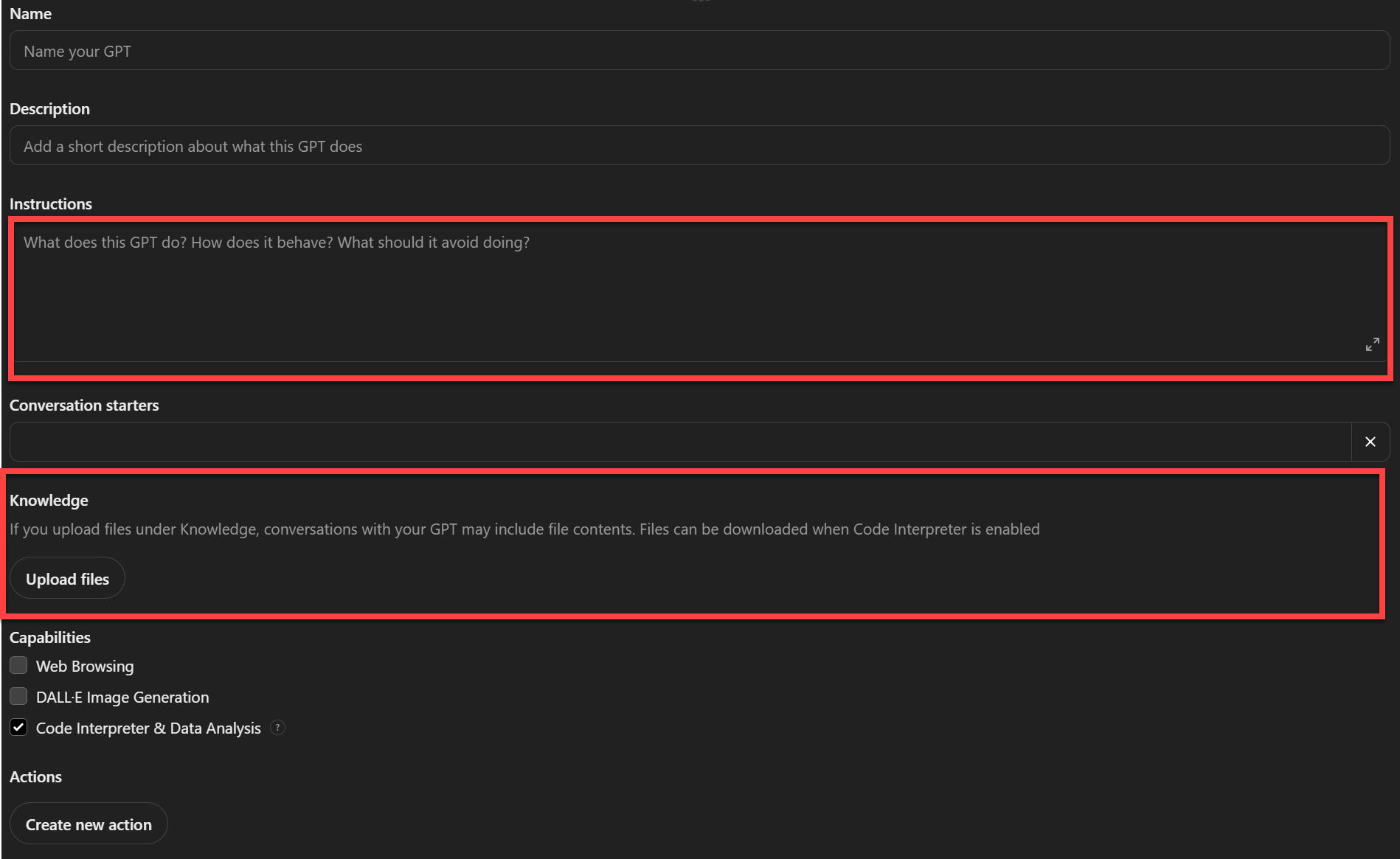
Note that the main areas are the Instructions and Knowledge. The Knowledge area is where content sources are uploaded in various ASCII formats. The Instructions area is where detailed instructions are included about what is expected of the model and how to use the sources. You can also select whether you would want the model to use the internet or use any other custom tool or function as part of this model. This is the case where “agents” that can accomplish specific tasks can augment an LLM’s generation capabilities. To keep the model grounded in the documentation content, I did not include web browsing in my model definition.
RAG models and sources
I created the very first version of the RAG model using only the OneFS ISI CLI Command Reference PDF as the source. It was amazing to see how well the resulting model came up with ISI commands, subcommands, and options available for each command and subcommand combination. This I realized is mostly due to how well the ISI CLI Command Reference documented the CLI functionality in a very structured 850+ pages! I extended this first version by adding the entire REST API Reference Guide (another 250+ pages) to see how well it could come up with REST API resources. This second version was also working well, although more prompting was required to make sure that it was using the latest API version in which a resource was available.
Encouraged by the initial results, I tried training the model using Ansible playbook examples for each of the modules like this. I then tried the RST files, which are also very well structured, for each of the modules. Even this was not very effective. I suspected the large number of files and the chunking and embedding may not be optimal for RST files. This is when I merged all the RST files into a single PDF (200+ pages) with some Python help. The resulting PDF was like a reference guide for the Ansible modules where all the parameters, return values, and other information was presented in a structured format and where it was more like a well tagged supervised learning example.
Ansible task blocks with REST API and ISI commands
For a given task request there may not be a PowerScale Ansible module. There are two workarounds for these situations: use the built-in URI module to make a REST API call or simply run the equivalent ISI CLI command (ISI is the popular CLI tool for OneFS) using the shell command module. Even though the latter is not great for error handling, I do use it in some cases with some error handling logic. For the code generation tool, in case there is no Ansible module for the requested task, I wanted the model to be able to do one of the following based on user input:
- Find the relevant ISI CLI command and wrap it in a shell command Ansible task. For the ISI CLI command retrieval, I provided the ISI CLI Command Reference PDF as the source. This is more than 850 pages. Turns out the model found the PDF super learnable. In fact, when I tested another custom GPT with just the CLI Command Reference, the results were great. The model spit out subcommands and options for any ISI command with precision.
- Find the relevant REST API call for the task and use Ansible’s builtin.uri module to wrap the API call to accomplish the task. The source here was the latest available REST API Reference Guide for PowerScale.
Model definition and instructions
Ok, now I have the source documents ready for the PowerScale-Ansible RAG. We are not done yet. In fact, specifying the “Instructions” to specify how exactly the model should function is the most important part. Here is what I provided:
Your role is to generate an Ansible task code block using the right Ansible module as per the request of the user. Attached is a PDF file that documents all of the dellemc.powerscale modules like dellemc.powerscale.ads, dellemc.powerscale.nfs, dellemc.powerscale.user etc. For each of the modules in the pdf there are separate sections for Synopsis, Requirements, Parameters, Notes, Examples and Return Values. When generating an Ansible task with one of the modules make sure you use the right module and with the right parameters needed. You can find examples of how each module can be used. Note that every task block needs to have the following details:
onefs_host: "{{onefs_host}}"
verify_ssl: "{{verify_ssl}}"
api_user: "{{api_user}}"
api_password: "{{api_password}}".It is possible that for a task requested by user there may not be an Ansible module. In such cases find the relevant ISI CLI command from the "isi cli reference.pdf" and create an ansible task by wrapping the ISI CLI command using an Ansible builtin "shell" module. Use the following format for such shell module tasks:
- name: event test create
delegate_to: "{{ onefs_host }}"
vars:
ansible_ssh_user: "{{ api_user }}"
ansible_ssh_pass: "{{ api_password }}"
shell: "isi event test create --message=\"Test Message, This is a new deployement\""For things related to isi cli, make sure you pick the right command, subcommand and options. for example "isi ntp" can be used for operations like "isi ntp servers list" and "isi ntp settings list".
If the user asks for Ansible tasks using REST API, generate task blocks using the ansible.builtin.uri module using the various GET/PUT/POST/DELETE methods on the appropriate OneFS API resource. All the resources can be found in the onefs-api-reference-en-us.pdf. Note that the api resources are organized as /platform/<version number>/<resource>/<sub resource>. Here are a few examples of a task using the ansible.builtin.uri :
- name: Create Alert Conditions
ansible.builtin.uri:
url: "https://{{ onefs_host }}:8080/platform/11/event/alert-conditions"
validate_certs: no
method: post
headers:
X-CSRF-Token: "{{ session.cookies.isicsrf }}"
Cookie: "isisessid={{ session.cookies.isisessid }}"
Referer: "https://{{ onefs_host }}:8080"
status_code: 200,201,400
body_format: json
body: |
{
"name": "SMTP - {{ item }}",
"condition": "{{ item }}",
"categories": [
"all"
],
"channels": [
"SMTP"
]
}
with_items:
- NEW
- RESOLVED
- SEVERITY INCREASE
tags: "alert-conditions"Another example:
- name: Enable Remote Support
ansible.builtin.uri:
url: "https://{{ onefs_host }}:8080/remote-service/11/esrs/status"
validate_certs: no
method: put
headers:
X-CSRF-Token: "{{ session.cookies.isicsrf }}"
Cookie: "isisessid={{ session.cookies.isisessid }}"
Referer: "https://{{ hostname }}:8080"
status_code: 200
body_format: json
body: |
{
"enabled": true
}
tags: "esrs-enable"Note the following Ansible tasks for OneFS API authentication:
- name: Get API Session Token
ansible.builtin.uri:
url: "https://{{ onefs_host }}:8080/session/1/session"
method: post
body_format: json
validate_certs: no
status_code: 200,201
body: |
{
"username": "{{ api_user }}",
"password": "{{ api_password }}",
"services": [
"platform", "remote-service", "namespace"
]
}
register: response
tags: "api"
- name: Setting PAPI Session Information
set_fact:
session:
cookies:
isisessid: "{{ response.cookies.isisessid }}"
isicsrf: "{{ response.cookies.isicsrf }}"
tags: "api"As you can imagine, I did not arrive at these long and detailed instructions in the very first attempt. I had to keep tweaking the instructions and examples to improve the accuracy of the output and reduce hallucinations that were a result of the base model’s original training data and inferencing capabilities.
Test cases
Arriving at a satisfactory RAG model involves iterating with document formats, tweaking instructions, and trying out different prompts. As you go through iterations, it is a good idea to have some test cases to test the many variants of a GPT to understand how the GPT is learning, when it hallucinates, and how to avoid hallucinations. Here is a collection of test cases:
Core functionality
The following are some test cases to see if the model works as expected:
- Generate an Ansible task to do particular operations using the PowerScale Ansible modules
- Generate Ansible tasks for cases where the right ISI CLI command for the task needs to be used with shell command delegation
- Generate Ansible tasks for cases where the right REST API call for the task needs to be used with builtin.uri module
Nice to have: for PowerScale users who know and love their CLI, it would be nice to generate the following Ansible task formats:
- ISI command to PowerScale module: Give an ISI CLI command and ask it to find if there is a PowerScale module available for it
- ISI command to REST API call: Give an ISI CLI command and generate a task with the equivalent REST API call
Testing for hallucinations
Here are the tests I used:
- Listing all available Ansible modules.
- This is a good test case to see if the RAG’s base model tries to come up with modules that sound as though they have very realistic names but are actually not retrieved from the sources provided.
- Listing all modules related to things like NFS Exports and SMB shares
- This test case is a similar to ‘Listing all available Ansible modules’ but is more specific. Here is where RAG models can hallucinate the same naming convention for module name for NFS and SMB, whereas the names of the PowerScale modules for NFS and SMB operations do not follow a tight convention and instead follow terminology like NFS Exports and SMB Shares for example.
- Listing available parameters for a given module
- This drills down further in terms of specificity and checks to see how well the model is using the sources.
Note that by no means do these tests represent an exhaustive list for this RAG model. These are just a few ways to see how well the retrieval is working.
Prompting to prevent hallucinations
The most effective prompting technique that worked for me is simply asking the model to cite the page numbers from the PDFs it referenced. This makes sure the generation process does not skip the content retrieval part and purely depends on its base model’s training and generative capabilities.
Final results
While it is not possible to present the test results in detail, I would like to share with you a few responses verbatim with an example I tried with the latest version of the RAG model that you can access here.

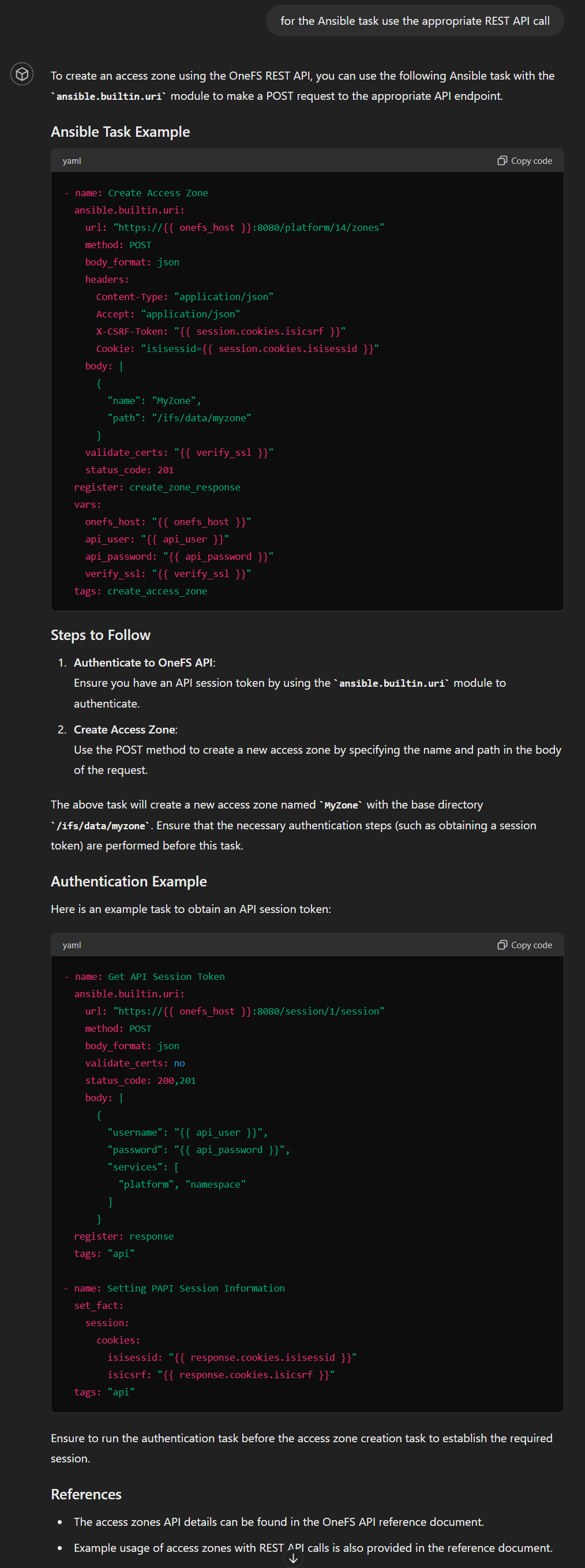
Ready for hallucination? I asked the model for an LDAP task, and it generated it using REST API even though there is an LDAP module:
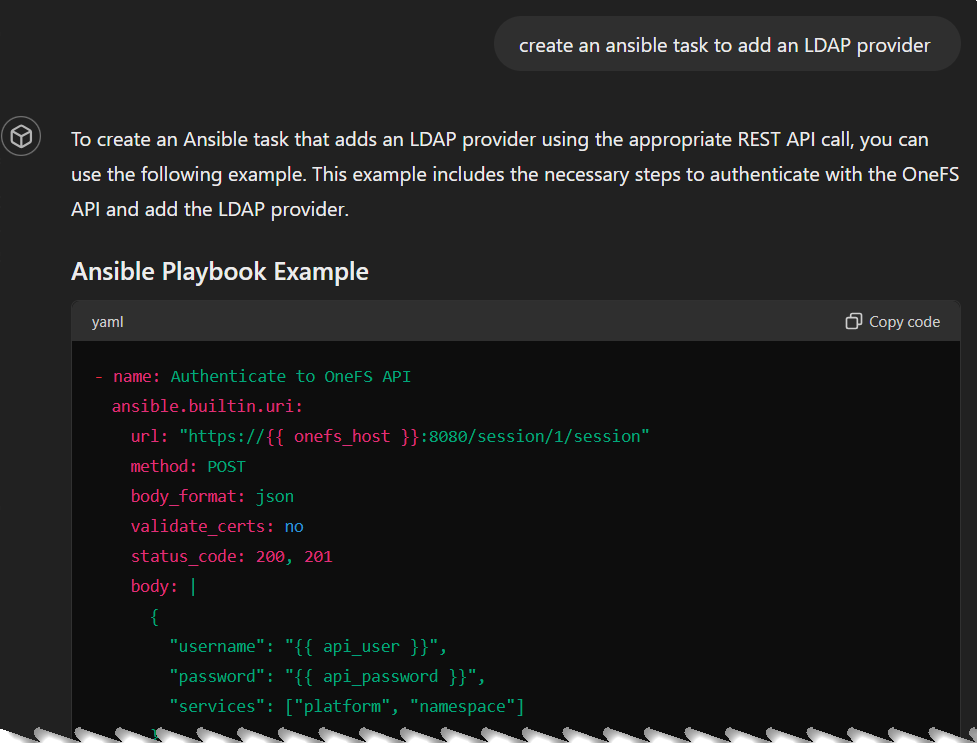
I prompted the model to use the module instead and it did find the right Ansible module:
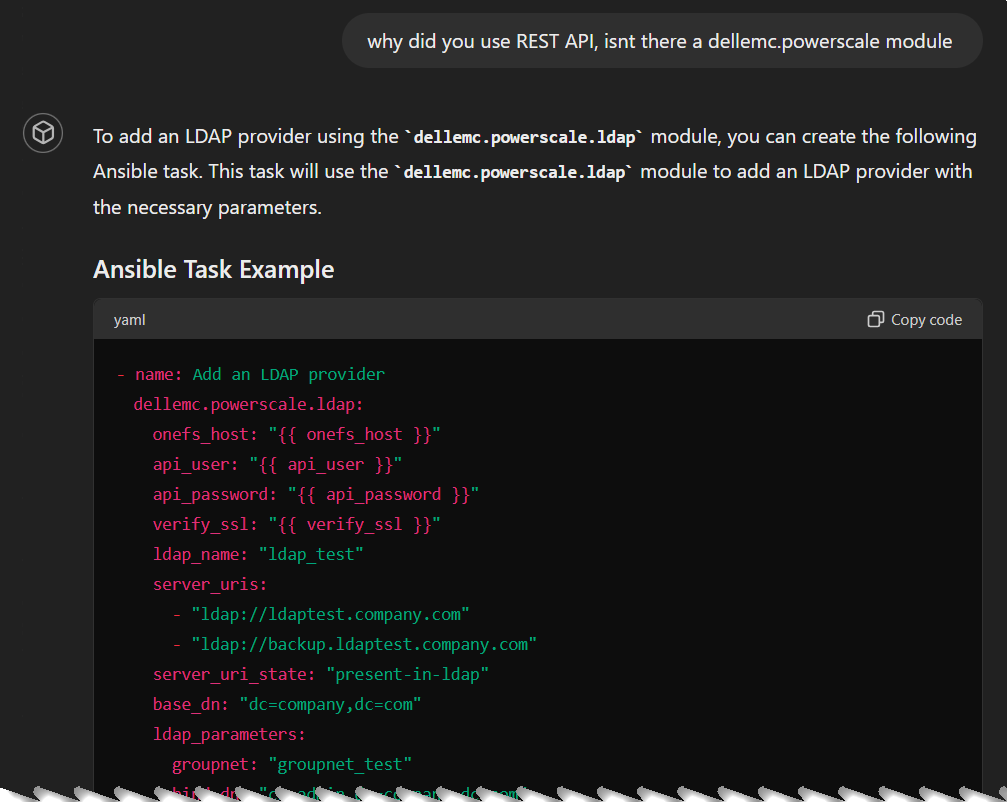
But thanks to this nudging it favored the Ansible module so much that it hallucinated with a non-existing module for the next prompt (Ansible task to enable S3 service):
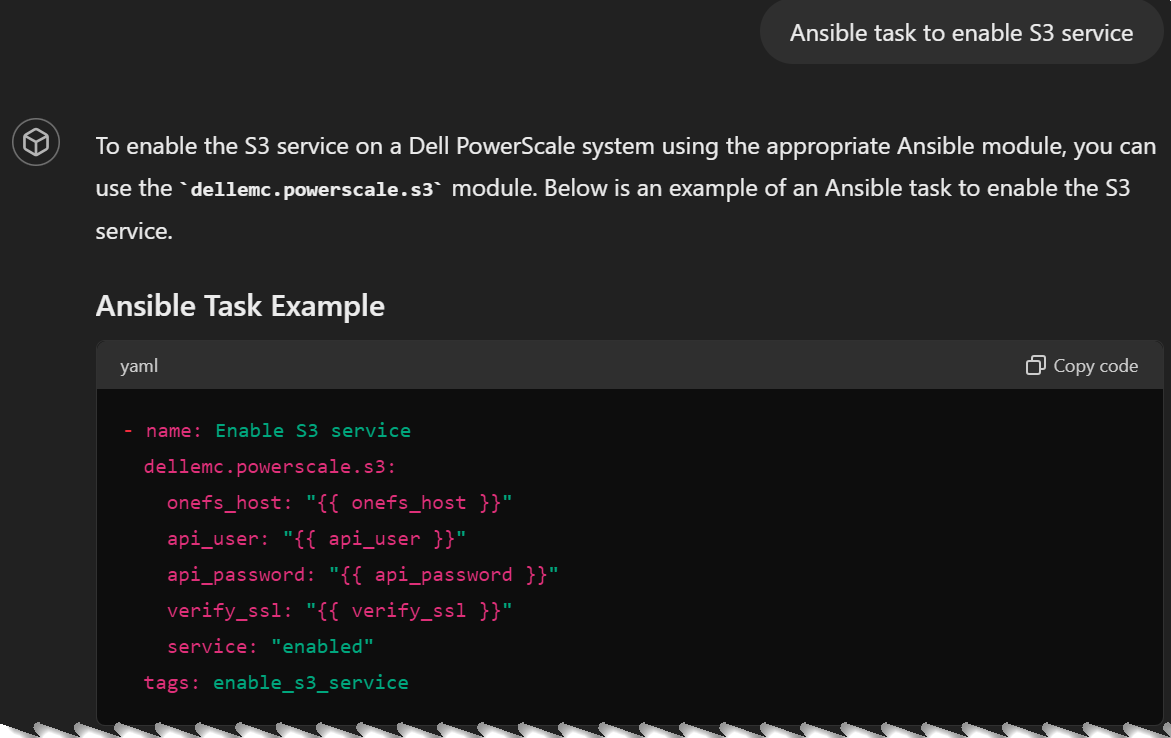
As I mentioned before, asking the model to cite documentation page numbers is an effective way to get around such hallucinations. This makes the model to take the RAG source path to answer the question, instead of using the core LLM. Here is how it corrected itself:
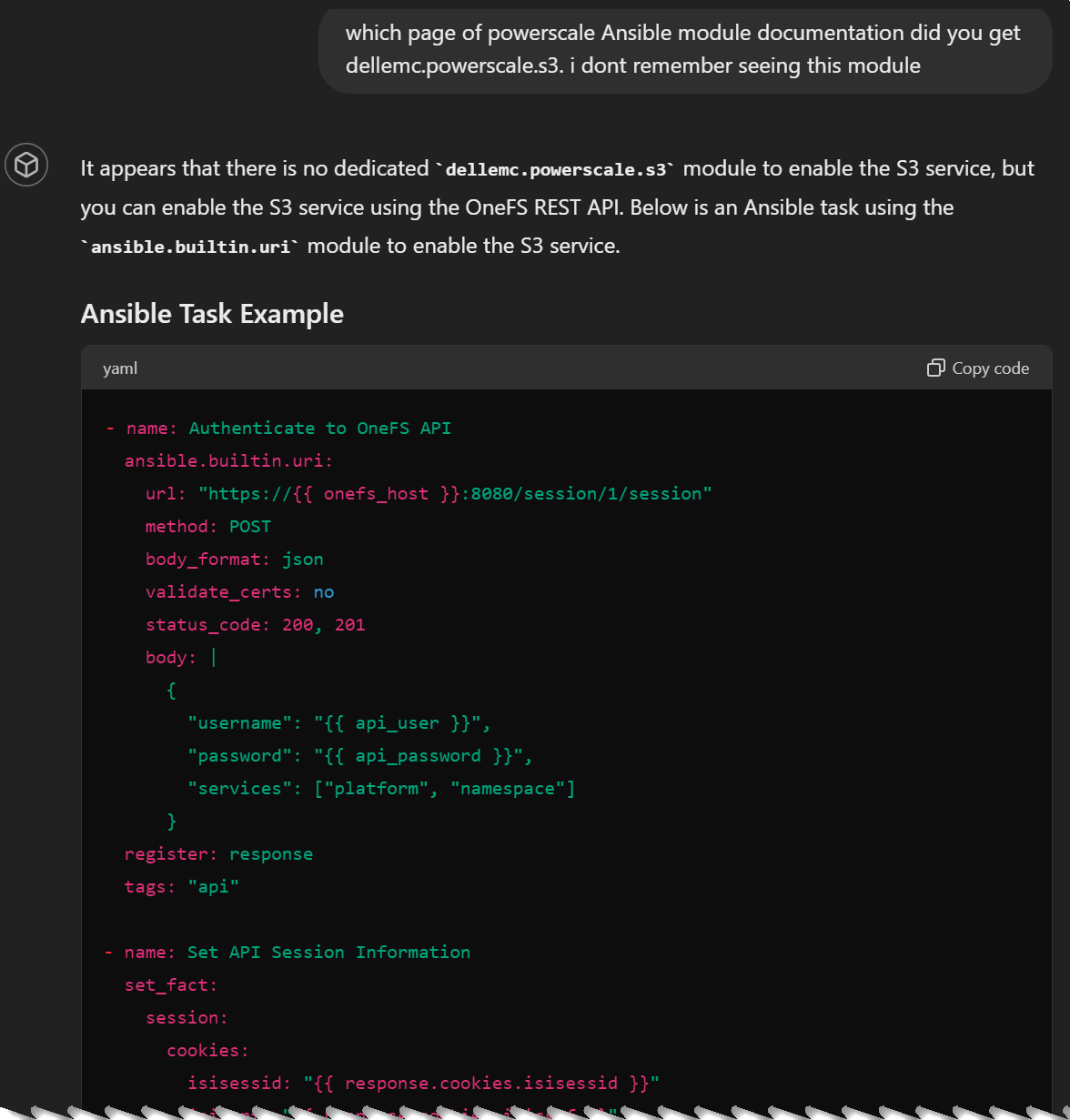
Clearly, I had a lot of fun training this RAG model using OneFS documentation. I encourage you to create your own RAG models to drastically improve code generation more than a typical code assistant tool can help with.
As with any Generative AI system, things are not always accurate, so we do need to do appropriate testing in non-production environments before we deploy them in production. Also note that most of the publicly available documentation has an implicit assumption of fair-use and may not include use cases of extensive commercial use or deriving monetary benefit from it, so check with your legal teams on these issues.
Author: Parasar Kodati, Engineering Technologist, Dell ISG

Q2 2024 Update for Ansible Integrations with Dell Infrastructure
Tue, 09 Jul 2024 15:13:10 -0000
|Read Time: 0 minutes
Here is a summary of what’s new in the Ansible collections for the Dell ISG portfolio:
- Ansible collection for PowerFlex: v2.4 and 2.5
- Ansible collection for PowerStore: v3.3 and 3.4
- Ansible collection for PowerScale: v2.4 and 2.5
Ansible collection for PowerFlex
Following are the enhancements that are part of Ansible collections for PowerFlex v2.4 and v2.5:
- Support for PowerFlex 4.6 (v2.5)
- Support for PowerFlex on AWS (v2.4)
- Storage pool module enhancements (v2.5)
Storage pool module enhancements
The Storage Pool module has been enhanced to support the following configuration attributes:
- Enable / disable zero padding - zero padding must be enabled before adding any devices to the storage
- Set replication journal capacity
- Enable / disable persistent checksum
- Modify persistent checksum
- Set capacity alert thresholds - high and critical threshold percentage
- Set protected maintenance mode I/O priority policy
- Set rebalance enabled
- Set rebalance I/O priority policy
- Set V-Tree migration I/O priority policy
- Set spare percentage
- Set RMcache write handling mode
- Enable/Disable rebuilds
- Set rebuild/rebalance parallelism
- Enable/Disable fragmentation
Here is how a storage pool configuration looks with the latest module:
- name: Create a new Storage pool
register: result
dellemc.powerflex.storagepool:
hostname: "{{ hostname }}"
username: "{{ username }}"
password: "{{ password }}"
validate_certs: "{{ validate_certs }}"
storage_pool_name: "{{ pool_name }}"
protection_domain_name: "{{ protection_domain_name }}"
cap_alert_thresholds:
high_threshold: 30
critical_threshold: 50
media_type: "TRANSITIONAL"
enable_zero_padding: true
rep_cap_max_ratio: 40
rmcache_write_handling_mode: "Passthrough"
spare_percentage: 80
enable_rebalance: false
enable_fragmentation: false
enable_rebuild: false
use_rmcache: true
use_rfcache: true
parallel_rebuild_rebalance_limit: 3
protected_maintenance_mode_io_priority_policy:
policy: "unlimited"
rebalance_io_priority_policy:
policy: "unlimited"
vtree_migration_io_priority_policy:
policy: "limitNumOfConcurrentIos"
concurrent_ios_per_device: 10
persistent_checksum:
enable: false
state: "present"Ansible collection for PowerStore
Dell PowerStore is the most modern storage array designed to handle diverse workloads with advanced data-centric capabilities. PowerStoreOS 4.0 introduces significant updates, including enhanced data efficiency with advanced compression algorithms, new PowerStore 3200Q with QLC drives for cost-effective storage, expanded networking capabilities, and improved data protection with Metro Volume support for Linux and Windows. It also offers native synchronous replication for block and file resources, easier migrations, and new features like system health scores, one-click updates, and dynamic node affinity for vVols. Enhanced security measures and improved serviceability are also part of this release. We have added Ansible module support for this release in PowerStore Ansible collections v3.3. In v3.4, the SMB Share module has been enhanced with support for access control lists (ACL) that are key to NAS file management.
SMB Share - support for ACL
The latest SMB Share module supports creation of a share with explicit ACL permissions. Here is an example:
- name: Create SMB share for a filesystem with ACL
dellemc.powerstore.smbshare:
array_ip: "{{ array_ip }}"
validate_certs: "{{ validate_certs }}"
user: "{{ user }}"
password: "{{ password }}"
share_name: "sample_smb_share"
filesystem: "sample_fs"
nas_server: "{{ nas_server_id }}"
path: "{{ path }}"
description: "Sample SMB share created"
is_abe_enabled: true
is_branch_cache_enabled: true
offline_availability: "DOCUMENTS"
is_continuous_availability_enabled: true
is_encryption_enabled: true
acl:
- access_level: "Full"
access_type: "Allow"
trustee_name: "TEST-56\\Guest"
trustee_type: "User"
state: "present"
- access_level: "Read"
access_type: "Deny"
trustee_name: "S-1-5-21-8-5-1-32"
trustee_type: "SID"
state: "present"
state: "present" Ansible collection for PowerScale
Following are the enhancements that are part of Ansible collections for PowerScale v3.1:
- New module dellemc.powerscale.support_assist to manage support assist settings on a PowerScale Storage System
- Support for the latest OneFS 9.8
- Updated Role module – Support to add a user or group to a role
- Updated SMB Module – Added support for running as root (run-as-root), along with other permission flags such as allow_delete_readonly, allow_execute_always, and inheritable_path_acl for an SMB Share
Support for Remote Support/Support Assist
Dell SupportAssist is the latest generation of call-home functionality of the legacy ESRS functionality. Starting OneFS 9.5, this new capability has been rolled out to PowerScale. To learn more, check out this blog post by my colleague, Nick Trimbee. A new module to configure SupportAssist is now available for PowerScale. Here is an example playbook with different tasks you can run and parameters you can configure:
--- - name: Support assist module operations on PowerScale Storage hosts: localhost connection: local vars: input: &powerscale_connection onefs_host: "10.XX.XX.XX" port_no: "8080" api_user: "user" api_password: "password" verify_ssl: false tasks: - name: Accept support assist terms dellemc.powerscale.support_assist: <<: *powerscale_connection accepted_terms: true - name: Get support assist settings dellemc.powerscale.support_assist: <<: *powerscale_connection register: support_assist_settings - name: Print support assist settings debug: var: support_assist_settings - name: Update support assist settings dellemc.powerscale.support_assist: <<: *powerscale_connection enable_download: false enable_remote_support: false automatic_case_creation: false connection: gateway_endpoints: - enabled: true gateway_host: "XX.XX.XX.XX" gateway_port: 9443 priority: 2 use_proxy: false validate_ssl: false network_pools: - pool_name: "subnet0:pool0" state: absent - pool_name: "subnet0:pool2" state: present contact: primary: first_name: "Eric" last_name: "Nam" email: "eric.nam@example.com" phone: "1234567890" secondary: first_name: "Daniel" last_name: "Kang" email: "kangD@example.com" phone: "1234567891" telemetry: offline_collection_period: 60 telemetry_enabled: true telemetry_persist: true telemetry_threads: 10
That’s it for Ansible in Q2 2024. Check out what’s new with Terraform providers for Dell infrastructure in this blog post.
Author: Parasar Kodati, Engineering Technologist, Dell ISG

Q2 2024 Update on Terraform Providers for Dell Infrastructure
Wed, 03 Jul 2024 16:22:05 -0000
|Read Time: 0 minutes
This post covers all the new Terraform resources and data sources that have been released in the last two quarters: Q4’23 and Q1 ‘24. You can check out previous releases of Terraform providers here: Q1-2023, Q2-2023 and Q3-2023. I also covered the first release of PowerScale provider here.
Following is a summary of the Dell Terraform Provider versions released over the last two quarters:
- First beta release of the new provider for Dell APEX Navigator for Multicloud storage! We covered this in full detail in this blog post.
- v1.3 and v1.4 of the provider for PowerScale
- v1.5 of the provider for PowerFlex
- v1.3 of the provider for Redfish
PowerScale provider v1.3 and v1.4
Following are the enhancements to the provider:
Support for OneFS 9.8 (v1.3)
OneFS 9.8 has a plethora of new functionality, including support for APEX File Storage on Azure. You can find a summary of all that is new in the release in this blog post by Nick Trimbee. Starting in v1.3, PowerScale Terraform provider supports OneFS 9.8.
New resource/data source: Roles (v1.3)
PowerScale Roles is part of the role-based-access-control available in Dell PowerScale. Roles in OneFS allow role definitions that are highly granular based on various user privileges. These privileges are named after the isi commands used to perform the actions. Check out this article to delve deeper into how the different privileges are mapped to the ISI commands. Here is an example ISI command to add some write privileges to a role:
isi auth roles modify StorageAdmin --add-group=isilonarrayadmins --add-priv-write=ISI_PRIV_ANTIVIRUS,ISI_PRIV_AUDIT,ISI_PRIV_AUTH,ISI_PRIV_CERTIFICATE
With the new Role resource and data source, you can create and manage OneFS Roles from Terraform. Here is how a resource can be declared:
resource "powerscale_role" "role_test" {
# Required
name = "role_test"
# Optional fields only for creating
zone = "System"
# Optional fields both for creating and updating
description = "role_test_description"
# To add members, the uid/gid is required. Please use user/user_group datasource to look up the uid/gid needed.
members = [
{
id = "UID:10"
},
{
id = "UID:0"
},
{
id = "GID:31"
}
]
# To add privileges, the id is required. Please use role privilege datasource to look up the role privilege id needed.
privileges = [
{
id = "ISI_PRIV_SYS_SUPPORT",
permission = "r"
},
{
id = "ISI_PRIV_SYS_SHUTDOWN",
permission = "r"
}
]
}New resource/data source: User Mapping Rules (v1.3)
OneFS supports mapping users to multiple identity directory service providers like Active Directory (AD) and other providers. For example, a user who authenticates with an Active Directory domain like Desktop\jane automatically receives identities for the corresponding UNIX user account for jane from LDAP or NIS. In the most common scenario, OneFS is connected to two directory services, Active Directory and LDAP. In such a case, the default mapping provides a user with a UID from LDAP and a SID from the default group in Active Directory. The user’s groups come from Active Directory and LDAP, with the LDAP groups added to the list. To pull groups from LDAP, the mapping service queries the memberUid. The user’s home directory, gecos, and shell come from Active Directory.
Here is an example of retrieving the mapped identities of a user across AD and LDAP using the ISI command line tool:
isi auth users view --user=york\\stand --show-groups Name: YORK\stand DN: CN=stand,CN=Users,DC=york,DC=hull,DC=example,DC=com DNS Domain: york.hull.example.com Domain: YORK Provider: lsa-activedirectory-provider:YORK.HULL.EXAMPLE.COM Sam Account Name: stand UID: 4326 SID: S-1-5-21-1195855716-1269722693-1240286574-591111 Primary Group ID : GID:1000000 Name : YORK\york_sh_udg Additional Groups: YORK\sd-york space group YORK\york_sh_udg YORK\sd-york-group YORK\sd-group YORK\domain users
Here is how the Unix LDAP mapping looks:
isi auth user view --user=stand --show-groups Name: stand DN: uid=stand,ou=People,dc=colorado4,dc=hull,dc=example,dc=com DNS Domain: - Domain: LDAP_USERS Provider: lsa-ldap-provider:Unix LDAP Sam Account Name: stand UID: 4326 SID: S-1-22-1-4326 Primary Group ID: GID: 7222 Name: stand Additional Groups: stand sd-group sd-group2
User mapping rules are created by combining operators with user names to create rules that override automatic mapping. Here is where you do this on OneFS Console:
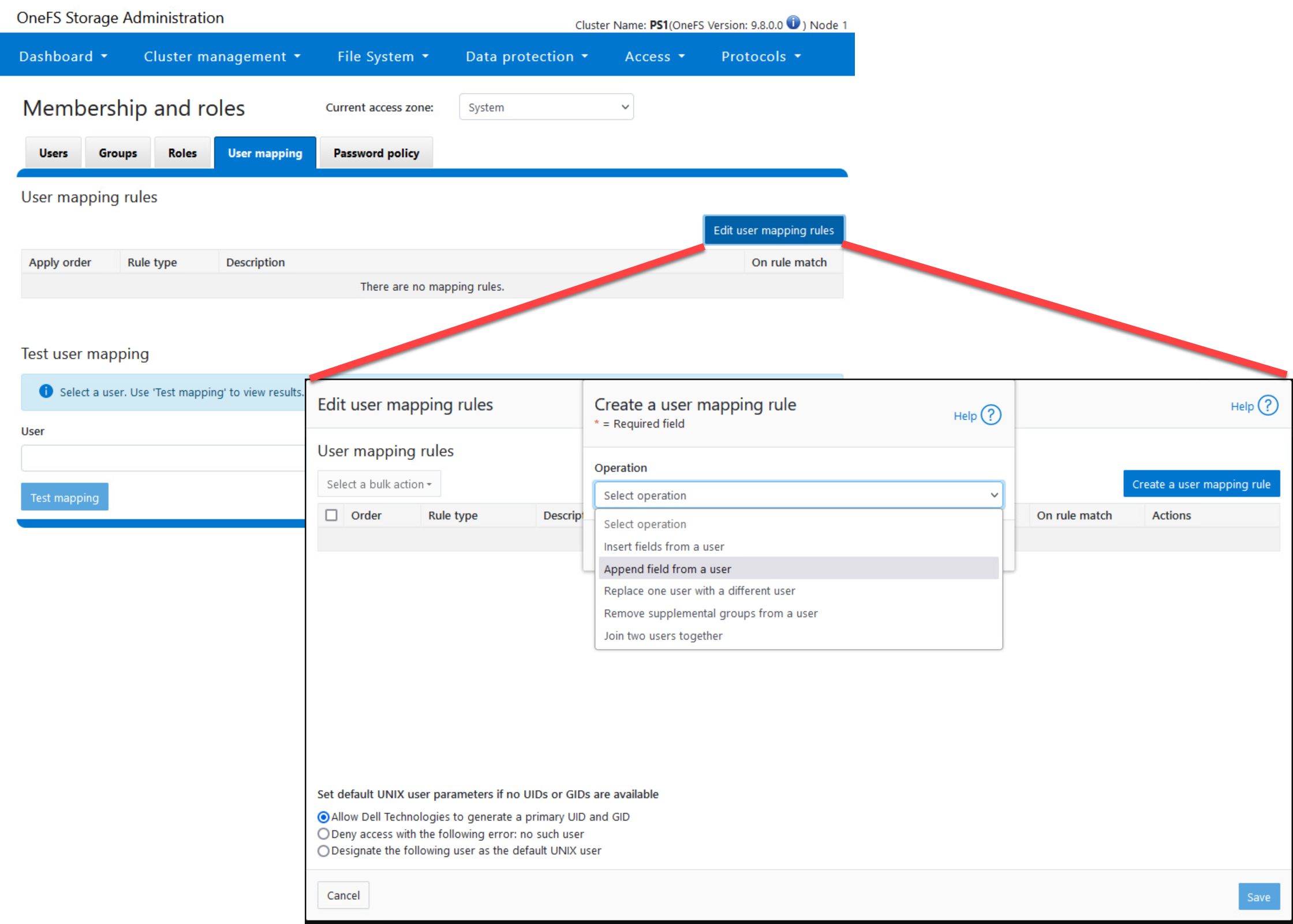
Here is how you can create explicit mapping rules using the Terraform provider:
resource "powerscale_user_mapping_rules" "testUserMappingRules" {
# Optional params for updating.
# The zone to which the user mapping applies. Defaults to System
zone = "System"
# Specifies the parameters for user mapping rules.
parameters = {
# Specifies the default UNIX user information that can be applied if the final credentials do not have valid UID and GID information.
# When default_unix_user is not null: Designate the user as the default UNIX user.
# When default_unix_user is null: Allow Dell Technologies to generate a primary UID and GID.
# When default_unix_user.user is " ": Deny access with the following error: no such user.
default_unix_user = {
# Specifies the domain of the user that is being mapped.
domain = "domain",
# Specifies the name of the user that is being mapped.
user = "username"
}
}
# Specifies the list of user mapping rules.
rules = [
{
# Specifies the operator to make rules on specified users or groups. Acceptable values: append, insert, replace, trim, union.
operator = "append",
# Specifies the mapping options for this user mapping rule.
options = {
# If true, and the rule was applied successfully, stop processing further.
break = true,
# Specifies the default user information that can be applied if the final credentials do not have valid UID and GID information.
default_user = {
# Specifies the domain of the user that is being mapped.
domain = "domain",
# Specifies the name of the user that is being mapped.
user = "Guest"
},
# If true, the primary GID and primary group SID should be copied to the existing credential.
group = true,
# If true, all additional identifiers should be copied to the existing credential.
groups = true,
# If true, the primary UID and primary user SID should be copied to the existing credential.
user = true
},
# Specifies the target user information that the rule can be applied to.
target_user = {
domain = "domain",
user = "testMappingRule"
},
# Specifies the source user information that the rule can be applied from.
source_user = {
domain = "domain",
user = "Guest"
}
},
]
}The “trim” operator-based mapping rule can be specified as follows:
{
# Operator 'trim' only accepts 'break' option and only accepts a single user.
operator = "trim",
options = {
break = true,
},
target_user = {
domain = "domain",
user = "testMappingRule"
}
}The “union” operator-based mapping rule can be specified as follows:
{
# Operator 'union' only accepts 'break' option.
operator = "union",
options = {
break = true,
default_user = {
domain = "domain",
user = "Guest"
},
},
target_user = {
user = "tfaccUserMappungRuleUser"
},
source_user = {
user = "admin"
}
},The “replace” operator-based mapping rule can be specified as:
{
# Operator 'replace' only accepts 'break' option.
operator = "replace",
options = {
break = true,
default_user = {
domain = "domain",
user = "Guest"
},
},
target_user = {
domain = "domain",
user = "tfaccUserMappungRuleUser"
},
source_user = {
domain = "domain",
user = "admin"
}
},New resources to configure NFS global settings zone settings
NFS Global Settings resource can be configured as follows:
resource "powerscale_nfs_global_settings" "example" {
# Optional fields both for creating and updating
# nfsv3_enabled = true
# nfsv3_rdma_enabled = false
# nfsv4_enabled = false
# rpc_maxthreads = 16
# rpc_minthreads = 16
# rquota_enabled = false
# service = true
}NFS Settings for a particular zone can be configured using the nfs_zone_settings:
resource "powerscale_nfs_zone_settings" "example" {
# Required field both for creating and updating
zone = "tfaccAccessZone"
# Optional fields both for creating and updating
# nfsv4_no_names = false
# nfsv4_replace_domain = true
# nfsv4_allow_numeric_ids = true
# nfsv4_domain = "localdomain_tfaccAZ"
# nfsv4_no_domain = false
# nfsv4_no_domain_uids = true
}New resource to configure SMB Server Settings (v1.4)
Following is how this settings resource can be configured:
resource "powerscale_smb_server_settings" "example" {
# Optional fields both for creating and updating
scope = "effective"
# access_based_share_enum = false
# dot_snap_accessible_child = true
# dot_snap_accessible_root = true
# dot_snap_visible_child = false
# dot_snap_visible_root = true
# enable_security_signatures = false
# guest_user = "nobody"
# ignore_eas = false
# onefs_cpu_multiplier = 4
# onefs_num_workers = 0
# reject_unencrypted_access = true
# require_security_signatures = false
# server_side_copy = true
# server_string = "PowerScale Server"
# service = true
# support_multichannel = true
# support_netbios = false
# support_smb2 = true
# support_smb3_encryption = false
}New resource/data source: S3 Bucket (v1.4)
OneFS provides S3-compatible access to data. The new S3_bucket resource is how you create and manage S3 buckets and apply access control permissions to them in OneFS:
resource "powerscale_s3_bucket" "s3_bucket_example" {
# Required attributes and update not supported
name = "s3-bucket-example"
path = "/ifs/s3_bucket_example"
# Optional attributes and update not supported,
# Their default value shows as below if not provided during creation
# create_path = false
# owner = "root"
# zone = "System"
# Optional attributes, can be updated
#
# By default acl is an empty list. To add an acl item, both grantee and permission are required.
# Accepted values for permission are: READ, WRITE, READ_ACP, WRITE_ACP, FULL_CONTROL
# acl = [{
# grantee = {
# name = "root"
# type = "user"
# }
# permission = "FULL_CONTROL"
# }]
#
# By default description is empty
# description = ""
#
# Accepted values for object_acl_policy are: replace, deny.
# The default value would be replace if unset.
# object_acl_policy = "replace"
}New resource/data source: Namespace ACL Management
OneFS provides a single namespace for multiprotocol access and has its own internal ACL (Access Control Lists) representation to perform access control. The internal ACL is presented as protocol-specific views of permissions so that NFS exports display POSIX mode bits for NFSv3 and show ACL for NFSv4 and SMB.
You can use the Namespace ACL to create and manage ACLs for a given namespace:
resource "powerscale_namespace_acl" "example_namespace_acl" {
# Required and immutable once set
namespace = "ifs/example"
# # Optional query parameters
# nsaccess = true
#
# # Optional fields both for creating and updating
# # For owner and group, please provide either the UID/GID or the name+type
# owner = {
# id = "UID:0"
# }
# group = {
# name = "Isilon Users",
# type = "group"
# }
#
# # acl_custom is required for updating. It can be set to [] to remove all acl.
# # While creating, if owner or group is provided, acl_custom must be specified as well. If none of
# # the three parameters are provided, Terraform will load the settings from the array directly.
# # For trustee, please provide either the UID/GID or the name+type
# # Please notice, the field acl_custom is the raw configuration, PowerScale will identify and calculate the accessrights
# # and inherit_flags provided and return its effective settings, which will be represented in the field acl in state.
# acl_custom = [
# {
# accessrights = ["dir_gen_all"]
# accesstype = "allow"
# inherit_flags = ["container_inherit"]
# trustee = {
# id = "UID:0"
# }
# },
# {
# accessrights = ["dir_gen_write", "dir_gen_read", "dir_gen_execute", "std_read_dac"]
# accesstype = "allow"
# inherit_flags = ["container_inherit"]
# trustee = {
# name = "Isilon Users",
# type = "group"
# }
# },
# ]
}PowerFlex Provider v1.5
Following are the enhancements to the provider:
- Support for PowerFlex 4.6
- Support for the provider on AWS
- Support for Restricted Mode
- Support for comma separated values in all possible fields of CSV
- Resource 'powerflex_service' renamed to 'powerflex_resource_group'
Support for SDC deployment for Windows and ESXi OS
SDC Host Configuration for an ESXi host looks as follows with the os_family attribute set to “esxi”:
resource "powerflex_sdc_host" "sdc" {
ip = "10.10.10.10"
remote = {
user = "root"
# we are not using password auth here, but it can be used as well
# password = "W0uldntUWannaKn0w!"
private_key = data.local_sensitive_file.ssh_key.content_base64
host_key = data.local_sensitive_file.host_key.content_base64
}
os_family = "esxi"
esxi = {
guid = random_uuid.sdc_guid.result
drv_cfg_path = "/root/terraform-provider-powerflex/drv_cfg-3.6.500.106-esx7.x"
}
name = "sdc-esxi"
package_path = "/root/terraform-provider-powerflex/sdc-3.6.500.106-esx7.x.zip"
mdm_ips = ["10.10.10.5", "10.10.10.6"]
}SDC Host Configuration for a Linux host looks as follows with the os_family attribute set to “linux”:
resource powerflex_sdc_host sdc {
depends_on = [ terraform_data.ubuntu_scini ]
ip = "10.225.110.40"
remote = { user = "root”
private_key = data.local_sensitive_file.ssh_key.content_base64
certificate = data.local_sensitive_file.ssh_cert.content_base64
}
os_family = "linux"
name = "sdc-linux2"
package_path = terraform_data.sdc_pkg.output.local_pkg
mdm_ips = ["10.247.100.214", "10.247.66.67"]
}SDC Host Configuration for a Windows host looks as follows with the os_family attribute set to “windows”:
resource "powerflex_sdc_host" "sdc_windows" {
ip = "10.10.10.10"
remote = {
user = "username"
password = "password"
port = 5985
}
os_family = "windows"
name = "sdc-windows"
package_path = "/root/terraform-provider-powerflex/EMC-ScaleIO-sdc-3.6-200.105.msi"
# mdm_ips = ["10.10.10.5", "10.10.10.6"] # Optional
}Redfish Provider v1.3
Following are the enhancements to the provider:
Server configuration profile support
When onboarding a new server or repurposing an existing, the systems admin looks for a standard configuration profile that can be applied to the server before deploying workloads on it. Server configuration profiles can be exported from a machine to a remote location and can be imported from a remote location to a local server. Here is the resource to export a profile:
resource "redfish_idrac_server_configuration_profile_export" "share_type_local" {
for_each = var.rack1
redfish_server {
user = each.value.user
password = each.value.password
endpoint = each.value.endpoint
ssl_insecure = each.value.ssl_insecure
}
share_parameters = {
filename = "demo_local.xml"
target = ["NIC"]
share_type = "LOCAL"
}
lifecycle {
replace_triggered_by = [terraform_data.trigger_by_timestamp]
}
}iDRAC supports multiple export types. Following are the variants for the share parameters of the resource for NFS, CIFS, HTTPS, and HTTP cases:
share_parameters = {
filename = "demo_nfs.xml"
target = ["NIC"]
share_type = "NFS"
ip_address = "10.0.0.01"
share_name = "/dell/terraform-idrac-nfs"
}share_parameters = {
filename = "demo_cifs.xml"
target = ["NIC"]
share_type = "CIFS"
ip_address = "10.0.0.02"
share_name = "/dell/terraform-idrac-nfs"
username = var.cifs_username
password = var.cifs_password
}share_parameters = {
filename = "demo_https.xml"
target = ["NIC"]
share_type = "HTTPS"
ip_address = "10.0.0.03"
port_number = 443
}share_parameters = {
filename = "demo_http.xml"
target = ["NIC"]
share_type = "HTTP"
ip_address = "10.0.0.04"
port_number = 80
proxy_support = true
proxy_server = "10.0.0.05"
proxy_port = 5000
}The import resource is almost identical to the export resource. You can find a more detailed note on these new resources here.
User Account Password resource enhancements
Here is how the new resource can be used to change user passwords:
resource "redfish_user_account_password" "root" {
username = "root"
endpoint = "https://my-server-1.myawesomecompany.org"
ssl_insecure = false
old_password = "Test@1234"
new_password = "Root@1234"
}Resources
Here are the link sets for key resources for each of the Dell Terraform providers:
Provider for PowerScale
Provider for PowerFlex
Provider for PowerStore
Provider for Redfish
Provider for APEX Navigator
Author: Parasar Kodati, Engineering Technologist, Dell ISG

Introducing Terraform Provider for Dell APEX Navigator for Multicloud Storage
Tue, 02 Jul 2024 17:22:03 -0000
|Read Time: 0 minutes
We are excited to announce the beta-availability of the new Terraform provider for Dell APEX Navigator for Multicloud Storage. APEX Navigator for Multicloud Storage drastically simplifies multicloud storage deployment and data management. With the new Terraform provider, we are bringing the power of Terraform cloud deployments to APEX Navigator workflows.
APEX Navigator Terraform provider overview
You can find the provider on the Terraform registry. Following is the provider declaration:
terraform {
required_providers {
apex = {
source = "dell/apex"
}
}
}
provider "apex" {
host = var.HOST
jms_endpoint = var.JMS_ENDPOINT
}Where the variables are defined as follows:
variable "HOST" {
type = string
default = "https://apex.apis.dell.com/apex"
}
variable "JMS_ENDPOINT" {
type = string
default = "https://apex.apis.dell.com/apex"
}Following are the resources available in this version of the provider:
- AWS Account
- AWS Trust Policy Generate
- Block Storage
- Block Mobility Groups
- Block Mobility Groups Copy
- Block Mobility Targets
- Block Clones
- Block Clones Map
- Block Clones Refresh
- Block Clones Unmap
- File Storage
Following are the data sources:
- AWS Accounts
- AWS Permissions
- Storages
- Block Clones
- Block Hosts
- Block Mobility Groups
- Block Mobility Targets
- Block Pools
- Storage Products
- Block Volumes
Let’s delve into the different workflows of Dell APEX Navigator for Multicloud Storage and see how you can begin automating with Terraform.
Initial setup
To get started with Dell APEX Navigator for Multicloud Storage, add a cloud account that will be used for storage deployment. This is where the AWS Account resource is used to specify the details of your AWS Cloud account:
resource "apex_navigator_aws_account" "example" {
# AWS account ID
account_id = "123456789123"
# AWS role ARN
role_arn = "arn:aws:iam::123456789123:role/example-role-rn"
}Once you have added an AWS account, establish trust between the AWS account and the APEX Navigator by using the “AWS Trust Policy Generate” resource:
resource "terraform_data" "always_run_generate_trust_policy" {
input = timestamp()
}
resource "apex_navigator_aws_trust_policy_generate" "example" {
# AWS account ID
account_id = "123456789123"
// This will allow terraform create process to trigger each time we run terraform apply.
// Each time we apply we want to generate a new trust policy.
lifecycle {
replace_triggered_by = [
terraform_data.always_run_generate_trust_policy
]
}
}Storage deployment
Block storage deployment
You can deploy Block or File storage with your AWS account. Here is a typical topology of an APEX Block deployment: 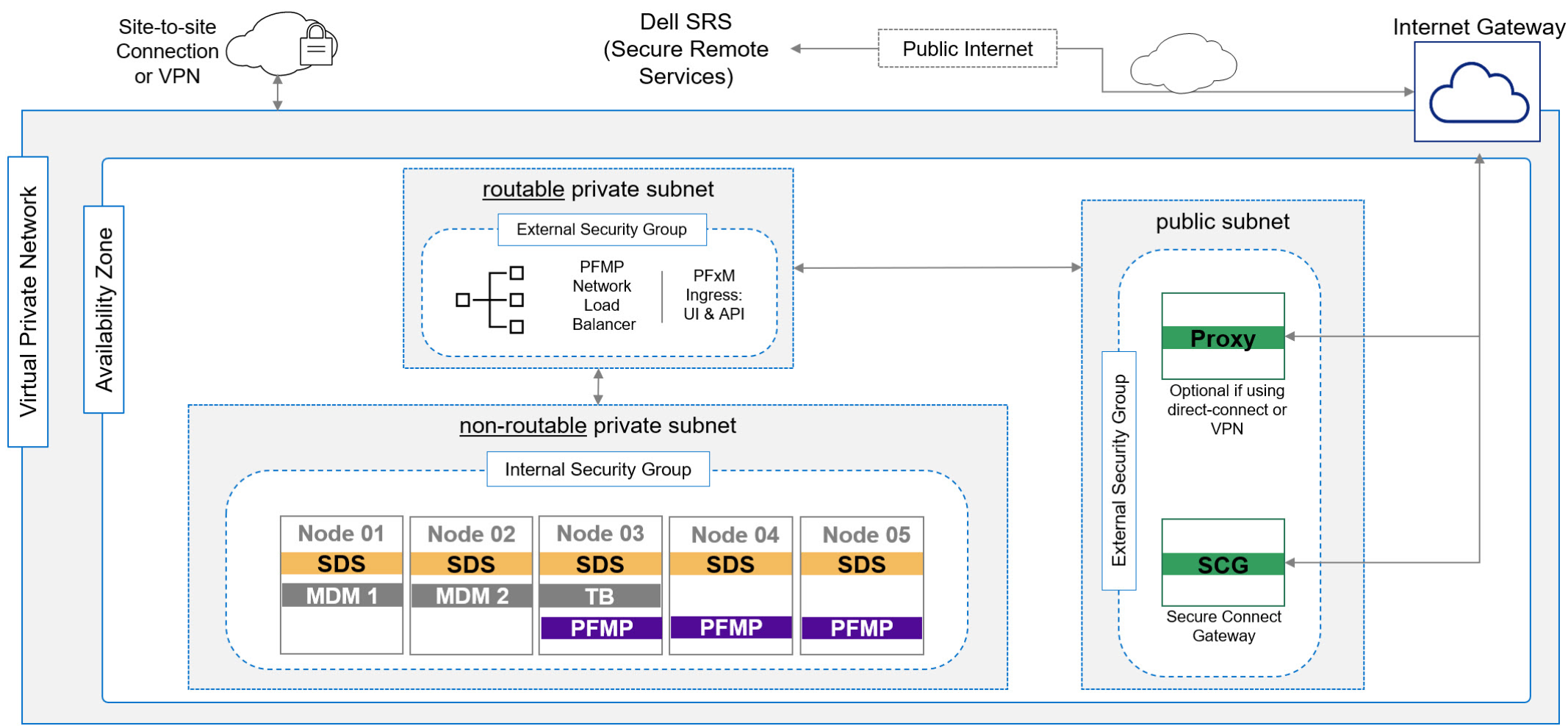
Figure 1. APEX Block Storage deployment on AWS where all the node instances and subnets are automatically deployed by APEX Navigator for Multicloud Storage
There are two subnets within the availability zone: the public subnet for the access end point and the actual block storage nodes that are part of a private subnet. Following is the form on the APEX Navigator UI to define an APEX Block deployment:
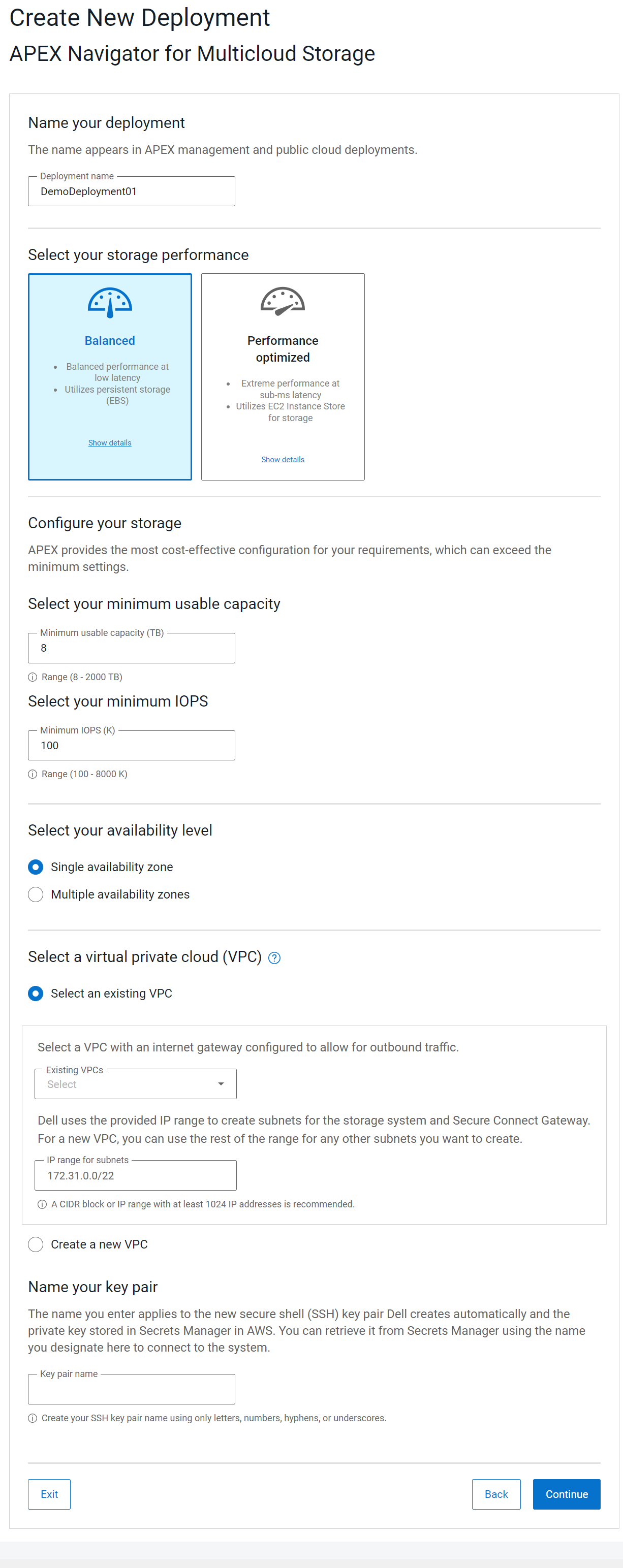
Figure 2. APEX Navigator for Multicloud Storage UI form to deploy block storage
In Terraform, you can use the Block storage resource as follows:
resource "apex_navigator_block_storage" "cloud_instance" {
# Type of system you want to deploy
storage_system_type = "POWERFLEX"
# The name of the system.
name = "apex-navigator-terraform"
product_version = "4.5.1"
deployment_details = {
system_public_cloud = {
deployment_type = "PUBLIC_CLOUD"
cloud_type = "AWS"
cloud_account = "123456789012"
cloud_region = "us-east-1"
availability_zone_topology = "SINGLE_AVAILABILITY_ZONE"
minimum_iops = "100"
minimum_capacity = "8"
tier_type = "BALANCED"
ssh_key_name = "apex-navigator-terraform-key"
vpc = {
is_new_vpc = false
vpc_id = "vpc-12345678901234567"
# vpc_name = "my-vpc"
}
subnet_options = [
{
subnet_id = "subnet-12345678901234567"
#cidr_block = "30.0.8.0/22"
subnet_type = "EXTERNAL"
},
{
#subnet_id = "subnet-2"
cidr_block = "10.0.16.0/21"
subnet_type = "INTERNAL"
}
]
}
}
# Note: PowerFlex credentials are required to activate the system for block storage related operations.
# This is only required when decomissioning the system
powerflex {
username = "example-user"
password = "example-password"
}
}File storage deployment
For File storage, a typical topology would look like this:
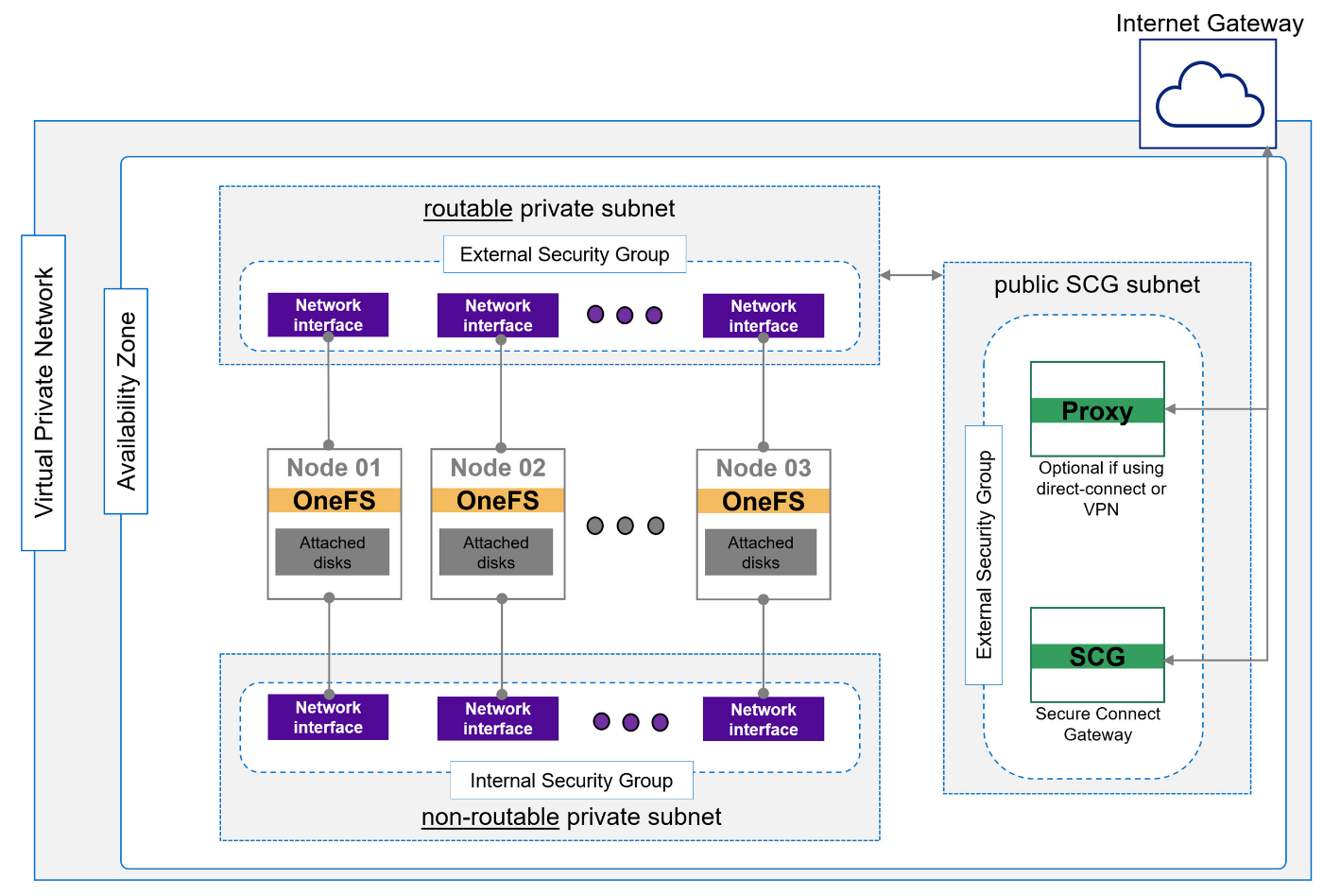
Figure 3. APEX File Storage deployment on AWS where all the node instances and subnets are automatically deployed by APEX Navigator for Multicloud Storage
Once again, there are two subnets: a public subnet to access the storage service and the actual storage nodes in a private subnet.
On the APEX Navigator UI, the following is how a deployment is specified. This example is APEX File:
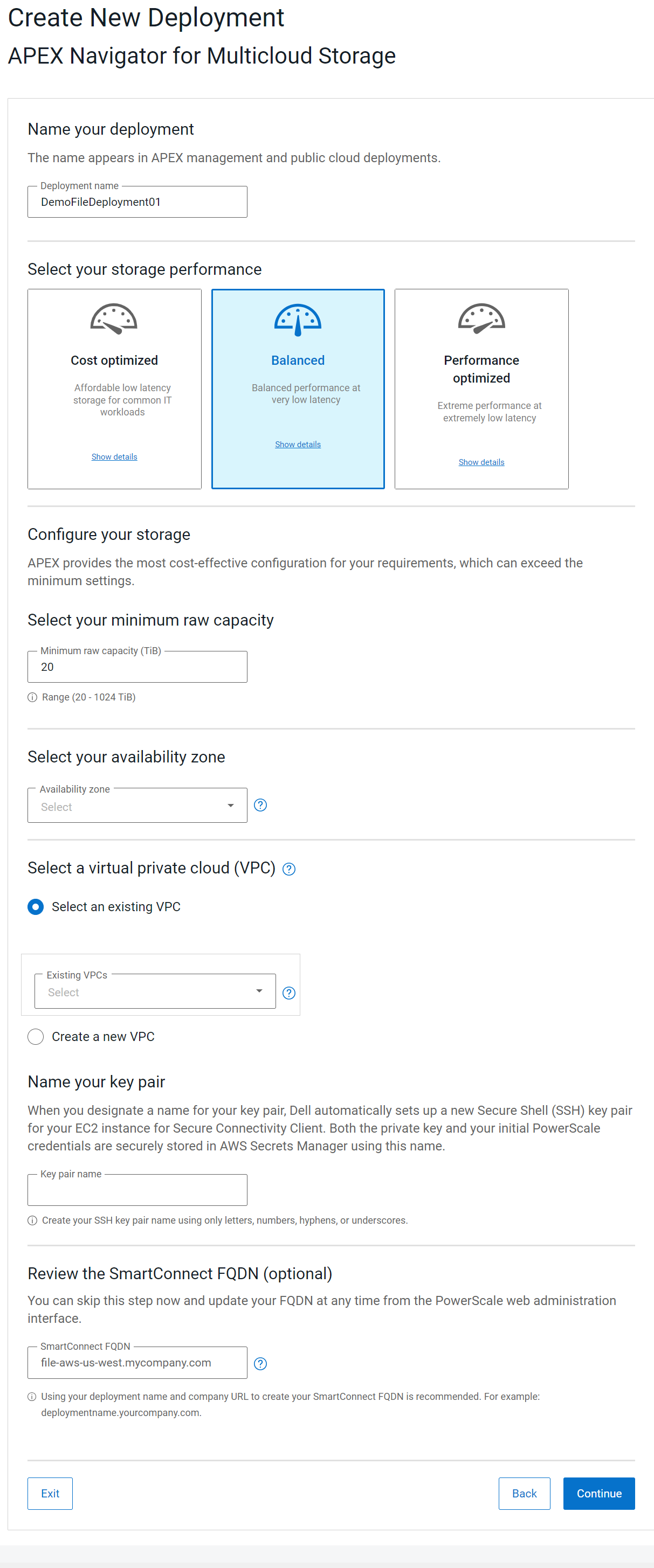
Figure 4. APEX Navigator for Multicloud Storage UI form to deploy File storage
In Terraform, you can use the following File storage resource, which shares a lot of the attributes with Block storage:
resource "apex_navigator_file_storage" "cloud_instance" {
# Type of system you want to deploy
storage_system_type = "POWERSCALE"
# The name of the system.
name = "apex-navigator-terraform-file"
product_version = "9.8"
# deployment_details (can be either system_on_prem or system_public_cloud)
deployment_details = {
system_public_cloud = {
deployment_type = "PUBLIC_CLOUD"
cloud_type = "AWS"
cloud_account = "012345678901"
cloud_region = "us-east-1"
availability_zone_topology = "SINGLE_AVAILABILITY_ZONE"
raw_capacity = "20"
tier_type = "BALANCED"
iam_instance_profile = "IAMProfileTest"
ssh_key_name = "apex-navigator-terraform-key"
vpc = {
is_new_vpc = false
vpc_id = "vpc-12345678901234567"
}
availability_zones = ["us-east-1a"] #Use for new VPC
subnet_options = [
{
subnet_id = "subnet-12345678901234567"
subnet_type = "EXTERNAL"
},
{
subnet_id = "subnet-12345678901234567"
subnet_type = "INTERNAL"
},
{
subnet_id = "subnet-12345678901234567"
subnet_type = "SCG"
}
]
}
}
}Data mobility
APEX Navigator for Multicloud Storage provides the ability to easily move data between Dell storage instances across multiple cloud environments.
Here are the steps involved in Block data mobility to a cloud target:
- Create or select a mobility group with the set of volumes you would like to replicate
- Select a Target mobility group for the data copy
- Initiate a mobility job that creates a copy
- Create a mountable clone of the target copy
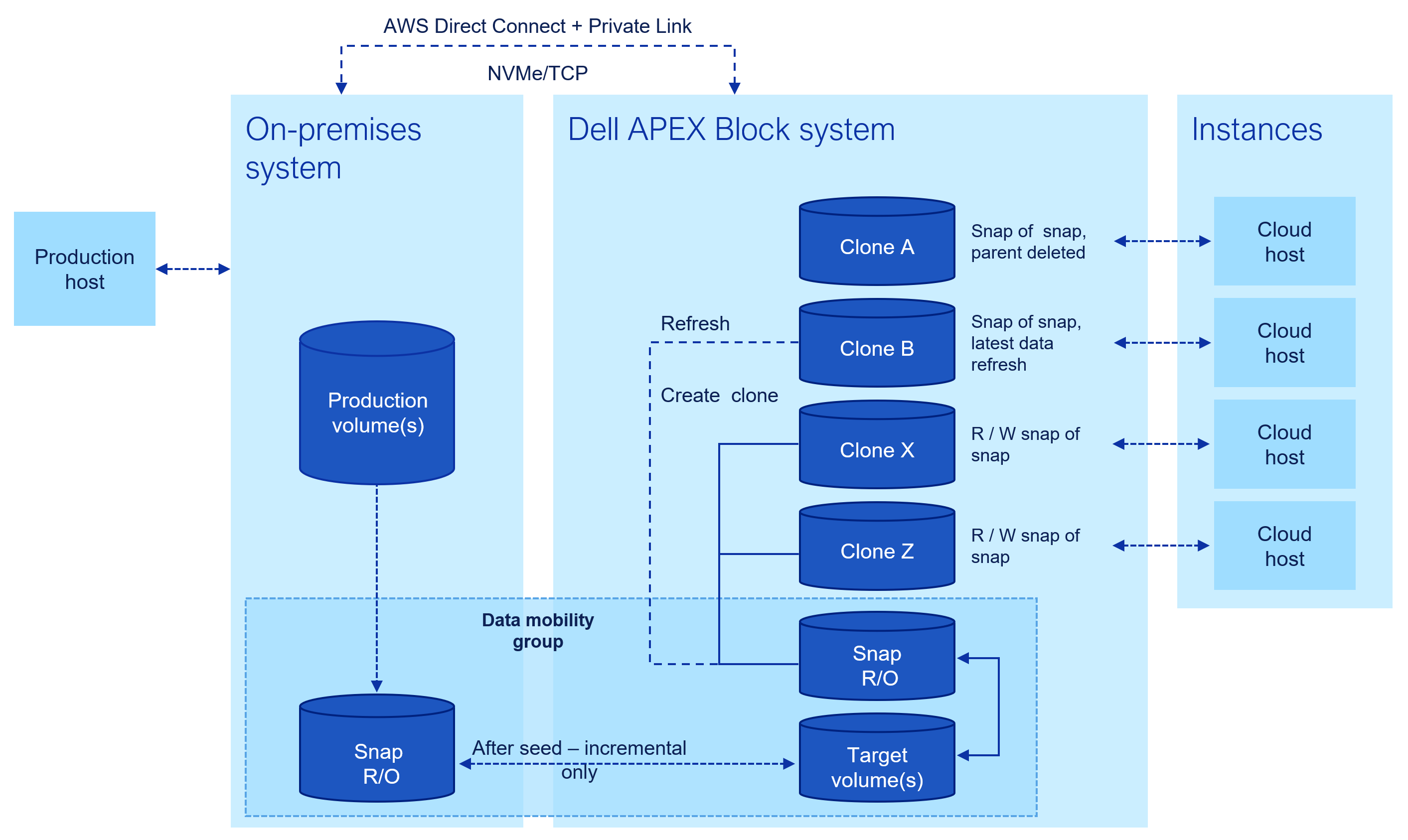
Figure 5. Schematic showing snap-based copy provisioning for cloud workloads
Source and target mobility groups
The new Terraform provider for APEX Navigator provides the resources to create and manage block mobility groups. Following is an example of how you can group volumes of a source storage system that need to be part of a mobility group:
resource "apex_navigator_block_mobility_groups" "example" {
# Name of the Mobility Group source
name = "TerraformMobilityGroup"
# ID of the target system
system_id = "POWERFLEX-ABCD1234567890"
# Type of the target system
system_type = "POWERFLEX"
# IDs of the volumes you want to add to the group
volume_id = [
"POWERFLEX-ABCD1234567890__VOLUME__1234567890123456",
"POWERFLEX-ABCD1234567890__VOLUME__1234567890123456"
]
# Note: PowerFlex credentials are required to activate the system for mobility related operations.
powerflex {
username = "example-user"
password = "example-pass"
insecure = true
}
}We then set up a mobility target using the Block Mobility Target resource as follows:
resource "apex_navigator_block_mobility_targets" "example" {
# Name of the Mobility target
name = "TerraformMobilityTarget"
# Source Mobility Group Id
source_mobility_group_id = "POWERFLEX-ABCD1234567890__DATAMOBILITYGROUP__12345678-1234-1234-1234-123456789012"
# Target System Id
system_id = "POWERFLEX-ABCD1234567890"
# Target System Type
system_type = "POWERFLEX"
# Storage pool id to use for allocating target volumes
target_system_options = "POWERFLEX-ABCD1234567890_STORAGE_POOL__1234567890123456"
# Note: PowerFlex credentials are required to activate the system for mobility related operations.
# The source mobility group Powerflex
powerflex_source {
username = "example-source-username"
password = "example-source-pass"
}
# The Powerflex where you want to create the target
powerflex_target {
username = "example-target-username"
password = "example-target-pass"
}
}Data mobility in batch mode
To replicate the mobility group to the target destination, we use the Mobility Groups Copy resource as follows:
resource "terraform_data" "always_run_mobility_groups_copy" {
input = timestamp()
}
resource "apex_navigator_block_mobility_groups_copy" "example" {
for_each = var.mobility_group
mobility_source_id = each.value.mobility_source_id
mobility_target_id = each.value.mobility_target_id
# Note: PowerFlex credentials are required to activate the system for mobility related operations.
powerflex_source {
username = each.value.powerflex_source_user
password = each.value.powerflex_source_password
host = each.value.powerflex_source_host
insecure = each.value.insecure
}
powerflex_target {
username = each.value.powerflex_target_user
password = each.value.powerflex_target_password
host = each.value.powerflex_target_host
insecure = each.value.insecure
}
// This will allow terraform create process to trigger each time we run terraform apply.
lifecycle {
replace_triggered_by = [
terraform_data.always_run_mobility_groups_copy
]
}
}Note that you can specify multiple sources and targets so that you can run multiple mobility or copy jobs at once. Following is how can specify the mobility_group variable that can have multiple sources and targets:
mobility_group = {
"group-1" = {
powerflex_source_user = "source_user"
powerflex_source_password = "source_pass"
powerflex_target_user = "target_user"
powerflex_target_password = "target_pass"
insecure = true
mobility_source_id = "source-id-example-1"
mobility_target_id = "target-id-example-2"
},
"group-2" = {
powerflex_source_user = "source_user"
powerflex_source_password = "source_pass"
powerflex_target_user = "target_user"
powerflex_target_password = "target_pass"
insecure = true
mobility_source_id = "source-id-example-2"
mobility_target_id = "target-id-example-2"
},
}Ways to control the snap copy refresh
In the “mobility groups copy” resource configuration, note that we are using the lifecycle block to specify that the copy resource needs to be replaced when there is a change in the referenced resource, “terraform_data.always_run_mobility_groups_copy”. If you look at the “terraform_data.always_run_mobility_groups_copy”, it is simply the time stamp. Given that every apply execution has a unique timestamp, this ensures that the copy job is triggered for every execution. This prompts Terraform to start the copy job afresh in every apply, which refreshes the snapshot copy on the target storage system.
Clones
The next step is to make a clone of this target copy to start giving access to it from various applications/workloads on cloud compute instances. To do this, we use the clones resource, which manages clones on APEX Navigator. We can create, read, update, and delete the Clones using this resource. We can also import an existing clone from APEX Navigator:
resource "apex_navigator_block_clones" "example" {
# Name of the clone
name = "CloneTerraformName"
# Description of the clone
description = "for data analysis"
# Mobility target ID
mobility_target_id = "POWERFLEX-ABCD1234567890__DATAMOBILITYGROUP__12345678-1234-1234-1234-123456789012"
# System ID
system_id = "POWERFLEX-ELMSIOENG10015"
# List of host ids you want to add to the clone
host_mappings = [
{
host_id = "POWERFLEX-ABCD1234567890__HOST__12345678901234"
}
]
# Note: PowerFlex credentials are required to activate the system for clones related operations.
powerflex {
username = "example-username"
password = "example-pass"
}
}Conclusion
That covers the set of resources that are part of the beta 2 release of the Terraform provider for Dell APEX Navigator for Multicloud Storage. Go ahead and give it a spin. If you are new to the APEX Navigator product family, we invite you to take a look at the following resources to learn more:
Full set of demo videos for APEX Navigator
Following are the links for key resources for each of the Terraform providers for Dell infrastructure:
Provider for APEX Navigator
Provider for PowerScale
Provider for PowerFlex
Provider for PowerStore
Provider for Redfish
Author: Parasar Kodati and Robert Sonders

Terraform Import and PowerFlex SDC Volumes Mapping
Fri, 28 Jun 2024 17:56:13 -0000
|Read Time: 0 minutes
Terraform execution model
Terraform is a powerful infrastructure-as-code tool for provisioning and deprovisioning use cases. A single Terraform configuration can constitute multiple infrastructure components defined as resources across multiple .tf files. Terraform resources are the objects that make up the state of a particular Terraform configuration. When we run the terraform apply command, Terraform attempts to make changes to the infrastructure to match the declared configuration. A unique aspect of Terraform configuration is that there is no explicit directive to create or delete resources. Terraform implicitly determines whether to create or delete resources or do nothing based on the actual state of the infrastructure and the declared configuration. This is why you run the terraform plan command to see a summary of all the resources being created and destroyed before applying the configuration. In this blog post, using the PowerFlex SDC_Volume_Mappings resource example, I will present the role of the import functionality of Terraform in capturing the existing state of infrastructure and avoiding unintended changes to the infrastructure.
Handling pre-existing resources
Let us consider a Terraform resource that may have already existed in the infrastructure before we began using Terraform to manage it. In order to manage such resources, we must first do an import of the resource so that the current state of the resource is captured in the Terraform state. If we don’t do this, we will end up with a state that conflicts with reality, which then forces Terraform to update the state of the resource strictly to the one declared in the configuration, thus undoing the pre-existing resource state.
SDC Volume Mappings example
A great example of this is the SDC_Volume_Mappings resource in Dell PowerFlex. Let’s say you are provisioning a new volume to a host and creating the SDC mapping between them using the SDC_Volumes_Mapping resource corresponding to the host. It is very likely that the host may already be mapped to many volumes and Terraform doesn’t know about that—in some cases, you may not have checked it either. In such a situation, you may accidentally—unless you catch this by meticulously going through the terraform plan output—unmap volumes that are already mapped to the host SDC. We definitely don’t want to inadvertently unmount volumes from hosts, so how do we do this properly? Here is where terraform import comes into picture.
Following is the configuration to create a volume and map it to a host:
resource "powerflex_volume" "pfx_volume" {
name = var.pfx_vol_esxi
size = 8
storage_pool_name = var.pfx_sp
protection_domain_name= var.pfx_pd
access_mode = "ReadWrite"
}
resource "powerflex_sdc_volumes_mapping" "esxi_mappingM {
id = data.powerfIex_sdc.esxi_mapped.sdcs[0].id
volume_list = [{
volume_id = powerflex_volume.pfx_volume.id access_mode = "ReadWrite"
}]
}Note that the volume_list for the ESXi host contains only the newly created volume. That said, this ESXi host already has a volume mapped to it:

The following shows a terraform apply with configuration results in the following state where only the new volume is shown under mapped volumes for the host and not the existing ansible-volume-demo:
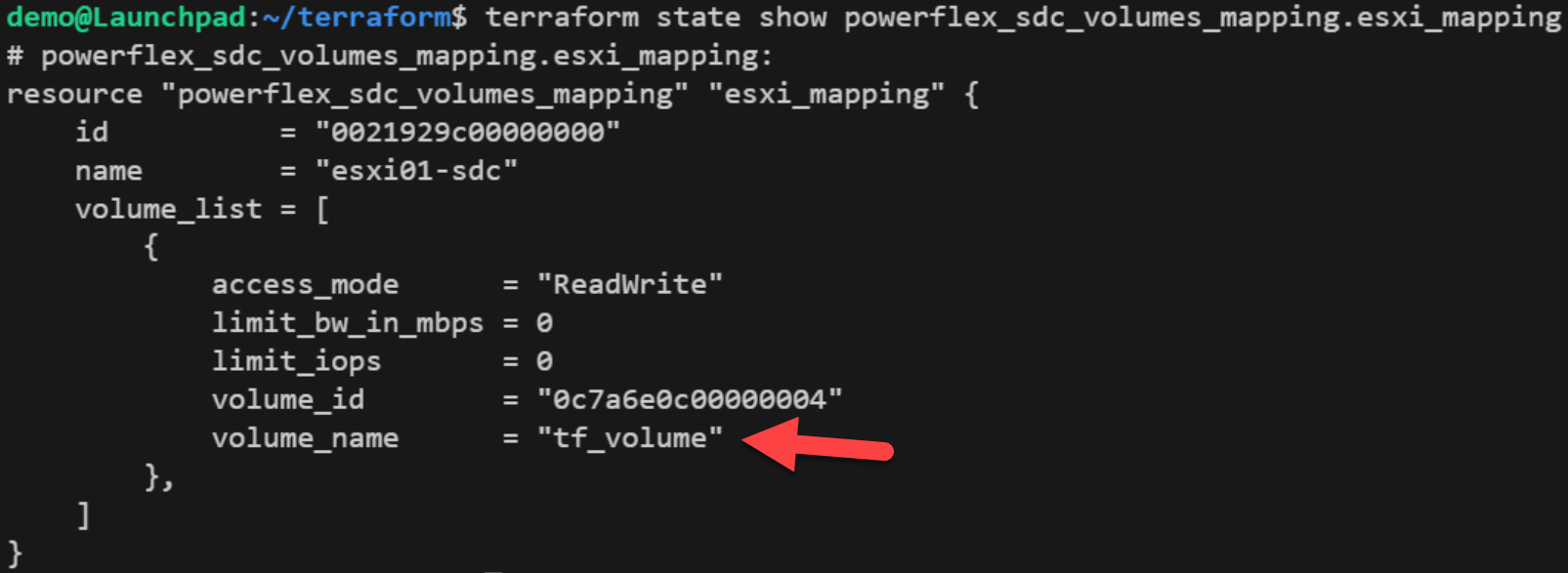
However, in the next terraform plan step, Terraform sees the conflict between its state of the resource and the actual resource and therefore tries to force the state by unmapping the existing Ansible volume:

To avoid this situation, we first need to import the resource with the following command:
terraform import "powerflex_sdc_volumes_mapping.esxi_mapping" <sdc-id>
After the import step, the Terraform state for the SDC_Volumes_Mapping resource in our example looks like the following:
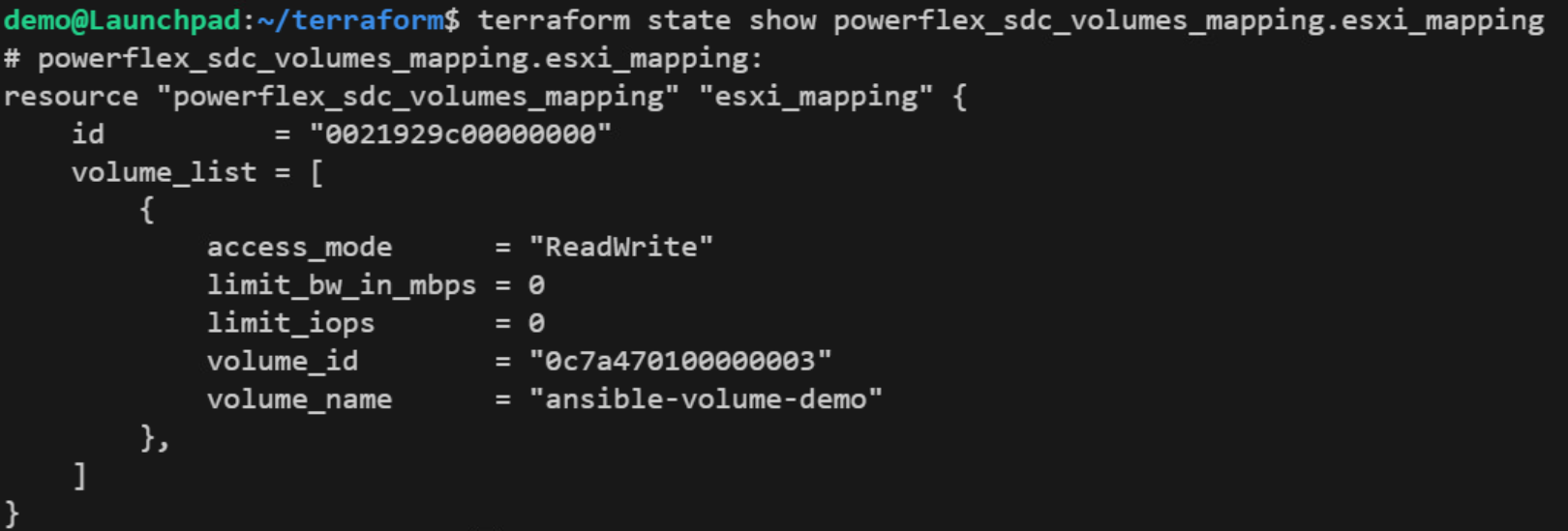
Now, to reflect this existing state, we must update our SDC_Volumes_Mapping resource configuration to include the existing volume. To do this, copy-paste the volume list items that are missing from the configuration as follows:
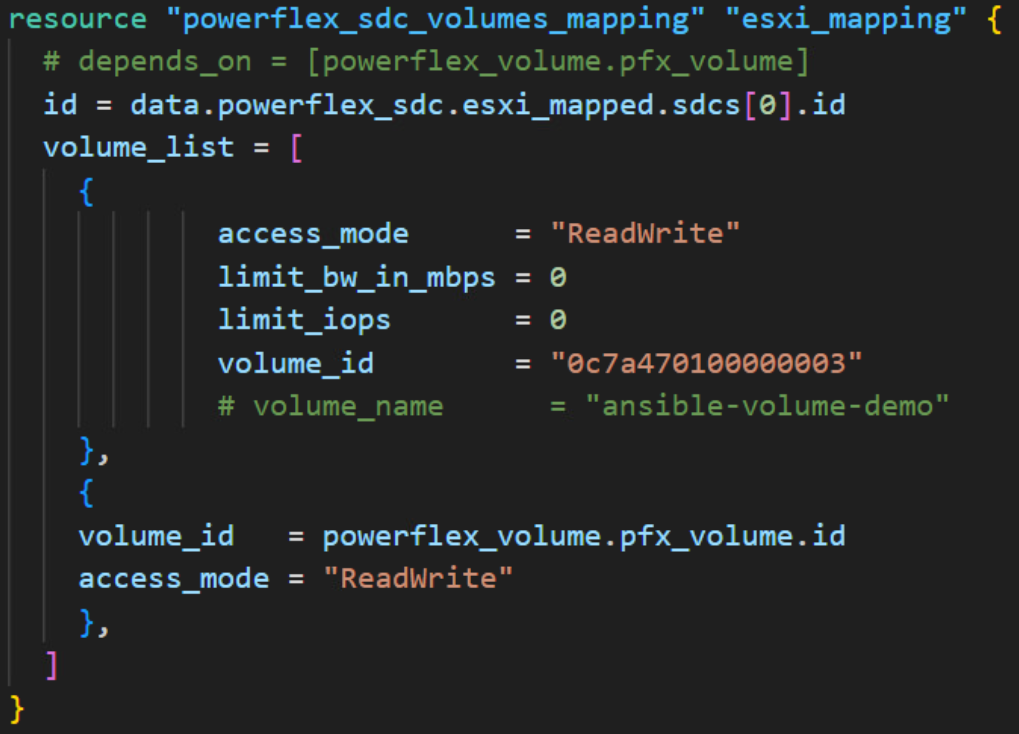
Note that I commented out volume_name since only one of volume_id and volume_name is allowed in the resource.
Finally, the Terraform plan actually reflects this updated state:
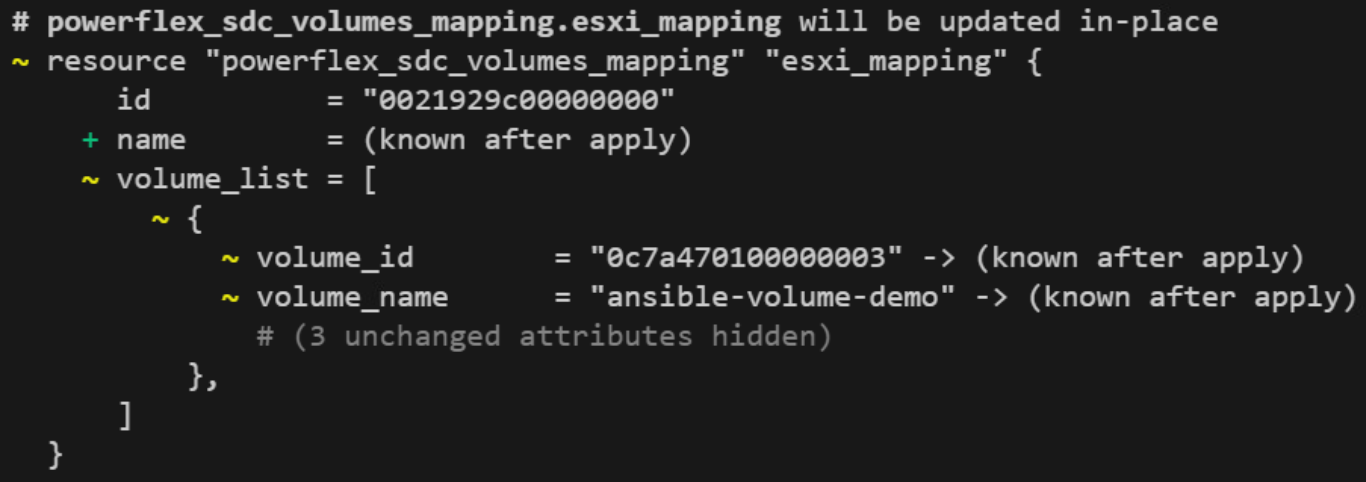
And that’s it! Now you know how to use import for a resource like SDC_Volumes_Mapping in Dell PowerFlex and update your Terraform configuration to reflect the actual state of the resource even before Terraform starts to manage it.
Terraform resources
Here are the link sets for key resources for each of the Dell Terraform providers:
Provider for PowerScale
Provider for PowerFlex
Provider for PowerStore
Provider for Redfish
Provider for APEX Navigator
Author: Parasar Kodati, Engineering Technologist, Dell ISG

Introducing APEX Navigator for Kubernetes: Resource onboarding
Mon, 20 May 2024 17:00:00 -0000
|Read Time: 0 minutes
We are excited to announce the availability of Dell APEX Navigator for Kubernetes! This offering is part of the Dell Premier account experience that includes the APEX Navigator user interface and shares the management interface with APEX Navigator for Storage. In a three-part blog series, we will go through the key aspects of the APEX Navigator for Kubernetes:
- Onboarding Kubernetes clusters and storage resources
- Batch deployment of Container Storage Modules
- Application Mobility between clusters
UI Overview
Once you login as an ITOPs user, you can navigate to the Kubernetes section under Manage section of the left side navigation bar:
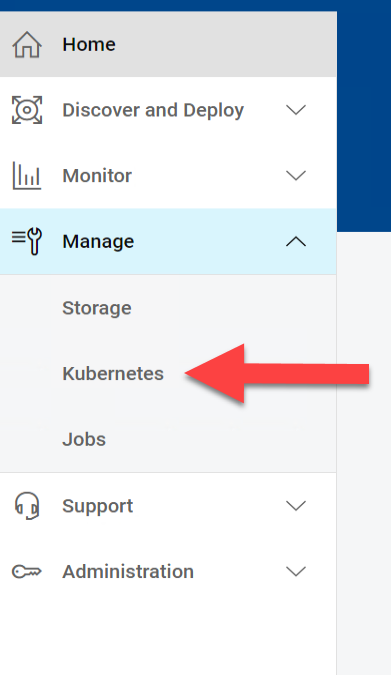
The details pane has four tabs:
- The Clusters tab shows the onboarded Kubernetes clusters in a tabular form with various attributes of the clusters as columns. You can add additional clusters and manage the container storage modules.

- Similarly the Storage tab shows the storage platforms onboarded.
- The Application Mobility section shows the Application Mobility jobs that have been initiated along with details like Source destination and the status of the job.
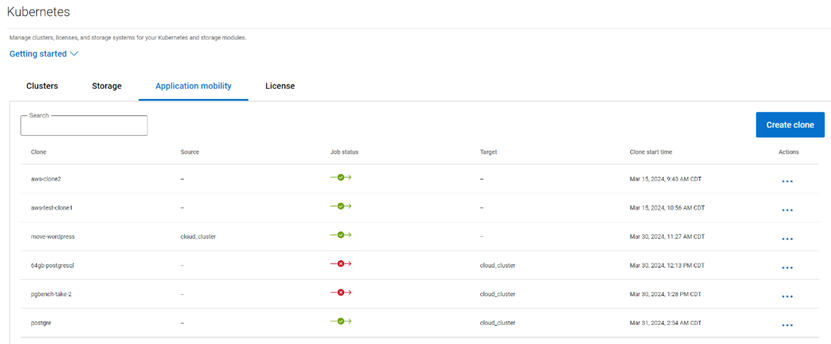
- The License tab lists the various licenses that have been added to the platform.

Multi-cloud Kubernetes Cluster onboarding
Kubernetes clusters both on-prem and on public clouds can be managed with APEX Navigator for Kubernetes.
Onboarding prerequisites
Before you onboard a cluster, please go through the following steps to make sure the cluster is ready to be onboarded.
Install the latest Dell CSM-operator
Dell CSM Operator is a Kubernetes Operator designed to manage the Dell Storage CSI drivers and Container Storage Modules. Install v1.4.4 or later using the instructions here.
Install the Dell Connectivity Client
The Dell Connectivity Client initiates a connection to https://connect-into.dell.com/ in order to communicate with APEX Navigator for Kubernetes. Therefore, the firewall and proxy between the Kubernetes cluster and that address must be opened.
To do this first make sure the following namespace are created on the cluster:
$ kubectl create namespace karavi dell-csm dell-connectivity-client
You can get the custom resource definition (CRD) YAML file to install the Dell Connectivity Client resource from the CSM Operator GitHub repo. Once you have the YAML file you can install the client service as follows:
$ kubectl apply -f dcm-client.yml
You can verify the installation to see an output like below:
$ kubectl get pods -n dell-connectivity-client
NAME READY STATUS RESTARTS AGE
dell-connectivity-client-0 3/3 Running 0 70s
Note: if you remove a cluster, please note that you need to re-install the Dell client before you onboard it again.
License for the cluster
On the License tab, you can add the different licenses that you have using APEX Navigator for Kubernetes. You will be assigning one of these licenses to the cluster once connected.
Connect to cluster
Once you have the CSM Operator and Dell Connectivity Client running on the cluster, you can connect to the cluster from the APEX Navigator UI. Here are the steps involved in establishing trust between the APEX Navigator and the Kubernetes cluster to onboard the cluster.
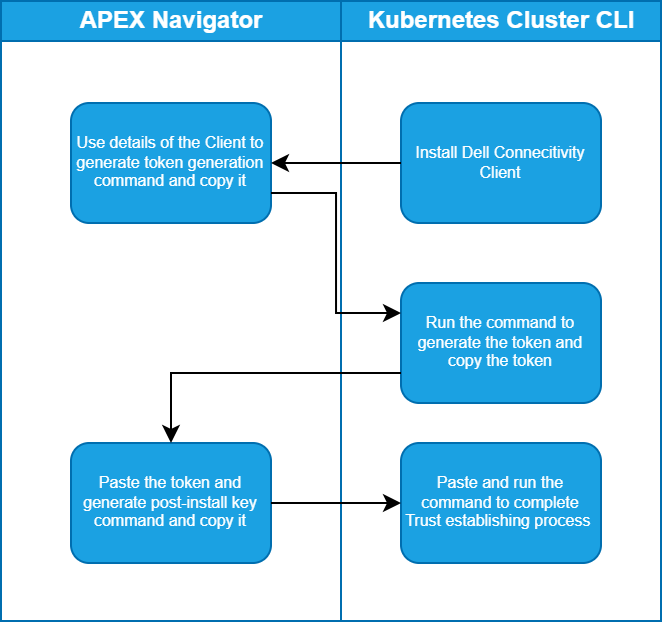
Follow the instructions on the UI to create the command that you need to run on your cluster to generate a token and then copy the token (underlined in the figure below) and paste it in the Install token field:

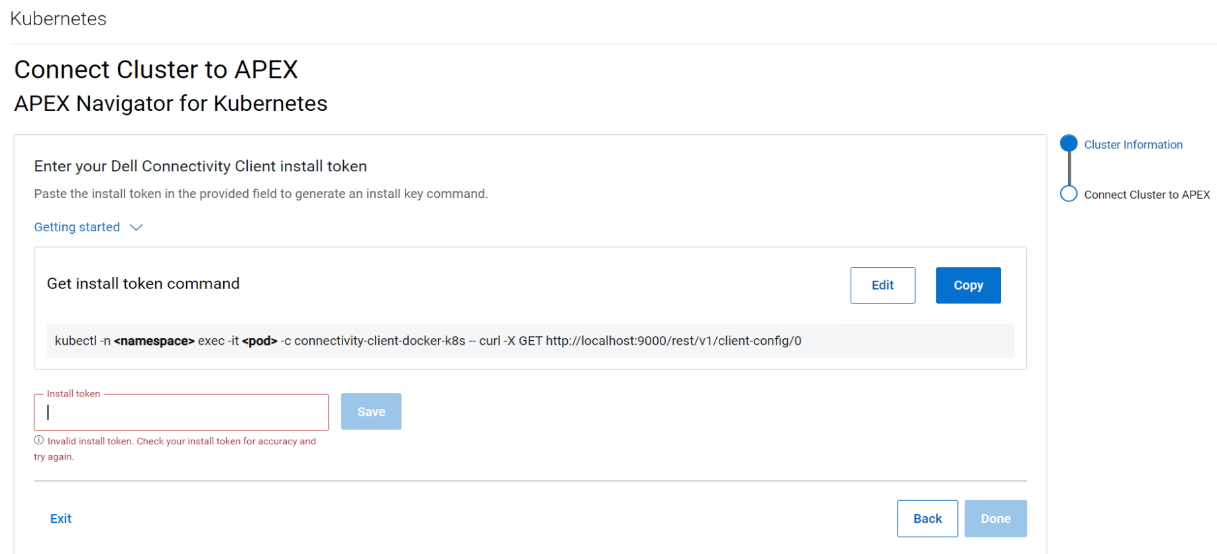
After this step, another command is generated that needs to be run on the cluster to complete the trusted connection process, as show in the following figure:
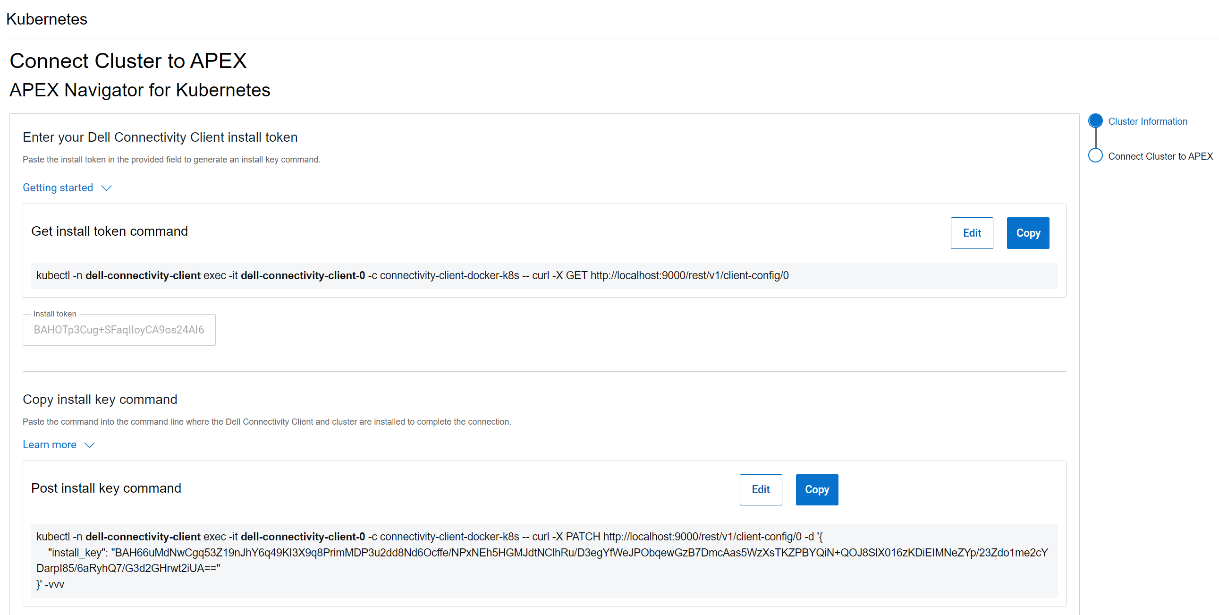
License for the cluster
Once the cluster successfully connects, you may see the cluster is still listed in grey color indicating that it requires a license. Click on the ellipsis (…) button under the Actions column, on the right-hand side of the cluster row and select “Manage license”. In the License selection dialog, you can select the License that you want to assign the cluster. This step completes the onboarding of the cluster.
Removing a cluster
Following are the steps to remove a Kubernetes cluster from APEX Navigator for Kubernetes:
1. Uninstall all modules:

2. Unassign the license
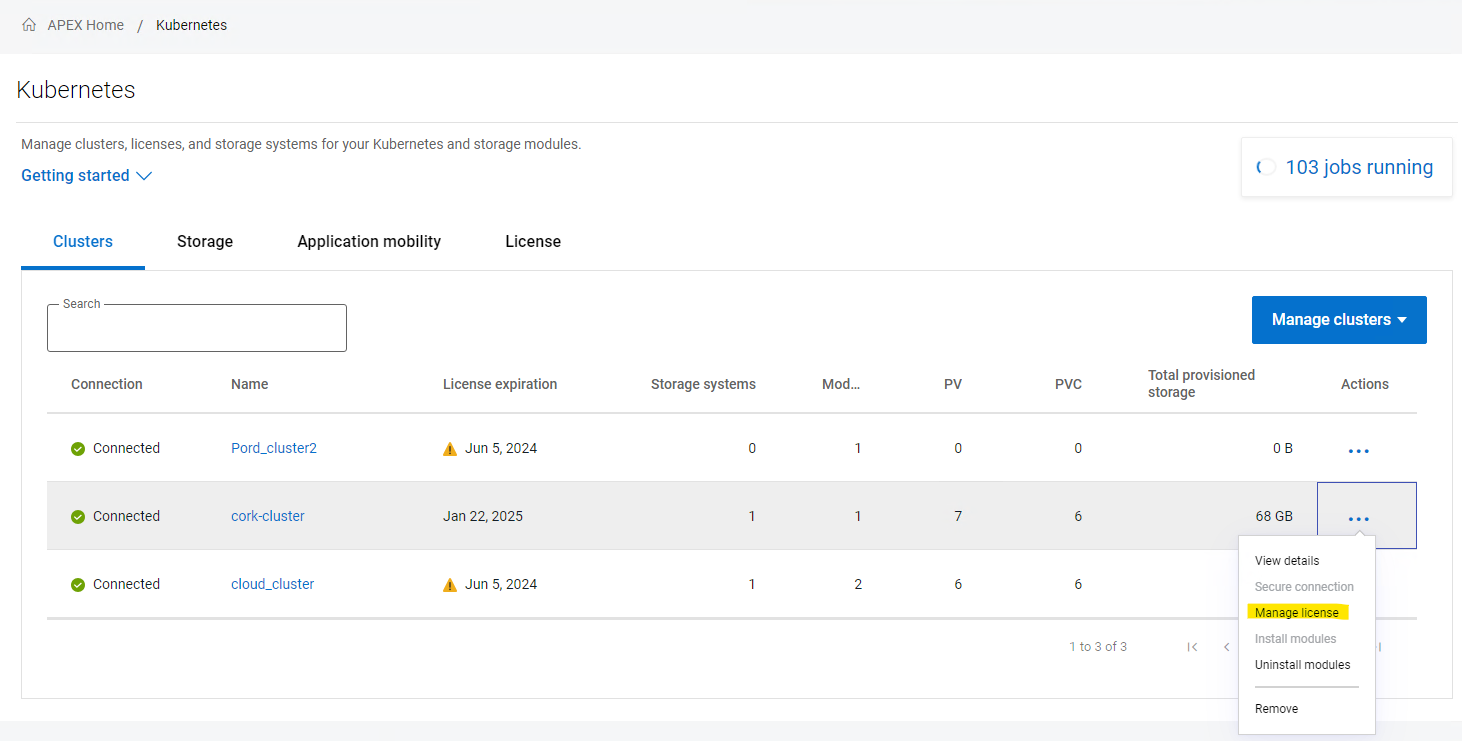
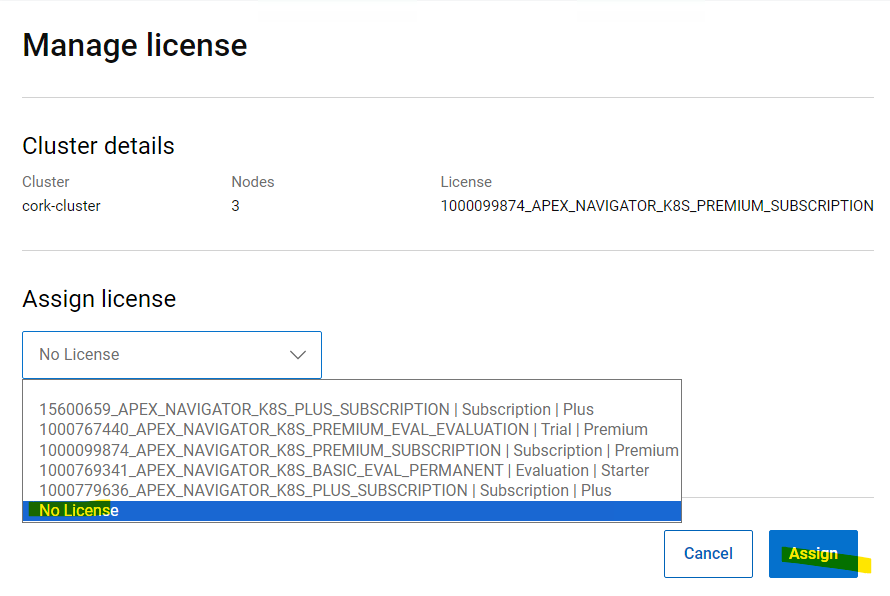
3. Remove the cluster from the interface.
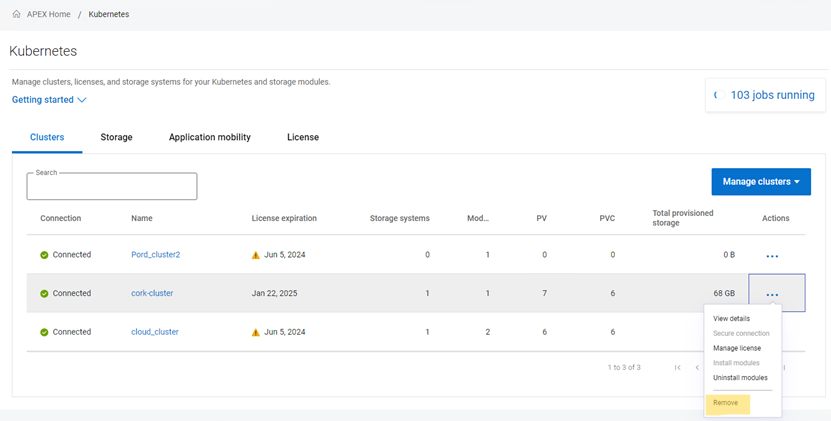
4. Uninstall the connectivity client on your cluster:
kubectl delete -n dell-connectivity-client apexconnectivityclients
After these four steps, the cluster is cleaned from every Dell CSI/CSM/APEX Navigator resource.
Multi cloud Storage support
APEX Navigator for Kubernetes supports both on-prem and on-cloud Dell storage platforms. On-prem storage systems can be added using a simple dialog as shown below:
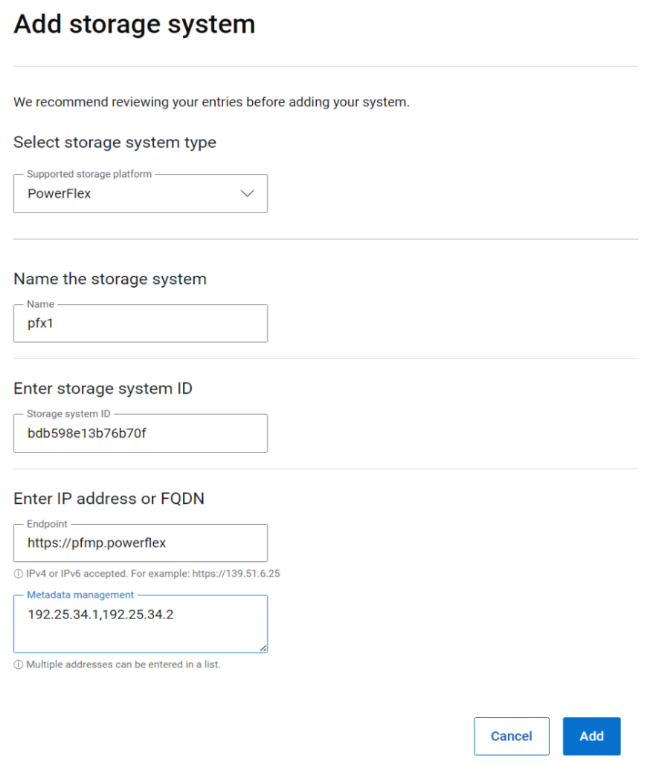
APEX Block storage on AWS
If you would like to use APEX Block storage on AWS, please make sure you have the required licenses for APEX Navigator for Storage and have onboarded your AWS account onto the APEX Navigator platform. You can deploy an APEX Block Storage cluster on AWS with just a few clicks (watch this demo video on YouTube) and start using the cloud storage for Kubernetes
Authors:
Parasar Kodati, Engineering Technologist, Dell ISG
Florian Coulombel, Engineering Technologist, Dell ISG

Introducing APEX Navigator for Kubernetes: Batch deployment of CSMs
Mon, 20 May 2024 17:00:00 -0000
|Read Time: 0 minutes
This is part 2 of the three-part blog post series introducing Dell APEX Navigator for Kubernetes. In this post, we will cover batch deployment of CSMs on any number of onboarded Kubernetes clusters.
A major advantage of using APEX Navigator for Kubernetes is the ability to deploy multiple CSMs onto multiple Kubernetes clusters which consume storage from different Dell storage systems (including Dell APEX Block Storage on AWS). Multiple install jobs are simultaneously launched on the clusters to enable parallel installation which saves time and effort for admins managing storage for a growing Kubernetes footprint. Let us see how this can be achieved.
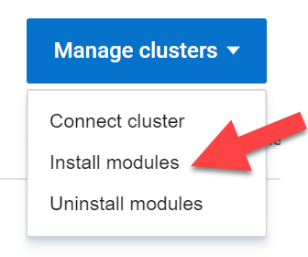
From the Clusters tab click on Manage Clusters and select Install modules:
This launches the Module Installation wizard where you can install specific Dell Container Storage Modules and things like SDC client for PowerFlex storage for an entire set of clusters. This ensures the same storage class and other configuration parameters are used across all the clusters for consistency and standardization. In the first release of APEX Navigator for Kubernetes, only Observability, Authorization, and Application Mobility CSMs are supported. Over time more services will be added.
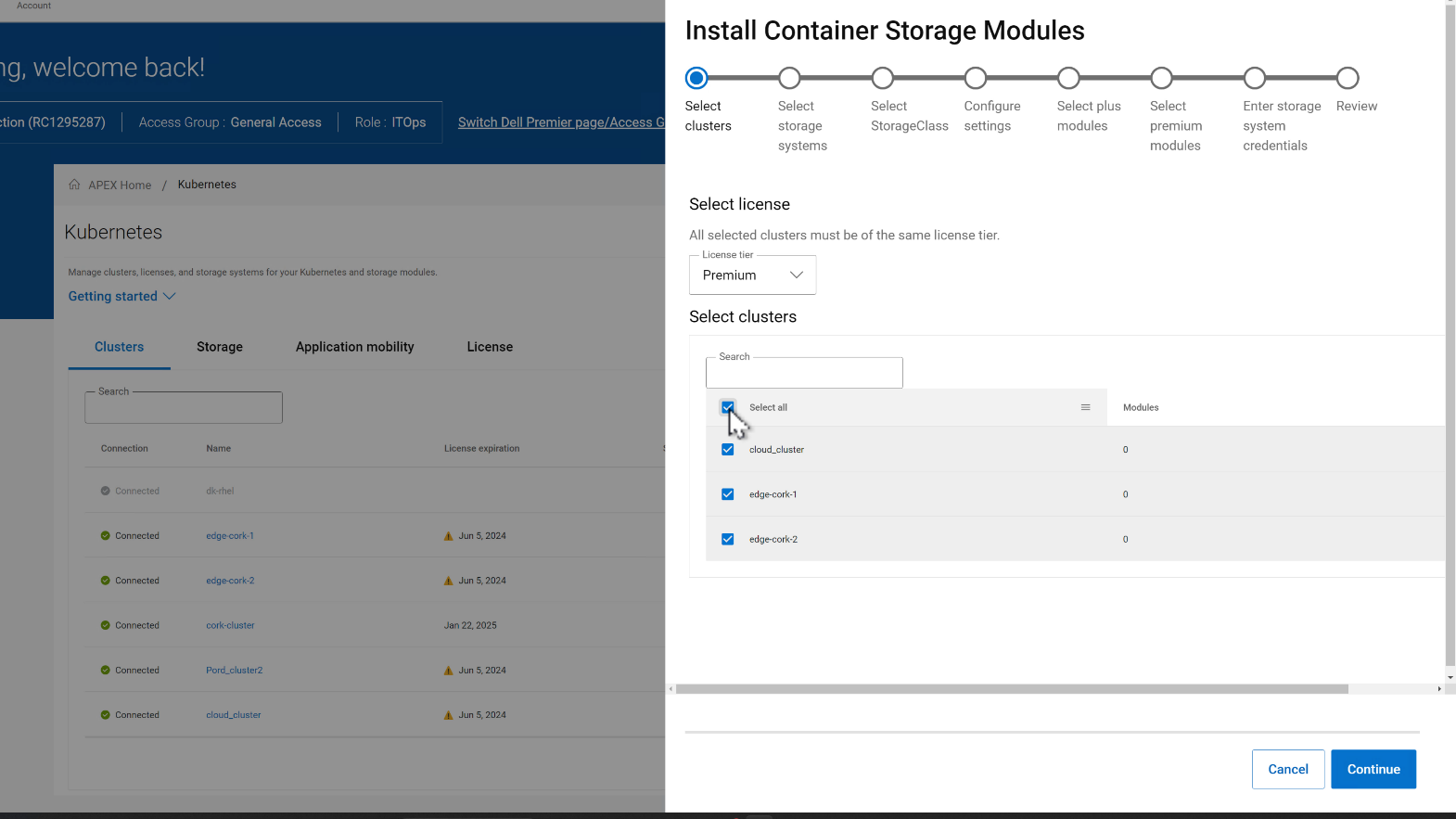
In the CSM deployment wizard, the first step is to select all the clusters where the CSMs need to be installed.

Then, you can select the storage systems for each of the clusters. In the figure below, the selected clusters are sharing the same storage.
In the next step, the Storage class is set for each cluster pair:
- Select the CSMs to install under Plus and Premium categories.
- Enter storage credentials for the storage platforms.
 On the summary page of the wizard, you can review the install configurations and click Install to start the installation process. You can track the multiple parallel install jobs on multiple clusters:
On the summary page of the wizard, you can review the install configurations and click Install to start the installation process. You can track the multiple parallel install jobs on multiple clusters:
Authors:
Parasar Kodati, Engineering Technologist, Dell ISG
Florian Coulombel, Engineering Technologist, Dell ISG

Introducing APEX Navigator for Kubernetes: Application Mobility
Mon, 20 May 2024 17:00:00 -0000
|Read Time: 0 minutes
This is part 3 of the three-part blog series introducing Dell APEX Navigator for Kubernetes.
Application Mobility Overview
Data and application mobility is an essential element in maintaining the required availability and service level for a given application. From a workload standpoint, the application needs to have a redundant instance at a target site that can be used as a failover instance. For this to work for stateful applications, we need to ensure data availability on the target site. Data mobility can be achieved in two ways:
- Continuous replication at the storage level using the Replication Container Storage Module
- Point-in-time host-based backup using the Application Mobility Container Storage Module
The Replication container storage module for Dell storage platforms orchestrates the data replication using the storage platform’s native replication capabilities. The Application Mobility module on the other hand uses the host-based backup approach. While both the approaches work for Dell storage platforms through the command line interface, the first release of APEX Navigator for Kubernetes user interface supports only the host-based backup functionality called the Application Mobility Module.
The following are the pre-requisites for application mobility:
- Source and target K8s clusters onboarded and Application Mobility CSM installed.
- Source and target Dell storage systems onboarded.
- S3 Object Store accessible from source and target for the intermediate backup copy of the application data
Adding Object Store
We already covered how to connect clusters and storage in previous sections. Let us see how to set up the S3 Object Store within the APEX Navigator for Kubernetes.
Navigate to the Storage tab and click on the “Add object store” button. This launches a dialog to add the details of the Object store:
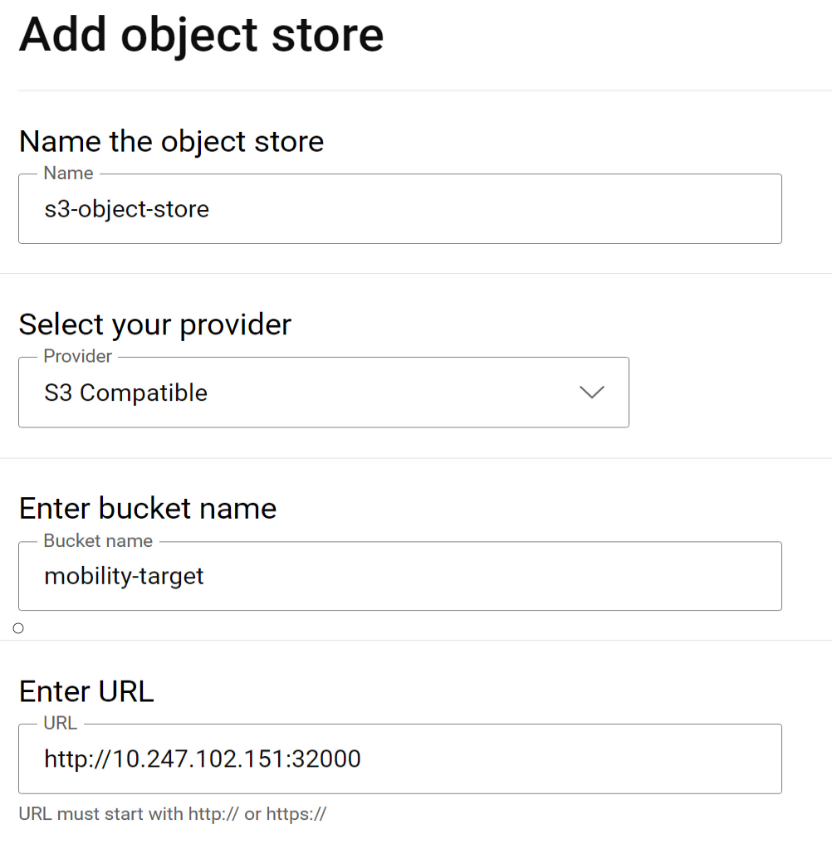
If using Amazon Web services (AWS) S3 for the object store, the region on the Kubernetes backup storage location object needs to be updated prior to creating a clone. On each Kubernetes cluster where Application Mobility is installed, run this command to update the region:
kubectl patch backupstoragelocation/default -n dell-csm --type='merge' -p '{"spec":{"config":{"region":"<region- name>"}}}'
Application Mobility definition
To start an Application mobility job, go to the Application Mobility tab and click “Create Clone”. This launches a wizard that takes you through the following steps:
- Specify source cluster and the namespace of the application to be moved.
- Specify target cluster and the namespace.
- Specify the Object store details to be used for the intermediate backup copy.
- Review details and click Create clone to start the mobility job.
You can track mobility jobs under Jobs section like below:
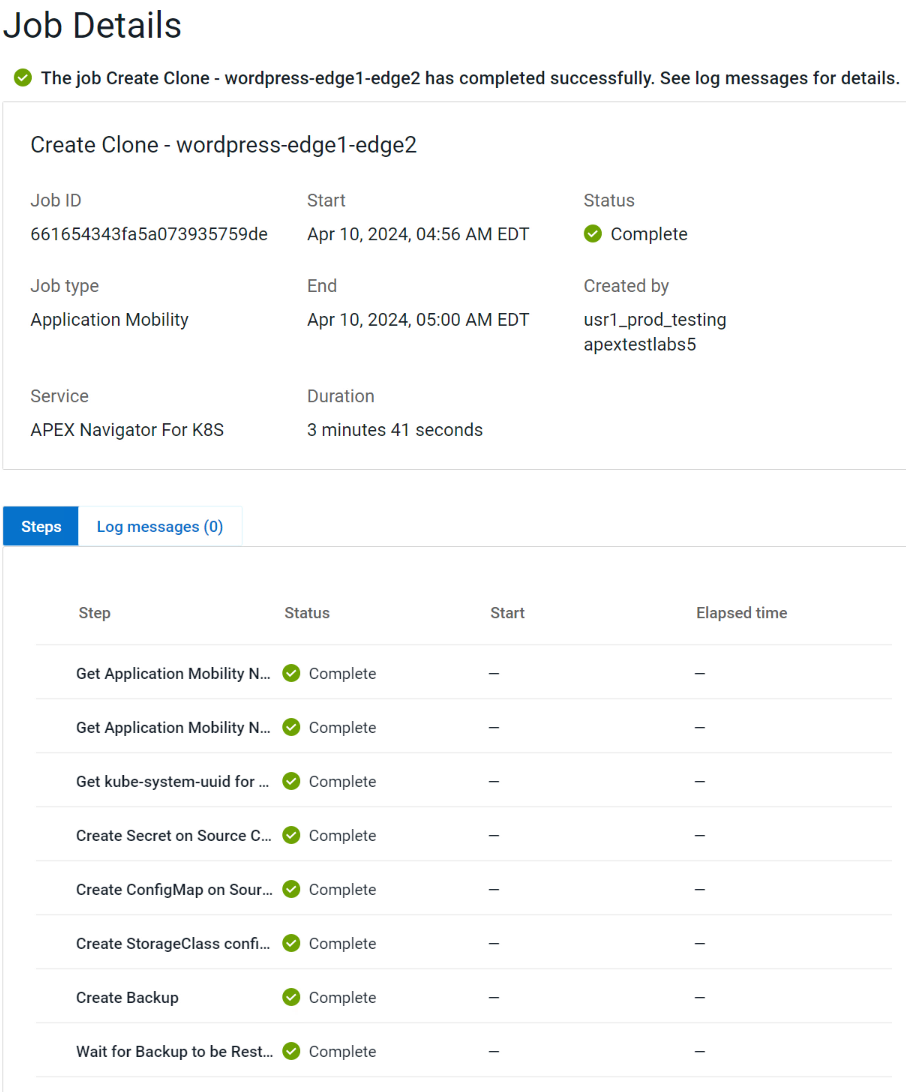
Authors:
Parasar Kodati, Engineering Technologist, Dell ISG
Florian Coulombel, Engineering Technologist, Dell ISG

Accelerating and Optimizing AI Operations with Infrastructure as Code
Fri, 03 May 2024 12:00:00 -0000
|Read Time: 0 minutes
Accelerating and Optimizing AI Operations with Infrastructure as Code
Achieving maturity in a DevOps organization requires overcoming various barriers and following specific steps. The level of maturity attained depends on the short-term and long-term goals set for the infrastructure. In the short term, IT teams must focus on upskilling their resources and integrating tools for containerization and automation throughout the operating lifecycles, from Day 0 to Day 2. Any progress made in scaling up containerized environments and automating processes significantly enhances the long-term economic viability and sustainability of the company. Furthermore, in the long term, it involves deploying these solutions across multicloud, multisite landscapes and effectively balancing workloads.
The optimization of your AI applications, and by extension, other high-value workloads, hinges upon the velocity, scalability, and efficacy of your infrastructure, as well as the maturity of your DevOps processes. Prior to the explosion that is AI, recent survey results indicated the state of automation for infrastructure operations’ workflows was overall less than 50%; partner that with twofold the increase of application counts and organizations may struggle against the waves of change[1].
From compute capabilities to storage density and speed, spanning across unstructured, block, and file formats, there exists fundamental elements of automation ripe for swift integration to establish a robust foundation. By seamlessly layering pre-built integration tools and a complementary portfolio of products at each stage, the journey towards ramping up AI can be alleviated.
There are important considerations regarding the various hardware infrastructure components for a generative AI system, including high performance computing, highspeed networking, and scalable, high-capacity, and low-latency storage to name a few. The infrastructure requirements for AI/ML workloads are dynamic and dependent on several factors, including the nature of the task, the size of the dataset, the complexity of the model, and the desired performance levels. There is no one-size-fits-all solution when it comes to Gen AI infrastructure, as different tasks and projects may demand unique configurations. Central to the success of generative AI initiatives is the adoption of Infrastructure-as-Code (IaC) principles which facilitate the automation and orchestration of underlying infrastructure components. By leveraging IaC tools like RedHat Ansible and HashiCorp Terraform, organizations can streamline the deployment and management of hardware resources, ensuring seamless integration with Gen AI workloads.
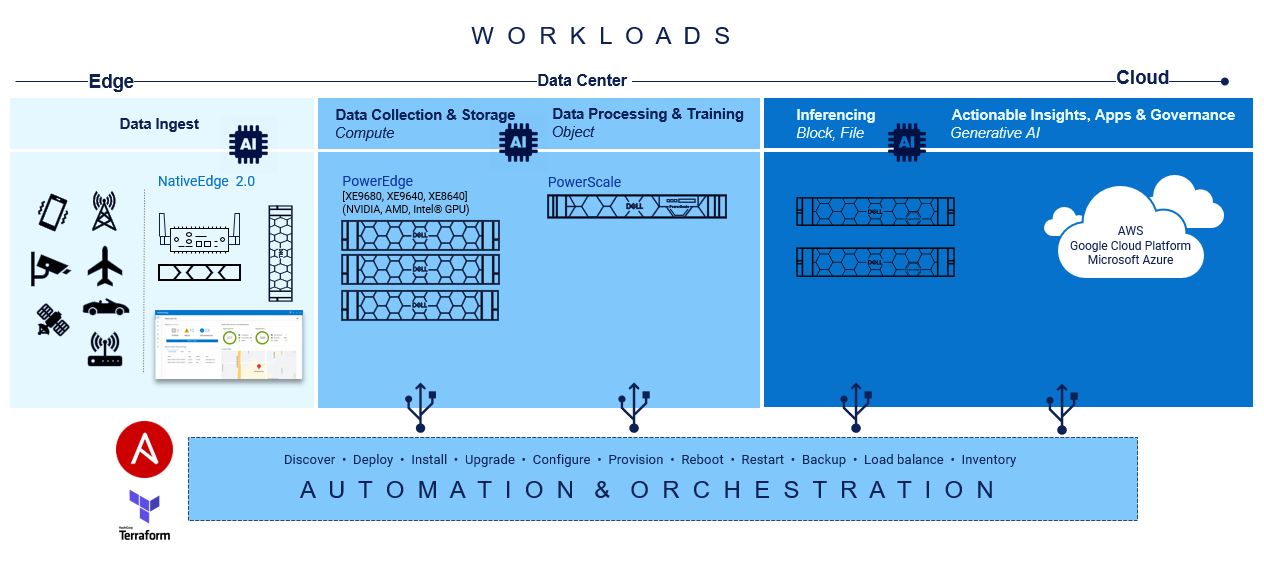 At the base of this foundation is Red Hat Ansible modules for Dell, and they speed up the provisioning of servers and storage for quick AI application workload mobility.
At the base of this foundation is Red Hat Ansible modules for Dell, and they speed up the provisioning of servers and storage for quick AI application workload mobility.
Creating playbooks with Ansible to automate server configurations, provisioning, deployments, and updates are seamless while data is being collected. Due to the declarative and mutable nature of Ansible, the playbooks can be changed in real-time without interruption to processes or end users.
Compute
On the compute front, a lot goes into configuring servers for the different AI and ML operations:
GPU Drivers and CUDA toolkit Installation: Install appropriate GPU drivers for the server's GPU hardware. For example, installing CUDA Toolkit and drivers to enable GPU acceleration for deep learning frameworks such as TensorFlow and PyTorch.
Deep Learning Framework Installation: Install popular deep learning frameworks such as TensorFlow or PyTorch, along with their associated dependencies.
Containerization: Consider using containerization technologies such as Docker or Kubernetes to encapsulate AI workloads and their dependencies into portable and isolated containers. Containerization facilitates reproducibility, scalability, and resource isolation, making it easier to deploy and manage GenAI workloads across different environments.
Performance Optimization: Optimize server configurations, kernel parameters, and system settings to maximize performance and resource utilization for GenAI workloads. Tune CPU and GPU settings, memory allocation, disk I/O, and network configurations based on workload characteristics and hardware capabilities.
Monitoring and Management: Implement monitoring and management tools to track server performance metrics, resource utilization, and workload behavior in real-time.
Security Hardening: Ensure server security by applying security best practices, installing security patches and updates, configuring firewalls, and implementing access controls. Protect sensitive data and AI models from unauthorized access, tampering, or exploitation by following security guidelines and compliance standards.
Dell Openmanage Ansible collection offers modules and roles both at the iDRAC/Redfish interface level and at the OpenManage Enterprise level for server configurations such as PowerEdge XE 9860 designed to collect, develop, train, and deploy large machine learning models (LLMs).
The following is a summary of the OME and iDRAC modules and roles as part of the openmanage collection:
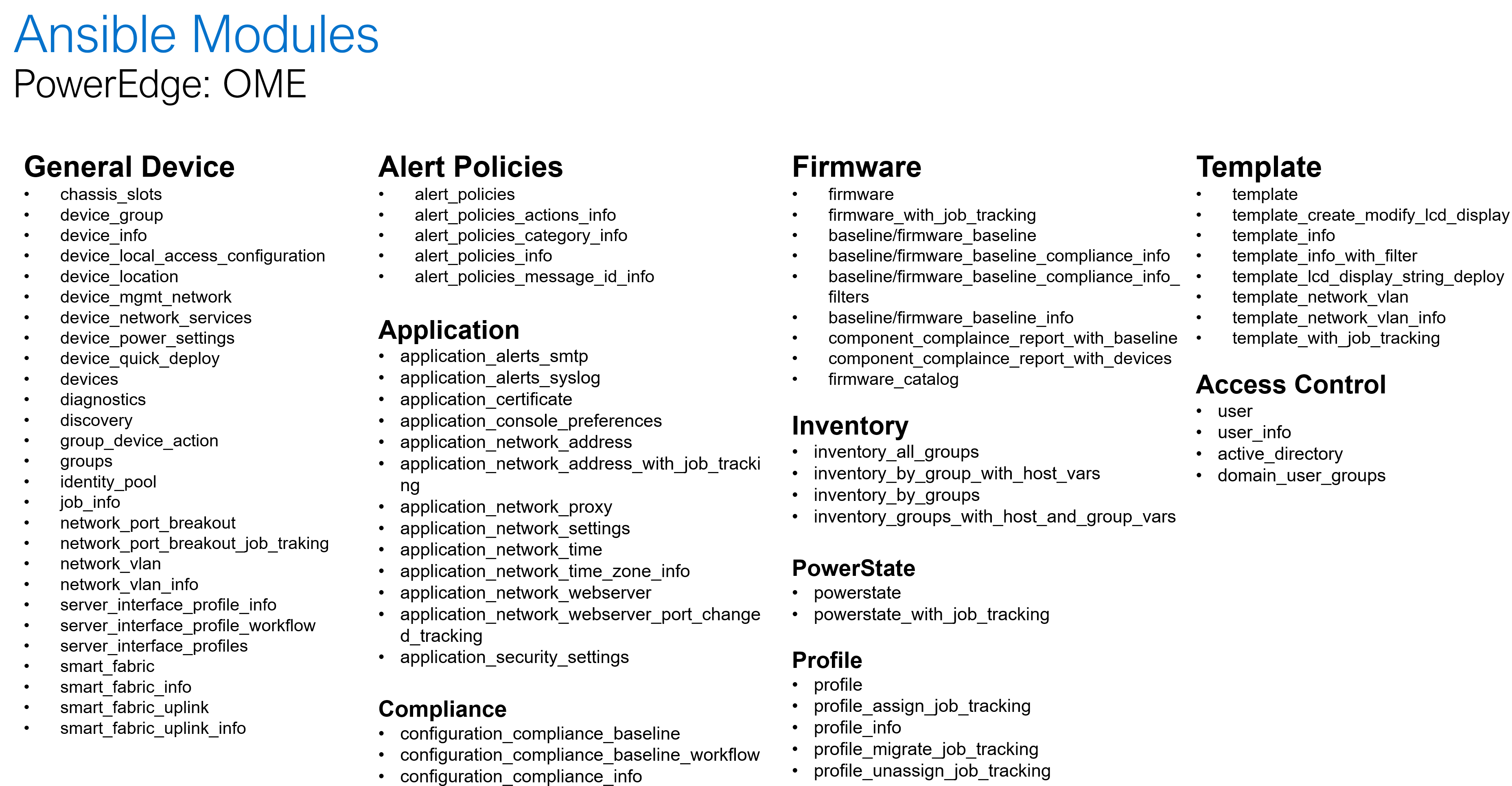

Storage
When it comes to AI and storage, during the data processing and training aspects, customers rely on scalable and simple access to file systems which increased data is trained on. With AI unstructured data storage is necessary for the bounty of rich context and nuance that will be accessed during the building phase. It also highly depends on user access to be variable, and Ansible automation playbooks can help change and adapt quickly.
Dell PowerScale is the world’s leading scale-out NAS platform, and it recently became the first ethernet storage certified on NVIDIA SuperPod. When it comes to Ansible automation, PowerScale comes with an extensive set of modules that covers a wide range of platform operations:
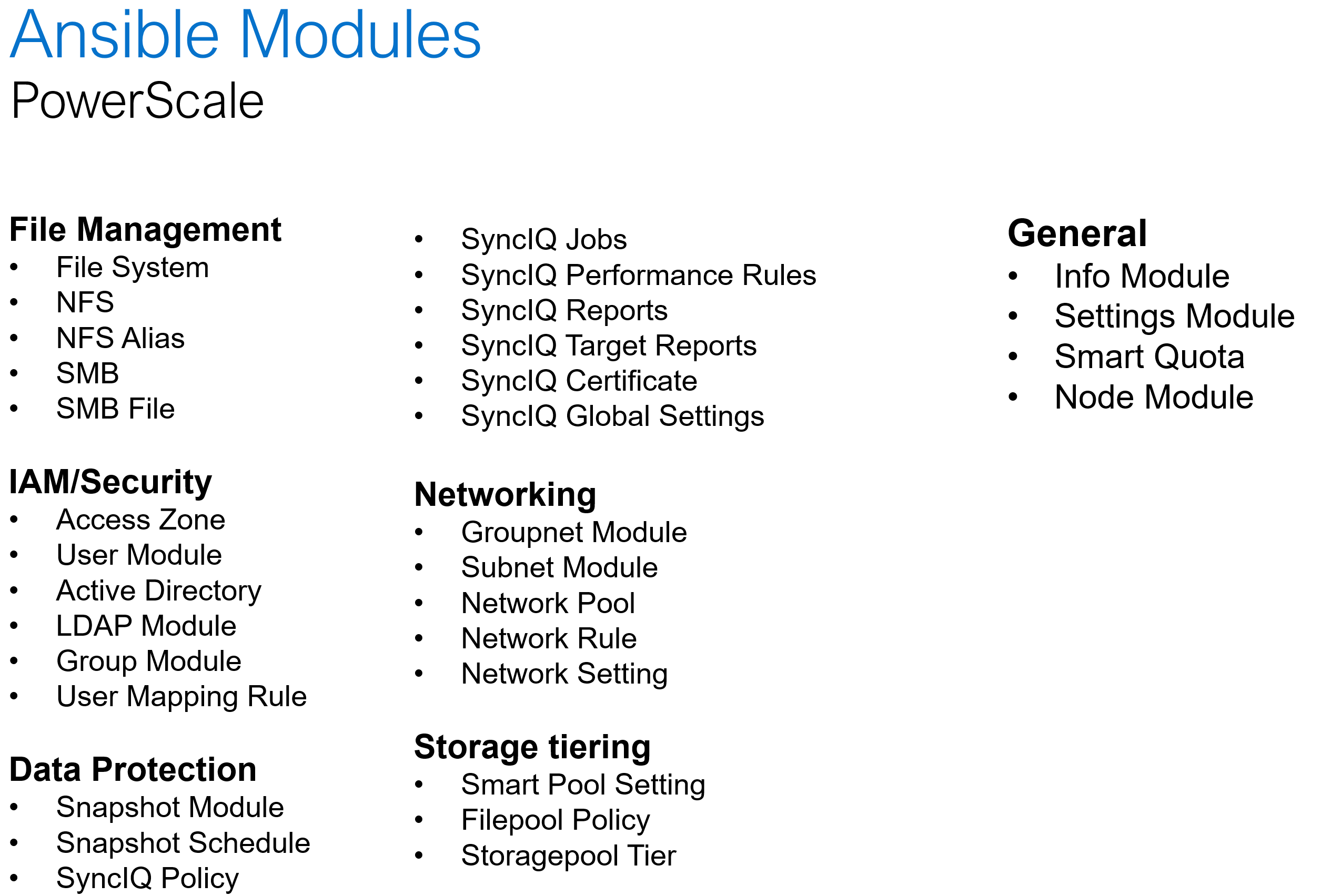
Software defined storage
Hyper converged platforms like PowerFlex offer highly scalable and configurable compute and storage clusters. In addition to the common day-2 tasks like storage provisioning, data protection and user management, the Ansible collection for PowerFlex can be used for cluster deployment and expansion. Here is a summary of what Ansible collections for PowerFlex offers:
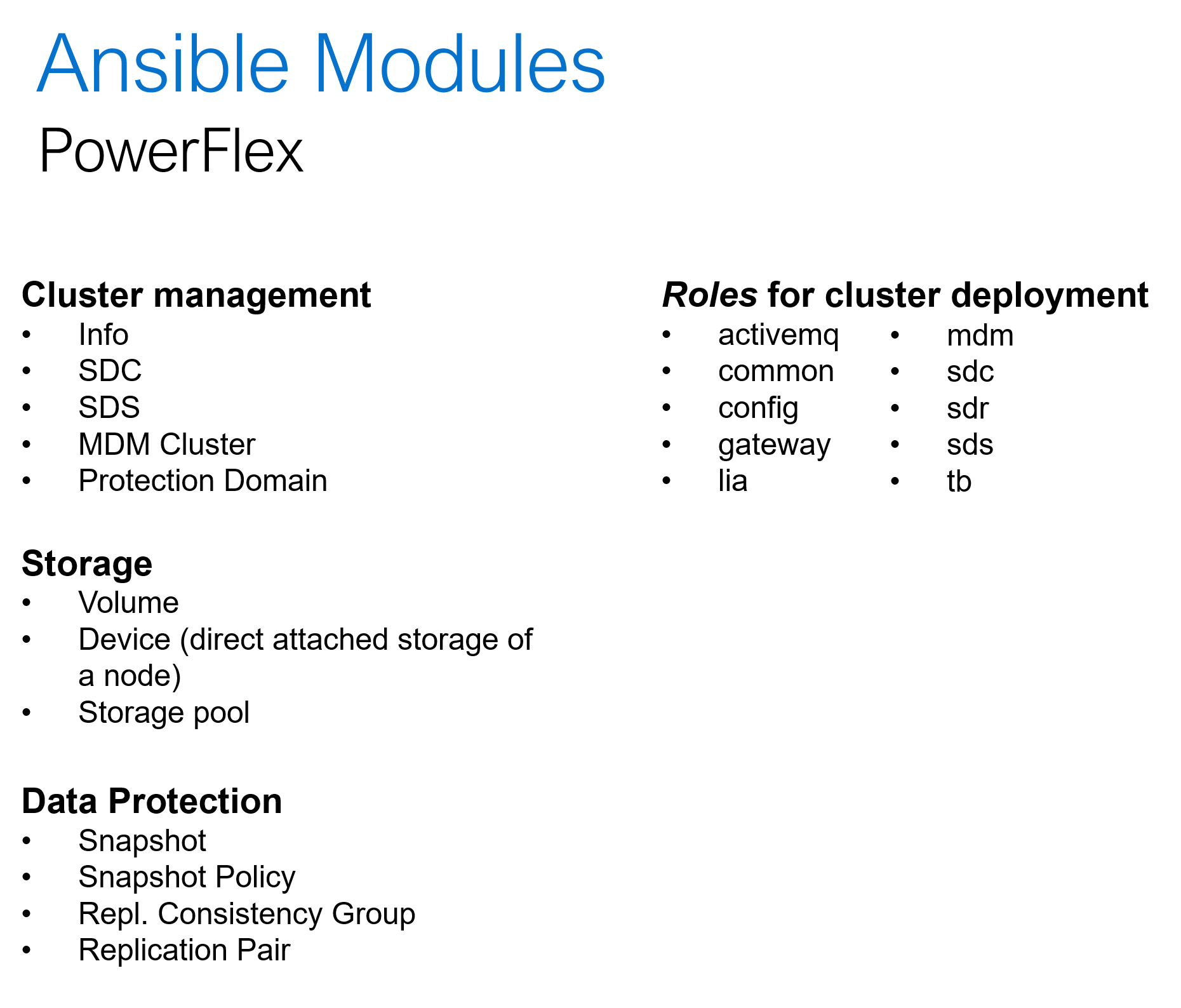
Conclusion
The one thing agreed upon is that Generative AI tools need the scale, repeatability, and reliability beyond anything created from the software and data center combined. This is precisely what building infrastructure-as-code practices into a multisite operation are designated to do. From PowerEdge to PowerScale, the level of capacity and performance is unmatched. This allows AI operations and Generative AI to absorb, grow and provide the intelligence that organizations need to be competitive and innovative.
[1] Infrastructure-as-code and DevOps Automation: The Keys to Unlocking Innovation and Resilience, September 2023
Other resources:
GenAI Acceleration Depends on Infrastructure as Code
Authors: Jennifer Aspesi, Parasar Kodati

Announcing Ansible modules for Q1 2023 release
Mon, 29 Apr 2024 19:23:05 -0000
|Read Time: 0 minutes
At the beginning of the year, I blogged about all the new Ansible integration features that were released in 2022 across the Dell infrastructure portfolio. As we add new functionality and make REST API enhancements to the different storage and server products of the portfolio, we add support for select features to the corresponding Ansible modules a few months down the line. For the storage portfolio, this happens every month, and for OpenManage modules for PowerEdge server line, the Ansible updates happen every month. So here I am here again with the Q1 release of the various Ansible plug-ins for the portfolio. In this set of releases, PowerStore tops the list with the greatest number of enhancements. Let’s look at each product to cover the main highlights of the release. If you really want to grok the workings of the Ansible module, the Python libraries for the storage and server platforms are also available. You can easily find them with a simple keyword search like this search on GitHub.
PowerStore
Version: 1.9
What’s new:
The main highlight for this release is around vVols and storage container support.
- Support for vVols
- Info module: List all vVol IDs and names if no specific vVol name or ID is specified
- Info module: List vVol details, including mapped hosts and host groups, for a specific vVol specified using ID or name
- Host and Host_group modules: List vVol details for a host or host group if applicable
- Support for vCenter
- List vCenter and associated details in Info module
- Add or delete a vCenter
- Modify vCenter settings
- Modify storage container
- Rename the storage container
- Enable/disable storage container capacity quota
- Specify container quota size or high-water mark values
- Change storage protocols—iSCSI, FC, or NVMe-oF
- Volume module: Support for application type in the Volume module. Here are the choices for quick reference:
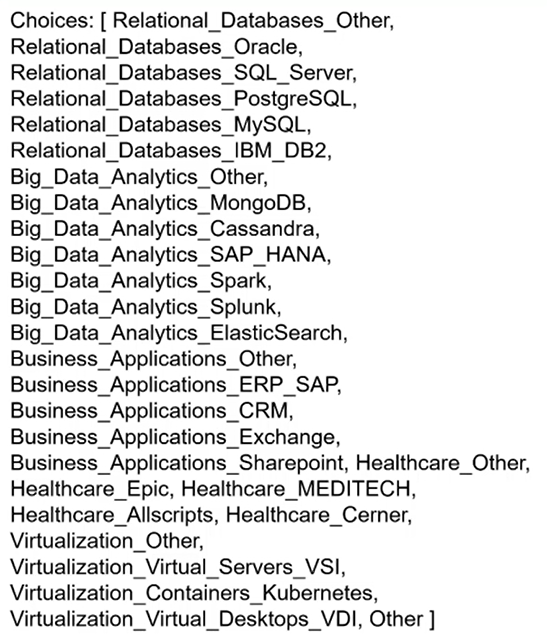
- Filesystem module: Added support for configuring the following file system attributes while creating or modifying a file system. Note that you must be on PowerStore 3.0 or later to access these attributes:
- config_type:
- General—General-purpose use-case file system
- VMware-—VMware datastore-purpose use-case file system
- is_async_MTime_enabled:
- true—Asynchronous MTIME is enabled on the file system
- false—Asynchronous MTIME is disabled on the file system
- file_events_publishing_mode
- File retention attributes
- host_io_size—Applicable for VMware config file systems
- config_type:
GitHub release history: https://github.com/dell/ansible-powerstore/blob/main/CHANGELOG.rst
PowerScale
Version: 1.9
What’s new:
- User module: Support for changing user password
- User module: Support for creating a user and group with both name and ID (uid or gid)
- SMB module: support for finding and closing SMB open files
- Synciqpolicy module: Improved error handling for scenarios where no SyncIQ policy is returned
GitHub release history: https://github.com/dell/ansible- powerscale/blob/main/CHANGELOG.rst
Unity
Version: 1.6
What’s new:
- Ability to add a host from the Host List to NFS Export in the same way as in Unisphere UI or uemcli
- Filesystem module: Support for synchronous replication for filesystem module
- Volume module: Support for enabling and disabling advanced deduplication
GitHub release history: https://github.com/dell/ansible-unity/blob/main/CHANGELOG.rst
OpenManage
Did you know that under the OpenManage Ansible plug-in set we have two entirely different types of Ansible modules? Going by the name, you would expect Ansible modules to manage configurations with OpenManage Enterprise artifacts like templates, baselines, compliance reporting, and so on. But the same OpenManage plug-in also includes Ansible modules to directly manage the iDRAC endpoints of your server fleet so that users can manage the server inventory directly with more granularity within Ansible. I hope most readers already know about this. Okay, so here is what’s new in this comprehensive plug-in (see this previous blog post for key integration highlights of v7.1 of the Ansible plug-in for OpenManage). Here is the GitHub page where you can view the complete release history for OpenManage.
Version: 7.2
What’s new:
- New module dellemc.openmanage.ome_profile_info: To retrieve profiles with attribute details
- New module dellemc.openmanage.ome_template_network_vlan_info: To retrieve network configuration of template
- idrac_redfish_storage_controller module: Enhanced to configure controller attributes and online capacity expansion
- ome_domian_user_groups module: Added ability to import the LDAP directory groups
- ome_inventory module: Now supports inventory retrieval of system and plug-in groups of OpenManage Enterprise
- ome_profile_info module: Added ability to retrieve profiles with attributes on OpenManage Enterprise or OpenManage Enterprise Modular
- ome_template_network_vlan_info: Added ability to retrieve the network configuration of a template on OpenManage Enterprise or OpenManage Enterprise Modular
Version: 7.3
What’s new:
- dellemc.openmanage.idrac_export_server_config_profile: Role to export iDRAC Server Configuration Profile (SCP)
- idrac_server_config_profile: Enhanced to support proxy settings, import buffer, include in export, and ignore certificate warning
GitHub release history: https://github.com/dell/dellemc-openmanage-ansible-modules/releases
OK, that’s not all for Dell-Ansible integrations for Q1. Stay tuned for some major developments coming soon.

For the Year 2022: Ansible Integration Enhancements for the Dell Infrastructure Solutions Portfolio
Mon, 29 Apr 2024 19:20:40 -0000
|Read Time: 0 minutes
The Dell infrastructure portfolio spans the entire hybrid cloud, from storage to compute to networking, and all the software functionality to deploy, manage, and monitor different application stacks from traditional databases to containerized applications deployed on Kubernetes. When it comes to integrating the infrastructure portfolio with 3rd party IT Operations platforms, Ansible is at the top of the list in terms of expanding the scope and depth of integration.
Here is a summary of the enhancements we made to the various Ansible modules across the Dell portfolio in 2022:
- Ansible plugin for PowerStore had four different releases (1.5,1.6,1.7, and 1.8) with the following capabilities:
- New modules:
- dellemc.powerstore.ldap_account – To manage LDAP account on Dell PowerStore
- dellemc.powerstore.ldap_domain - To manage LDAP domain on Dell PowerStore
- dellemc.powerstore.dns - To manage DNS on Dell PowerStore
- dellemc.powerstore.email - To manage email on Dell PowerStore
- dellemc.powerstore.ntp - To manage NTP on Dell PowerStore
- dellemc.powerstore.remote_support – To manage remote support to get the details, modify the attributes, verify the connection. and send a test alert
- dellemc.powerstore.remote_support_contact – To manage remote support contact on Dell PowerStore
- dellemc.powerstore.smtp_config – To manage SMTP config
- Added support for the host connectivity option to host and host group
- Added support for cluster creation and validating cluster creation attributes
- Data operations:
- Added support to clone, refresh, and restore a volume
- Added support to configure/remove the metro relationship for a volume
- Added support to modify the role of replication sessions
- Added support to clone, refresh, and restore a volume group
- File system:
- Added support to associate/disassociate a protection policy to/from a NAS server
- Added support to handle filesystem and NAS server replication sessions
- Ansible execution:
- Added an execution environment manifest file to support building an execution environment with Ansible Builder
- Enabled check_mode support for Info modules
- Updated modules to adhere to Ansible community guidelines
- The Info module is enhanced to list DNS servers, email notification destinations, NTP servers, remote support configuration, remote support contacts and SMTP configuration, LDAP domain, and LDAP accounts.
- Visit this GitHub page to go through release history: https://github.com/dell/ansible-powerstore/blob/main/CHANGELOG.rst
- New modules:
- Ansible plugin for PowerFlex had four different releases (1.2, 1.3, 1.4, and 1.5) with the following capabilities:
- New modules:
- dellemc.powerflex.replication_consistency_group – To manage replication consistency groups on Dell PowerFlex
- dellemc.powerflex.mdm_cluster – To manage a MDM cluster on Dell PowerFlex
- dellemc.powerflex.protection_domain – To manage a Protection Domain on Dell PowerFlex
- The info module is enhanced to support listing the replication consistency groups, volumes, and storage pools with the statistics data.
- Storage management:
- The storage pool module is enhanced to get the details with the statistics data.
- The volume module is enhanced to get the details with the statistics data.
- Ansible execution:
- Added an execution environment manifest file to support building an execution environment with Ansible Builder
- Enabled check_mode support for the Info module
- Updated modules to adhere to Ansible community guidelines
- Visit this GitHub page to go through release history: https://github.com/dell/ansible-powerflex/blob/main/CHANGELOG.rst
- New modules:
- The Ansible plugin for PowerMax had four different releases (1.7, 1.8, 2.0 and 2.1) with the following capabilities:
- New module: dellemc.powermax.initiator – To manage initiators
- Host operations:
- Added support of case insensitivity of the host WWN to the host, and to the masking view module.
- Enhanced the host module to add or remove initiators to or from the host using an alias.
- Data operations:
- Enhanced storage group module to support
- Moving volumes to destination storage groups.
- Making volume name an optional parameter while adding a new volume to a storage group.
- Setting host I/O limits for existing storage groups and added the ability to force move devices between storage groups with SRDF protection.
- Enhanced volume module to support
- A cylinders option to specify size while creating a LUN, and added the ability to create volumes with identifier_name and volume_id.
- Renaming volumes that were created without a name.
- Enhanced the RDF group module to get volume pair information for an SRDF group.
- Enhanced storage group module to support
- Added an execution environment manifest file to support building an execution environment with Ansible Builder
- Added rotating file handler for log files
- Enhanced the info module to list the initiators, get volume details and masking view connection information
- Enhanced the verifycert parameter in all modules to support file paths for custom certificate location.
- Some things renamed:
- Names of previously released modules have been changed from dellemc_powermax_<module name> to <module name>
- The Gatherfacts module is renamed to Info
- Renamed metro DR module input parameters
- Visit this GitHub page to go through release history: https://github.com/dell/ansible-powermax/blob/main/CHANGELOG.rst
- Ansible plugin for PowerScale had four different releases (1.5,1.6,1.7 and 1.8) with the following capabilities:
- New modules:
- dellemc.powerscale.nfs_alias – To manage NFS aliases on a PowerScale
- dellemc.powerscale.filepoolpolicy – To manage the file pool policy on PowerScale
- dellemc.powerscale.storagepooltier – To manage storage pool tiers on PowerScale
- dellemc.powerscale.networksettings – To manage Network settings on PowerScale
- dellemc.powerscale.smartpoolsettings – To manage Smartpool settings on PowerScale
- Security support:
- Support for security flavors while creating and modifying NFS export.
- Access Zone, SMB, SmartQuota, User and Group modules are enhanced to support the NIS authentication provider.
- The Filesystem module is enhanced to support ACL and container parameters.
- The ADS module is enhanced to support the machine_account and organizational_unit parameters while creating an ADS provider.
- File management:
- The Info module is enhanced to support the listing of NFS aliases.
- Support to create and modify additional parameters of an SMB share in the SMB module.
- Support for recursive force deletion of filesystem directories.
- Ansible execution
- Added an execution environment manifest file to support building an execution environment with Ansible Builder.
- Check mode is supported for the Info, Filepool Policy, and Storagepool Tier modules.
- Added rotating file handlers for log files.
- Removal of the dellemc_powerscale prefix from all module names.
- Other module enhancements:
- The SyncIQ Policy module is enhanced to support accelerated_failback and restrict_target_network of a policy.
- The Info module is enhanced to support NodePools and Storagepool Tiers Subsets.
- The SmartQuota module is enhanced to support container parameter and float values for Quota Parameters.
- Visit this GitHub page to go through release history: https://github.com/dell/ansible- powerscale/blob/main/CHANGELOG.rst
- New modules:
- The Ansible plugin for Dell OpenManage had 13 releases this year, some of which were major releases. Here is a brief summary:
- v7.1: Support for retrieving smart fabric and smart fabric uplink information, support for IPv6 addresses for OMSDK dependent iDRAC modules, and OpenManage Enterprise inventory plugin.
- v7.0: Rebranded from Dell EMC to Dell, enhanced the idrac_firmware module to support proxy, and added support to retrieve iDRAC local user details.
- v6.3: Support for the LockVirtualDisk operation and to configure Remote File Share settings using the idrac_virtual_media module.
- v6.2: Added clear pending BIOS attributes, reset BIOS to default settings, and configured BIOS attributes using Redfish enhancements for idrac_bios.
- v6.1: Support for device-specific operations on OpenManage Enterprise and configuring boot settings on iDRAC.
- v6.0: Added collection metadata for creating execution environments, deprecation of share parameters, and support for configuring iDRAC attributes using the idrac_attributes module.
- v5.5: Support to generate certificate signing request, import, and export certificates on iDRAC.
- v5.4: Enhanced the idrac_server_config_profile module to support export, import, and preview of the SCP configuration using Redfish and added support for check mode.
- v5.3: Added check mode support for redfish_storage_volume, idempotency for the ome_smart_fabric_uplink module, and support for debug logs added to ome_diagnostics
- V5.2: Support to configure console preferences on OpenManage Enterprise.
- V5.1: Support for OpenManage Enterprise Modular server interface management.
- V5.0.1: Support to provide custom or organizational CA signed certificates for SSL validation from the environment variable.
- 5.0: HTTPS SSL support for all modules and quick deploy settings.
- Visit this GitHub page to go through release history: https://github.com/dell/dellemc-openmanage-ansible-modules/releases.
For all Ansible projects you can track the progress, contribute, or report issues on individual repositories.
You can also join our DevOps and Automation community at: https://www.dell.com/community/Automation/bd-p/Automation.
Happy New Year and happy upgrades!
Authors: Parasar Kodati and Florian Coulombel

Q1 2024 Update for Terraform Integrations with Dell Infrastructure
Tue, 02 Apr 2024 14:45:56 -0000
|Read Time: 0 minutes
This post covers all the new Terraform resources and data sources that have been released in the last two quarters: Q4’23 and Q1 ‘24. You can check out previous releases of Terraform providers here: Q1-2023, Q2-2023, and Q3-2023. I also covered the first release of PowerScale provider here.
Here is a summary of the Dell Terraform Provider versions released over the last two quarters:
- v1.1 and v1.2 of the provider for PowerScale
- v1.3 and v1.4 of the provider for PowerFlex
- v1.3 and v1.4 of the provider for PowerStore
- v1.2 of the Provider for OME
- v1.1 and v1.2 of the Provider for Redfish
PowerScale Provider v1.1 and v1.2
PowerScale received the most number of new Terraform capabilities in the last few months. New resources and corresponding data sources have been under the following workflow categories:
- Data Management
- User and Access Management
- Cluster Management
Data management
Following is the summary for the different resource-datasource pairs introduced to automate operations related to Data management on PowerScale:
Snapshots: CRUD operations for Snapshots
Here's an example of how to create a snapshot resource within a PowerScale storage environment using Terraform:
resource "powerscale_snapshot" "example_snapshot" {
name = "example-snapshot"
filesystem = powerscale_filesystem.example_fs.id
description = "Example snapshot description"
// Add any additional configurations as needed
}- name: Specifies the name of the snapshot to be created.
- filesystem: References the PowerScale filesystem for which the snapshot will be created.
- description: Provides a description for the snapshot.
Here's an example of how to retrieve information about existing snapshots within a PowerScale environment using Terraform:
data "powerscale_snapshot" "existing_snapshot" {
name = "existing-snapshot"
}
output "snapshot_id" {
value = data.powerscale_snapshot.existing_snapshot.id
}- name: Specifies the name of the existing snapshot to query.
Snapshot schedules: CRUD operations for Snapshot schedules
Following is an example of how to define a snapshot schedule resource:
resource "powerscale_snapshot_schedule" "example_schedule" {
name = "example-schedule"
filesystem = powerscale_filesystem.example_fs.id
snapshot_type = "weekly"
retention_policy = "4 weeks"
snapshot_start_time = "23:00"
// Add any additional configurations as needed
}- name: Specifies the name of the snapshot schedule.
- filesystem: References the PowerScale filesystem for which the snapshot schedule will be applied.
- snapshot_type: Specifies the type of snapshot schedule, such as "daily", "weekly", and so on.
- retention_policy: Defines the retention policy for the snapshots created by the schedule.
- snapshot_start_time: Specifies the time at which the snapshot creation process should begin.
Data Source Example:
The following example shows how to retrieve information about existing snapshot schedules within a PowerScale environment using Terraform. The powerscale_snapshot_schedule data source fetches information about the specified snapshot schedule. An output is defined to display the ID of the retrieved snapshot schedule:
data "powerscale_snapshot_schedule" "existing_schedule" {
name = "existing-schedule"
}
output "schedule_id" {
value = data.powerscale_snapshot_schedule.existing_schedule.id
}- name: Specifies the name of the existing snapshot schedule to query.
File Pool Policies: CRUD operations for File Pool Policies
File policies in PowerScale help establish policy-based workflows like file placement and tiering of files that match certain criteria. Following is an example of how the new file pool policy resource can be configured:
resource "powerscale_filepool_policy" "example_filepool_policy" {
name = "filePoolPolicySample"
is_default_policy = false
file_matching_pattern = {
or_criteria = [
{
and_criteria = [
{
operator = ">"
type = "size"
units = "B"
value = "1073741824"
},
{
operator = ">"
type = "birth_time"
use_relative_time = true
value = "20"
},
{
operator = ">"
type = "metadata_changed_time"
use_relative_time = false
value = "1704742200"
},
{
operator = "<"
type = "accessed_time"
use_relative_time = true
value = "20"
}
]
},
{
and_criteria = [
{
operator = "<"
type = "changed_time"
use_relative_time = false
value = "1704820500"
},
{
attribute_exists = false
field = "test"
type = "custom_attribute"
value = ""
},
{
operator = "!="
type = "file_type"
value = "directory"
},
{
begins_with = false
case_sensitive = true
operator = "!="
type = "path"
value = "test"
},
{
case_sensitive = true
operator = "!="
type = "name"
value = "test"
}
]
}
]
}
# A list of actions to be taken for matching files. (Update Supported)
actions = [
{
data_access_pattern_action = "concurrency"
action_type = "set_data_access_pattern"
},
{
data_storage_policy_action = {
ssd_strategy = "metadata"
storagepool = "anywhere"
}
action_type = "apply_data_storage_policy"
},
{
snapshot_storage_policy_action = {
ssd_strategy = "metadata"
storagepool = "anywhere"
}
action_type = "apply_snapshot_storage_policy"
},
{
requested_protection_action = "default"
action_type = "set_requested_protection"
},
{
enable_coalescer_action = true
action_type = "enable_coalescer"
},
{
enable_packing_action = true,
action_type = "enable_packing"
},
{
action_type = "set_cloudpool_policy"
cloudpool_policy_action = {
archive_snapshot_files = true
cache = {
expiration = 86400
read_ahead = "partial"
type = "cached"
}
compression = true
data_retention = 604800
encryption = true
full_backup_retention = 145152000
incremental_backup_retention = 145152000
pool = "cloudPool_policy"
writeback_frequency = 32400
}
}
]
description = "filePoolPolicySample description"
apply_order = 1
}You can import existing file pool policies using the file pool policy ID:
terraform import powerscale_filepool_policy.example_filepool_policy <policyID>
or by simply referencing the default policy:
terraform import powerscale_filepool_policy.example_filepool_policy is_default_policy=true
The data source can be used to get a handle to a particular file pool policy:
data "powerscale_filepool_policy" "example_filepool_policy" {
filter {
# Optional list of names to filter upon
names = ["filePoolPolicySample", "Default policy"]
}
}or to get the complete list of policies including the default policy:
data "powerscale_filepool_policy" "all" {
}You can then deference into the data structure as needed.
User and Access management
Following is a summary of the different resource-datasource pairs introduced to automate operations related to User and Access management on PowerScale:
LDAP Providers: CRUD operations
To create and manage LDAP providers, you can use the new resource as follows:
resource "powerscale_ldap_provider" "example_ldap_provider" {
# Required params for creating and updating.
name = "ldap_provider_test"
# root of the tree in which to search identities.
base_dn = "dc=tthe,dc=testLdap,dc=com"
# Specifies the server URIs. Begin URIs with ldap:// or ldaps://
server_uris = ["ldap://10.225.108.54"]
}You can import existing LDAP providers using the provider name:
terraform import powerscale_ldap_provider.example_ldap_provider <ldapProviderName>
and also get a handle using the corresponding data source using a variety of criteria:
data "powerscale_ldap_provider" "example_ldap_provider" {
filter {
names = ["ldap_provider_name"]
# If specified as "effective" or not specified, all fields are returned. If specified as "user", only fields with non-default values are shown. If specified as "default", the original values are returned.
scope = "effective"
}
}ACL Settings: CRUD operations
PowerScale OneFS provides very powerful ACL capabilities, including a single namespace for multi-protocol access and its own internal ACL representation to perform access control. The internal ACL is presented as protocol-specific views of permissions so that NFS exports display POSIX mode bits for NFSv3 and shows ACL for NFSv4 and SMB. Now, we have a new resource to manage the global ACL settings for a given cluster:
resource "powerscale_aclsettings" "example_acl_settings" {
# Optional fields both for creating and updating
# Please check the acceptable inputs for each setting in the documentation
# access = "windows"
# calcmode = "approx"
# calcmode_group = "group_aces"
# calcmode_owner = "owner_aces"
# calcmode_traverse = "ignore"
# chmod = "merge"
# chmod_007 = "default"
# chmod_inheritable = "no"
# chown = "owner_group_and_acl"
# create_over_smb = "allow"
# dos_attr = "deny_smb"
# group_owner_inheritance = "creator"
# rwx = "retain"
# synthetic_denies = "remove"
# utimes = "only_owner"
}Import is supported, and there is corresponding data source for the resource as well.
Smart Quotas: CRUD operations
Following is an example that shows how to define a quota resource:
resource "powerscale_quota" "example_quota" {
name = "example-quota"
filesystem = powerscale_filesystem.example_fs.id
size = "10GB"
soft_limit = "8GB"
hard_limit = "12GB"
grace_period = "7d"
// Add any additional configurations as needed
}- name: Specifies the name of the quota.
- filesystem: References the PowerScale filesystem to associate with the quota.
- size: Sets the size of the quota.
- soft_limit: Defines the soft limit for the quota.
- hard_limit: Defines the hard limit for the quota.
- grace_period: Specifies the grace period for the quota.
Data Source Example:
The following code snippet illustrates how to retrieve information about existing smart quotas within a PowerScale environment using Terraform. The powerscale_quota data source fetches information about the specified quota. An output is defined to display the ID of the retrieved quota:
data "powerscale_quota" "existing_quota" {
name = "existing-quota"
}
output "quota_id" {
value = data.powerscale_quota.existing_quota.id
}- name: Specifies the name of the existing smart quota to query.
Cluster management
Groupnet: CRUD operations
Following is an example that shows how to define a GroupNet resource:
resource "powerscale_groupnet" "example_groupnet" {
name = "example-groupnet"
subnet = powerscale_subnet.example_subnet.id
gateway = "192.168.1.1"
netmask = "255.255.255.0"
vlan_id = 100
// Add any additional configurations as needed
}- name: Specifies the name of the GroupNet.
- subnet: References the PowerScale subnet to associate with the GroupNet.
- gateway: Specifies the gateway for the GroupNet.
- netmask: Defines the netmask for the GroupNet.
- vlan_id: Specifies the VLAN ID for the GroupNet.
Data Source Example:
The following code snippet illustrates how to retrieve information about existing GroupNets within a PowerScale environment using Terraform. The powerscale_groupnet data source fetches information about the specified GroupNet. An output is defined to display the ID of the retrieved GroupNet:
data "powerscale_groupnet" "existing_groupnet" {
name = "existing-groupnet"
}
output "groupnet_id" {
value = data.powerscale_groupnet.existing_groupnet.id
}- name: Specifies the name of the existing GroupNet to query.
Subnet: CRUD operations
Resource Example:
The following code snippet shows how to provision a new subnet:
resource "powerscale_subnet" "example_subnet" {
name = "example-subnet"
ip_range = "192.168.1.0/24"
network_mask = 24
gateway = "192.168.1.1"
dns_servers = ["8.8.8.8", "8.8.4.4"]
// Add any additional configurations as needed
}- name: Specifies the name of the subnet to be created.
- ip_range: Defines the IP range for the subnet.
- network_mask: Specifies the network mask for the subnet.
- gateway: Specifies the gateway for the subnet.
- dns_servers: Lists the DNS servers associated with the subnet.
Data Source Example:
The powerscale_subnet data source fetches information about the specified subnet. The following code snippet illustrates how to retrieve information about existing subnets within a PowerScale environment. An output block is defined to display the ID of the retrieved subnet:
data "powerscale_subnet" "existing_subnet" {
name = "existing-subnet"
}
output "subnet_id" {
value = data.powerscale_subnet.existing_subnet.id
}- name: Specifies the name of the existing subnet to query. The result is stored in the data object called existing_subnet.
Network pool
Following is an example demonstrating how to define a network pool resource:
resource "powerscale_networkpool" "example_network_pool" {
name = "example-network-pool"
subnet = powerscale_subnet.example_subnet.id
gateway = "192.168.1.1"
netmask = "255.255.255.0"
start_addr = "192.168.1.100"
end_addr = "192.168.1.200"
// Add any additional configurations as needed
}- name: Specifies the name of the network pool.
- subnet: References the PowerScale subnet to associate with the network pool.
- gateway: Specifies the gateway for the network pool.
- netmask: Defines the netmask for the network pool.
- start_addr and end_addr: Specify the starting and ending IP addresses for the network pool range.
Data Source Example:
The following code snippet illustrates how to retrieve information about existing network pools. The powerscale_networkpool data source fetches information about the specified network pool. An output is defined to display the ID of the retrieved network pool:
data "powerscale_networkpool" "existing_network_pool" {
name = "existing-network-pool"
}
output "network_pool_id" {
value = data.powerscale_networkpool.existing_network_pool.id
}- name: Specifies the name of the existing network pool to query.
SmartPool settings
Here's an example that shows how to configure SmartPool settings within a PowerScale storage environment using Terraform:
resource "powerscale_smartpool_settings" "example_smartpool_settings" {
name = "example-smartpool-settings"
default_policy = "balanced"
compression = true
deduplication = true
auto_tiering = true
auto_tiering_policy = "performance"
auto_tiering_frequency = "weekly"
// Add any additional configurations as needed
}- name: Specifies the name of the SmartPool settings.
- default_policy: Sets the default policy for SmartPool.
- compression: Enables or disables compression.
- deduplication: Enables or disables deduplication.
- auto_tiering: Enables or disables auto-tiering.
- auto_tiering_policy: Sets the policy for auto-tiering.
- auto_tiering_frequency: Sets the frequency for auto-tiering.
Data Source Example:
The following example shows how to retrieve information about existing SmartPool settings within a PowerScale environment using Terraform. The powerscale_smartpool_settings data source fetches information about the specified SmartPool settings. An output is defined to display the ID of the retrieved SmartPool settings:
data “powerscale_smartpool_settings” “existing_smartpool_settings” {
name = “existing-smartpool-settings”
}
output “smartpool_settings_id” {
value = data.powerscale_smartpool_settings.existing_smartpool_settings.id
}- name: Specifies the name of the existing SmartPool settings to query.
New resources
New resources and datasources are also available for the following entities:
- NTP Server
- NTP Settings
- Cluster Email Settings
In addition to the previously mentioned resource-datasource pairs for PowerScale Networking, an option to enable or disable “Source based networking” has been added to the Network settings resource. The corresponding datasources can retrieve this setting on a PowerScale cluster.
PowerFlex Provider v1.3 and v1.4
The following new resources and corresponding datasources have been added to PowerFlex:
Fault Sets: CRUD and Import operations
The following is an example that shows how to define a Fault Set resource within a PowerFlex storage environment using Terraform:
resource "powerflex_fault_set" "example_fault_set" {
name = "example-fault-set"
protection_domain_id = powerflex_protection_domain.example_pd.id
fault_set_type = "RAID-1"
// Add any additional configurations as needed
}- name: Specifies the name of the Fault Set.
- protection_domain_id: References the PowerFlex Protection Domain to associate with the Fault Set.
- fault_set_type: Defines the type of Fault Set, such as "RAID-1".
If you would like to bring an existing fault set resource into Terraform state management, you can import it using the fault set id:
terraform import powerflex_fault_set.fs_import_by_id "<id>"
Data Source Example:
The following code snippet illustrates how to retrieve information about existing Fault Sets within a PowerFlex environment using Terraform. The powerflex_fault_set data source fetches information about the specified Fault Set. An output is defined to display the ID of the retrieved Fault Set:
Ldata "powerflex_fault_set" "existing_fault_set" {
name = "existing-fault-set"
}
output "fault_set_id" {
value = data.powerflex_fault_set.existing_fault_set.id
}- name: Specifies the name of the existing Fault Set to query.
Snapshot policies: CRUD operations
- Snapshot policy resource – create, update, and delete.
- Snapshot policy data source – to get information of an existing policy.
Two new data sources
- powerflex_node: to get complete information related to a PowerFlex node firmware, hardware, and node health details.
- powerflex_template: this is a massive object that has information categorized into multiple groups within this object.
OME Provider v1.2
Following are the new resources to support Firmware baselining and compliance that have been added to the Dell OME Provider:
- Firmware Catalog
- Firmware Baselines
Firmware Catalog
Here is an example of how the catalog resource can be used to create or update catalogs:
# Resource to manage a new firmware catalog
resource "ome_firmware_catalog" "firmware_catalog_example" {
# Name of the catalog required
name = "example_catalog_1"
# Catalog Update Type required.
# Sets to Manual or Automatic on schedule catalog updates of the catalog.
# Defaults to manual.
catalog_update_type = "Automatic"
# Share type required.
# Sets the different types of shares (DELL_ONLINE, NFS, CIFS, HTTP, HTTPS)
# Defaults to DELL_ONLINE
share_type = "HTTPS"
# Catalog file path, required for share types (NFS, CIFS, HTTP, HTTPS)
# Start directory path without leading '/' and use alphanumeric characters.
catalog_file_path = "catalogs/example_catalog_1.xml"
# Share Address required for share types (NFS, CIFS, HTTP, HTTPS)
# Must be a valid ipv4 (x.x.x.x), ipv6(xxxx:xxxx:xxxx:xxxx:xxxx:xxxx:xxxx:xxxx), or fqdn(example.com)
# And include the protocol prefix ie (https://)
share_address = "https://1.2.2.1"
# Catalog refresh schedule, Required for catalog_update_type Automatic.
# Sets the frequency of the catalog refresh.
# Will be ignored if catalog_update_type is set to manual.
catalog_refresh_schedule = {
# Sets to (Weekly or Daily)
cadence = "Weekly"
# Sets the day of the week (Monday, Tuesday, Wednesday, Thursday, Friday, Saturday, Sunday)
day_of_the_week = "Wednesday"
# Sets the hour of the day (1-12)
time_of_day = "6"
# Sets (AM or PM)
am_pm = "PM"
}
# Domain optional value for the share (CIFS), for other share types this will be ignored
domain = "example"
# Share user required value for the share (CIFS), optional value for the share (HTTPS)
share_user = "example-user"
# Share password required value for the share (CIFS), optional value for the share (HTTPS)
share_password = "example-pass"
}Existing catalogs can be imported into the Terraform state with the import command:
# terraform import ome_firmware_catalog.cat_1 <id> terraform import ome_firmware_catalog.cat_1 1
After running the import command, populate the name field in the config file to start managing this resource.
Firmware Baseline
Here is an example that shows how a baseline can be compared to an array of individual devices or device groups:
# Resource to manage a new firmware baseline
resource "ome_firmware_baseline" "firmware_baseline" {
// Required Fields
# Name of the catalog
catalog_name = "tfacc_catalog_dell_online_1"
# Name of the Baseline
name = "baselinetest"
// Only one of the following fields (device_names, group_names , device_service_tags) is required
# List of the Device names to associate with the firmware baseline.
device_names = ["10.2.2.1"]
# List of the Group names to associate with the firmware baseline.
# group_names = ["HCI Appliances","Hyper-V Servers"]
# List of the Device service tags to associate with the firmware baseline.
# device_service_tags = ["HRPB0M3"]
// Optional Fields
// This must always be set to true. The size of the DUP files used is 64 bits."
#is_64_bit = true
// Filters applicable updates where no reboot is required during create baseline for firmware updates. This field is set to false by default.
#filter_no_reboot_required = true
# Description of the firmware baseline
description = "test baseline"
}Although the resource supports terraform import, in most cases a new baseline can be created using a Firmware catalog entry.
Following is a list of new data sources and supported operations in Terraform Provider for Dell OME:
- Firmware Repository
- Firmware Baseline Compliance Report
- Firmware Catalog
- Device Compliance Report
RedFish Provider v1.1 and 1.2
Several new resources have been added to the Redfish provider to access and set different iDRAC attribute sets. Following are the details:
Certificate Resource
This is a resource for the import of the ssl certificate to iDRAC based on the input parameter Type. After importing the certificate, the iDRAC will automatically restart. By default, iDRAC comes with a self-signed certificate for its web server. If the user wants to replace with his/her own server certificate (signed by Trusted CA), two kinds of SSL certificates are supported: (1) Server certificate and (2) Custom certificate. Following are the steps to generate these certificates:
- Server Certificate:
- Generate the CSR from iDRAC.
- Create the certificate using CSR and sign with trusted CA.
- The certificate should be signed with hashing algorithm equivalent to sha256
- Custom Certificate:
- An externally created custom certificate which can be imported into the iDRAC.
- Convert the external custom certificate into PKCS#12 format, and it should be encoded via base64. The conversion requires passphrase which should be provided in 'passphrase' attribute.
Boot Order Resource
This Terraform resource is used to configure Boot Order and enable/disable Boot Options of the iDRAC Server. We can read the existing configurations or modify them using this resource.
Boot Source Override Resource
This Terraform resource is used to configure Boot sources of the iDRAC Server. If the state in boot_source_override_enabled is set once or continuous, the value is reset to disabled after the boot_source_override_target actions have completed successfully. Changes to these options do not alter the BIOS persistent boot order configuration.
Manager Reset
This resource is used to reset the manager.
Lifecycle Controller Attributes Resource
This Terraform resource is used to get and set the attributes of the iDRAC Lifecycle Controller.
System Attributes Resource
This Terraform resource is used to configure System Attributes of the iDRAC Server. We can read the existing configurations or modify them using this resource. Import is also supported for this resource to include existing System Attributes in Terraform state.
iDRAC Firmware Update Resource
This Terraform resource is used to update the firmware of the iDRAC Server based on a catalog entry.
Resources
Here are the link sets for key resources for each of the Dell Terraform providers:
- Provider for PowerScale
- Provider for PowerFlex
- Provider for PowerStore
- Provider for Redfish
Author: Parasar Kodati, Engineering Technologist, Dell ISG

Q1 2024 Update for Ansible Integrations with Dell Infrastructure
Tue, 02 Apr 2024 14:45:56 -0000
|Read Time: 0 minutes
In this blog post, I am going to cover the new Ansible functionality for the Dell infrastructure portfolio that we released over the past two quarters. Ansible collections are now on a monthly release cadence, and you can bookmark the changelog pages from their respective GitHub pages to get updates as soon as they are available!
PowerScale Ansible collections 2.3 & 2.4
SyncIQ replication workflow support
SyncIQ is the native remote replication engine of PowerScale. Before seeing what is new in the Ansible tasks for SyncIQ, let’s take a look at the existing modules:
- SyncIQPolicy: Used to query, create, and modify replication policies, as well as to start a replication job.
- SyncIQJobs: Used to query, pause, resume, or cancel a replication job. Note that new synciq jobs are started using the synciqpolicy module.
- SyncIQRules: Used to manage the replication performance rules that can be accessed as follows on the OneFS UI:

- SyncIQReports and SyncIQTargetReports: Used to manage SyncIQ reports. Following is the corresponding management UI screen where it is done manually:
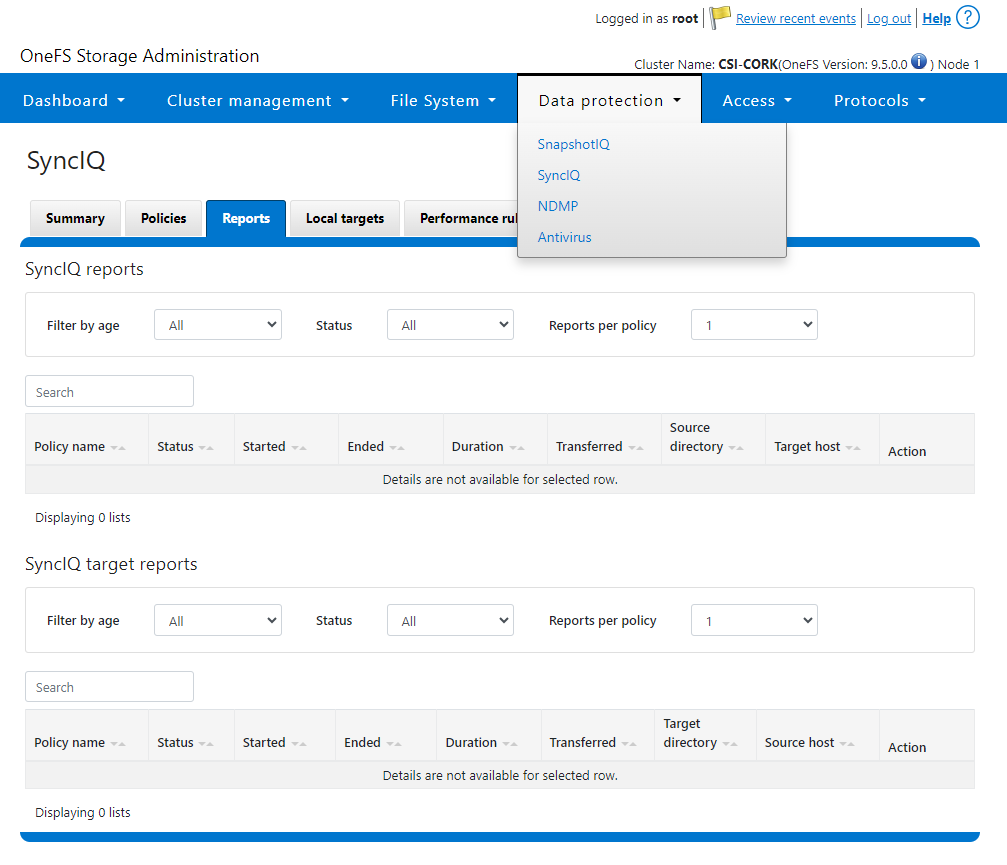
Following are the new modules introduced to enhance the Ansible automation of SyncIQ workflows:
- SyncIQCertificate (v2.3): Used to manage SyncIQ target cluster certificates on PowerScale. Functionality includes getting, importing, modifying, and deleting target cluster certificates. Here is the OneFS UI for these settings:
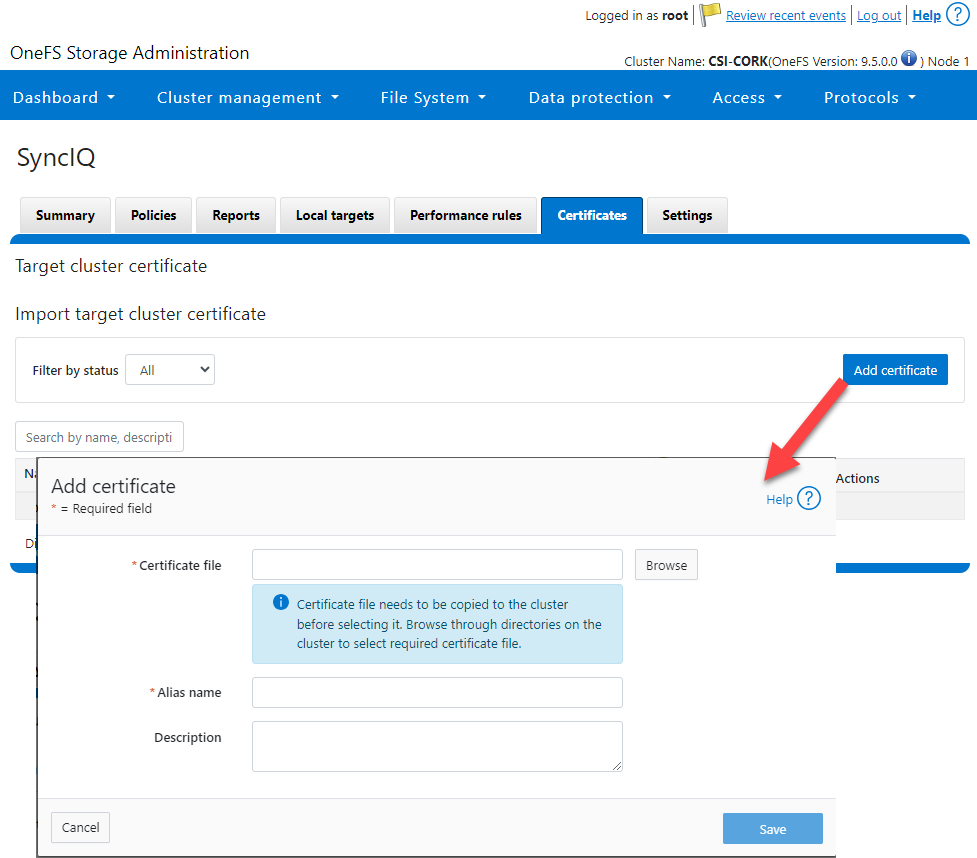
- SyncIQ_global_settings (v2.3): Used to configure SyncIQ global settings that are part of the include the following:
Table 1. SyncIQ settings
SyncIQ Setting (datatype) | Description |
bandwidth_reservation_reserve_absolute (int) | The absolute bandwidth reservation for SyncIQ |
bandwidth_reservation_reserve_percentage (int) | The percentage-based bandwidth reservation for SyncIQ |
cluster_certificate_id (str) | The ID of the cluster certificate used for SyncIQ |
encryption_cipher_list (str) | The list of encryption ciphers used for SyncIQ |
encryption_required (bool) | Whether encryption is required or not for SyncIQ |
force_interface (bool) | Whether the force interface is enabled or not for SyncIQ |
max_concurrent_jobs (int) | The maximum number of concurrent jobs for SyncIQ |
ocsp_address (str) | The address of the OCSP server used for SyncIQ certificate validation |
ocsp_issuer_certificate_id (str) | The ID of the issuer certificate used for OCSP validation in SyncIQ |
preferred_rpo_alert (bool) | Whether the preferred RPO alert is enabled or not for SyncIQ |
renegotiation_period (int) | The renegotiation period in seconds for SyncIQ |
report_email (str) | The email address to which SyncIQ reports are sent |
report_max_age (int) | The maximum age in days of reports that are retained by SyncIQ |
report_max_count (int) | The maximum number of reports that are retained by SyncIQ |
restrict_target_network (bool) | Whether to restrict the target network in SyncIQ |
rpo_alerts (bool) | Whether RPO alerts are enabled or not in SyncIQ |
service (str) | Specifies whether the SyncIQ service is currently on, off, or paused |
service_history_max_age (int) | The maximum age in days of service history that is retained by SyncIQ |
service_history_max_count (int) | The maximum number of service history records that are retained by SyncIQ |
source_network (str) | The source network used by SyncIQ |
tw_chkpt_interval (int) | The interval between checkpoints in seconds in SyncIQ |
use_workers_per_node (bool) | Whether to use workers per node in SyncIQ or not |
Additions to Info module
The following information fields have been added to the Info module:
- S3 buckets
- SMB global settings
- Detailed network interfaces
- NTP servers
- Email settings
- Cluster identity (also available in the Settings module)
- Cluster owner (also available in the Settings module)
- SNMP settings
- SynciqGlobalSettings
PowerStore Ansible collections 3.1: More NAS configuration
In this release of Ansible collections for PowerStore, new modules have been added to manage the NAS Server protocols like NFS and SMB, as well as to configure a DNS or NIS service running on PowerStore NAS.
Managing NAS Server interfaces on PowerStore
- file_interface - to enable, query, and modify PowerStore NAS interfaces. Some examples can be found here.
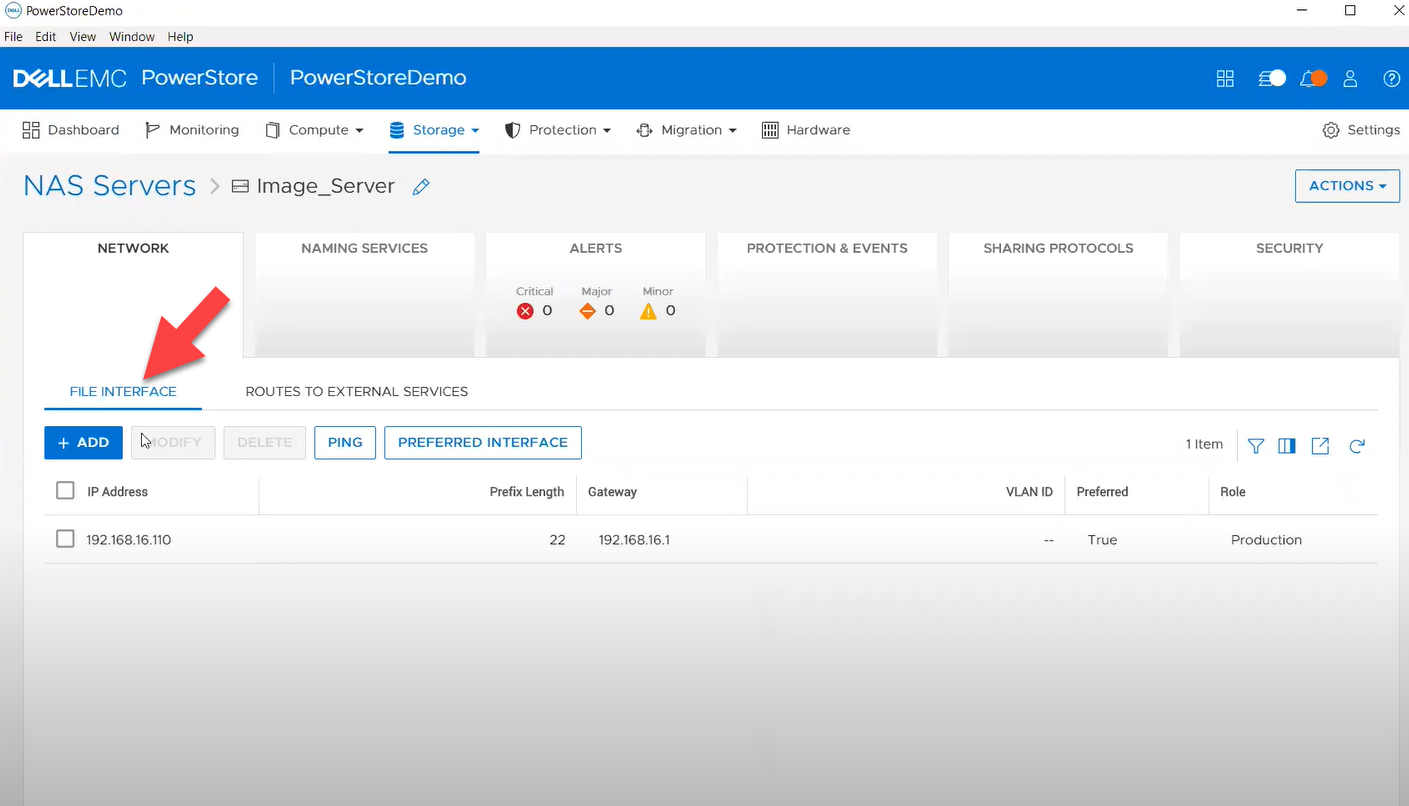
- smb_server - to enable, query, and modify SMB Shares on PowerStore NAS. Some examples can be found here.
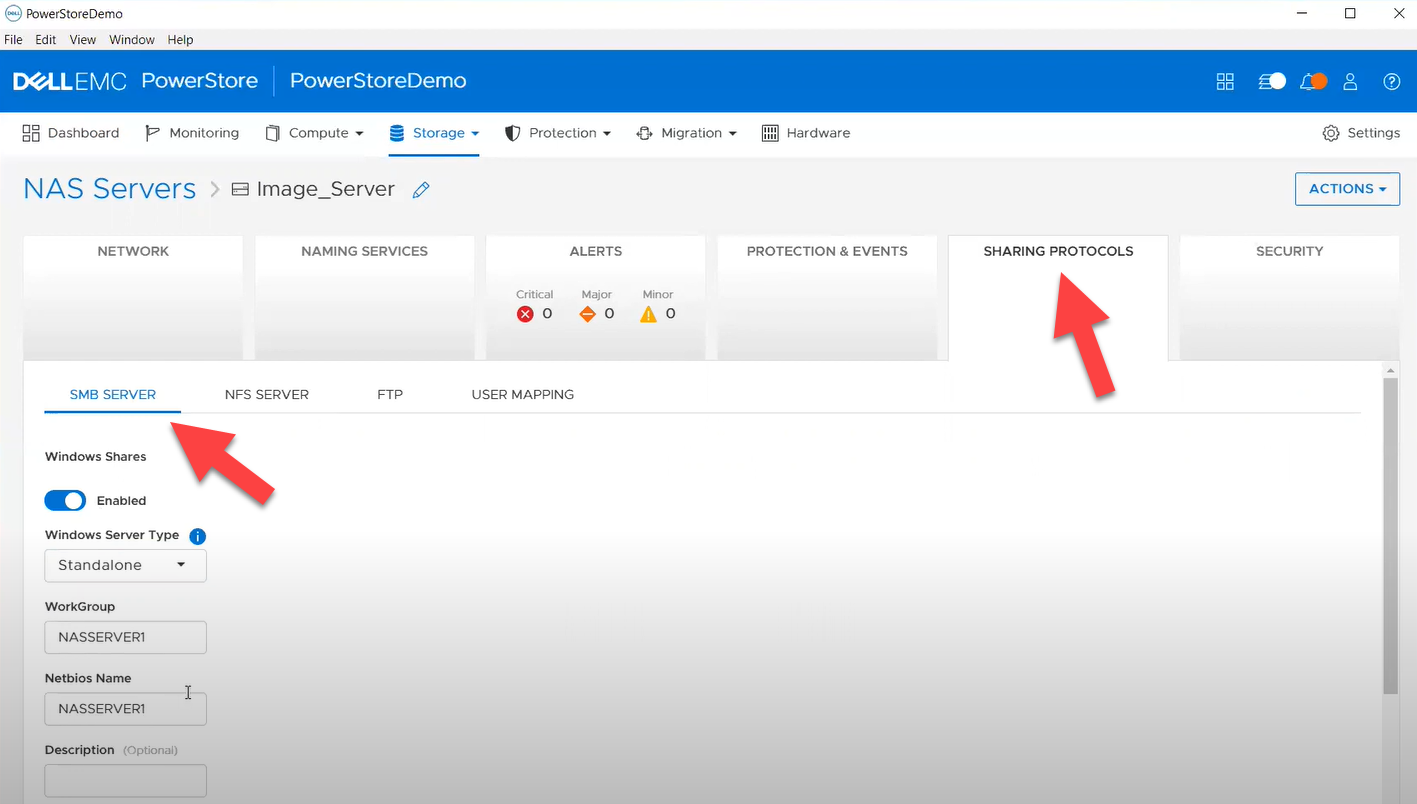
- nfs_server - to enable, query, and modify NFS Server on PowerStore NAS. Some examples can be found here.
Naming services on PowerStore NAS
- file_dns – to enable, query, and modify File DNS on PowerStore NAS. Some examples can be found here.
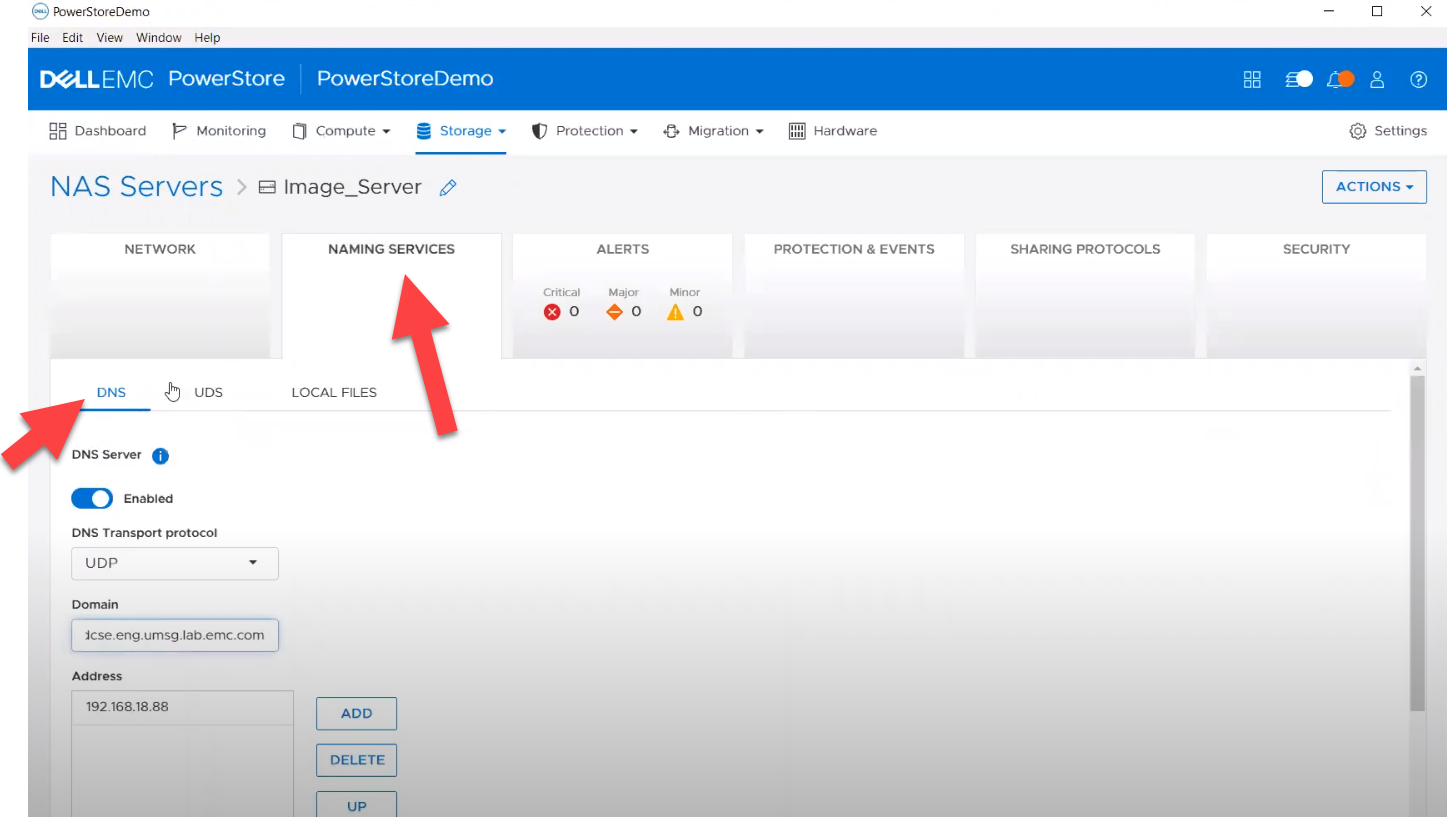
- file_nis - to enable, query, and modify NIS on PowerStore NAS. Some examples can be found here.
- service_config - manage service config for PowerStore
The Info module is enhanced to list file interfaces, DNS Server, NIS Server, SMB Shares, and NFS exports. Also in this release, support has been added for creating multiple NFS exports with same name but different NAS servers.
PowerFlex Ansible collections 2.0.1 and 2.1: More roles
In releases 1.8 and 1.9 of the PowerFlex collections, new roles have been introduced to install and uninstall various software components of PowerFlex to enable day-1 deployment of a PowerFlex cluster. In the latest 2.0.1 and 2.1 releases, more updates have been made to roles, such as:
- Updated config role to support creation and deletion of protection domains, storage pools, and fault sets
- New role to support installation and uninstallation of Active MQ
- Enhanced SDC role to support installation on ESXi, Rocky Linux, and Windows OS
OpenManage Ansible collections: More power to iDRAC
At the risk of repetition, OpenManage Ansible collections have modules and roles for both OpenManage Enterprise as well as iDRAC/Redfish node interfaces. In the last five months, a plethora of a new functionalities (new modules and roles) have become available, especially for the iDRAC modules in the areas of security and user and license management. Following is a summary of the new features:
V9.1
- redfish_storage_volume now supports iDRAC8.
- dellemc_idrac_storage_module is deprecated and replaced with idrac_storage_volume.
v9.0
- Module idrac_diagnostics is added to run and export diagnostics on iDRAC.
- Role idrac_user is added to manage local users of iDRAC.
v8.7
- New module idrac_license to manage iDRAC licenses. With this module you can import, export, and delete licenses on iDRAC.
- idrac_gather_facts role enhanced to add storage controller details in the role output and provide support for secure boot.
v8.6
- Added support for the environment variables, `OME_USERNAME` and `OME_PASSWORD`, as fallback for credentials for all modules of iDRAC, OME, and Redfish.
- Enhanced both idrac_certificates module and role to support the import and export of `CUSTOMCERTIFICATE`, Added support for import operation of `HTTPS` certificate with the SSL key.
v8.5
- redfish_storage_volume module is enhanced to support reboot options and job tracking operation.
v8.4
- New module idrac_network_attributes to configure the port and partition network attributes on the network interface cards.
Conclusion
Ansible is the most extensively used automation platform for IT Operations, and Dell Technologies provides an exhaustive set of modules and roles to easily deploy and manage server and storage infrastructure on-prem as well as on Cloud. With the monthly release cadence for both storage and server modules, you can get access to our latest feature additions even faster. Enjoy coding your Dell infrastructure!
Author: Parasar Kodati, Engineering Technologist, Dell ISG

Dell OpenManage Enterprise Operations with Ansible Part 3: Compliance, Reporting, and Remediation
Fri, 08 Dec 2023 15:37:49 -0000
|Read Time: 0 minutes
In case you missed it, check out the first post of this series for some background information on the openmanage Ansible collection by Dell and inventory management, as well as the second post to learn more about template-based deployment. In this blog, we’ll take a look at automating compliance and remediation workflows in Dell OpenManage Enterprise (OME) with Ansible.
Compliance baselines
Compliance baselines in OME are reports that show the ‘delta’ or difference between the specified desired configuration and the actual configuration of the various devices in the inventory. The desired configuration is specified as a compliance template, which can be cloned from either a deployment template or a device using the ome_template covered in the deployment section of this series. Following are task examples for creating compliance templates:
- name: Create a compliance template from deploy template
dellemc.openmanage.ome_template:
hostname: "{{ hostname }}"
username: "{{ username }}"
password: "{{ password }}"
validate_certs: no
command: "clone"
template_name: "email_deploy_template"
template_view_type: "Compliance"
attributes:
Name: "email_compliance_template"- name: Create a compliance template from reference device
dellemc.openmanage.ome_template:
hostname: "{{ hostname }}"
username: "{{ username }}"
password: "{{ password }}"
validate_certs: no
command: "create"
device_service_tag:
- "SVTG123"
template_view_type: "Compliance"
attributes:
Name: "Configuration Compliance"
Description: "Configuration Compliance Template"
Fqdds: "BIOS"Once we have the template ready, we can create the baseline, which is the main step where OME compares the template configuration to devices. Devices can be specified as a list or a device group. Depending on the number of devices, this step can be time-consuming. The following code uses a device group that has already been created, as shown in part 2 of this OME blog series:
- name: Create a configuration compliance baseline using an existing template
dellemc.openmanage.ome_configuration_compliance_baseline:
hostname: "{{ hostname }}"
username: "{{ username }}"
password: "{{ password }}"
validate_certs: no
command: create
template_name: "email_compliance_template"
description: "SNMP Email setting"
names: "baseline_email"
device_group_names: demo-group-allOnce the baseline task is run, we can retrieve the results, store them in a variable, and write the contents to a file for further analysis:
- name: Retrieve the compliance report of all of the devices in the specified configuration compliance baseline.
dellemc.openmanage.ome_configuration_compliance_info:
hostname: "{{ hostname }}"
username: "{{ username }}"
password: "{{ password }}"
validate_certs: no
baseline: "baseline_email"
register: compliance_report
delegate_to: localhost- name: store the variable to json
copy:
content: "{{ compliance_report | to_nice_json }}"
dest: "./output-json/compliance_report.json"
delegate_to: localhostOnce the compliance details are stored in a variable, we can always extract details from it, like the list of non-compliant devices shown here:
- name: Extract service tags of devices with highest level compliance status
set_fact:
non_compliant_devices: "{{ non_compliant_devices | default([]) + [device.Id] }}"
loop: "{{ compliance_report.compliance_info }}"
loop_control:
loop_var: device
when: device.ComplianceStatus > 1
no_log: trueRemediatation
The remediation task brings all devices to a desired template configuration, much like the template deployment job. For remediation, we use the same baseline module with command set to remediate and pass all devices we would like to remediate, as well as the list of devices that are non-compliant:
- name: Remediate a specified non-complaint devices to a configuration compliance baseline using device IDs # noqa: args[module]
dellemc.openmanage.ome_configuration_compliance_baseline:
hostname: "{{ hostname }}"
username: "{{ username }}"
password: "{{ password }}"
validate_certs: no
command: "remediate"
names: "baseline_email"
device_ids: "{{ non_compliant_devices }}"
when: "non_compliant_devices | length > 0"
delegate_to: localhostWatch the following video to see in-depth how the different steps of this workflow are run:
Conclusion
To recap, we’ve covered the creation of compliance templates and running baseline checks against your PowerEdge server inventory. We then saw how to retrieve detailed compliance reports and parse them in Ansible for further analysis. Finally, using the OME baseline Ansible, we ran a remediation job to correct any configuration drift in non-compliant devices. Don’t forget to check out the detailed documentation for openmanage Ansible modules including both OME and iDRAC/redfish modules and roles, as well as the complete code examples used here in this GitHub repository.
Author: Parasar Kodati, Engineering Technologist, Dell ISG

Dell OpenManage Enterprise Operations with Ansible Part 2: Templates and Deployment
Mon, 04 Dec 2023 16:30:25 -0000
|Read Time: 0 minutes
In case you missed it, check out the first part of this blog series for some background on the openmanage Ansible collection by Dell. In this post, we’ll take a look at template based deployment in OME driving from Ansible.
Template based deployment
Templates in OME are a great way to define the exact configuration that you would like to replicate on a group of servers. You can collect devices into multiple groups based on the workload profile and apply templates on these groups to achieve identical configurations based on security, performance, and other considerations.
To retrieve template information, you can use the dellemc.openmanage.ome_template_info module to query templates based on a variety of system_query _options. You can pass filter parameters as shown here:
- name: Get filtered template info based on name.
dellemc.openmanage.ome_template_info:
hostname: "{{ hostname }}"
username: "{{ username }}"
password: "{{ password }}"
validate_certs: no
system_query_options:
filter: "Name eq 'empty_template'"
register: template_info
- name: print template info
debug:
msg: "{{template_info}}"Template creation
One way to create a template is by using an existing device configuration. You can also create a template by cloning an existing template and then modifying the parameters as necessary. Following are the Ansible tasks for each respective method:
- name: Create a template from a reference device.
dellemc.openmanage.ome_template:
hostname: "{{ hostname }}"
username: "{{ username }}"
password: "{{ password }}"
validate_certs: no
device_service_tag: "{{device_service_tag}}"
attributes:
Name: "{{device_service_tag}}-template"
Description: "ideal Template description"
- name: Clone a template
dellemc.openmanage.ome_template:
hostname: "{{ hostname }}"
username: "{{ username }}"
password: "{{ password }}"
validate_certs: no
command: "clone"
template_name: "empty_template"
attributes:
Name: "deploy_clone"
delegate_to: localhostTemplate Attribute list
Very often as part of day-2 operations you may have to change a set of attributes, which can be difficult given that a template is a very detailed object with thousands of parameters. To see what parameters are available to modify in a template, we must get the complete list of parameters using a REST API call. In the following example, we first establish an API connection and then make a call to api/TemplateService/Templates(11)/Views(1)/AttributeViewDetails. We then store this information in a JSON file for further exploration and parsing:
- name: Get PowerScale API Session Token
ansible.builtin.uri:
url: "https://{{ hostname }}/api/SessionService/Sessions"
method: post
body_format: json
validate_certs: false
status_code: 200,201
body: |
{
"UserName": "{{ username }}",
"Password": "{{ password }}",
"SessionType":"API"
}
register: api_response
tags: "api-call"
- name: Store API auth token
ansible.builtin.set_fact:
ome_auth_token: "{{ api_response.x_auth_token }}"
tags: "api-call"
- name: Get attribute details
uri:
url: "https://{{ hostname }}/api/TemplateService/Templates(11)/Views(1)/AttributeViewDetails"
validate_certs: false
method: get
#body_format: json
#body: |
# {"privileges":{{ admin_priv.json.privileges }}}
headers:
X-Auth-Token: "{{ ome_auth_token }}"
status_code: 200,201,204,409
register: api_output
- name: Save device_info to a file
copy:
content: "{{ api_output | to_nice_json }}"
dest: "./output-json/api_output.json"Once we have the JSON file with the complete set of attributes, we can find the exact attribute we want to modify. Given the attribute JSON file can span thousands of lines, we can use a simple python script to run a quick search of the attributes file based on keywords. Here are a few lines that can retrieve all the attributes containing Email:
import json
with open('./output-json/api_output.json') as f:
data = json.load(f)
for item in data['json']['AttributeGroups'][0]['SubAttributeGroups']:
if item['DisplayName'].find("Email") >-1:
print('\n')
print(item['DisplayName'])
print('-------------------------')
for subitem in item['Attributes']:
print(subitem['DisplayName'])Once we have the attribute that needs to be modified, we can use the ome_template module with (a) command set to modify and (b) attribute name and value set as follows:
- name: Modify template
dellemc.openmanage.ome_template:
hostname: "{{ hostname }}"
username: "{{ username }}"
password: "{{ password }}"
validate_certs: no
command: "modify"
template_name: "deploy_clone"
attributes:
Attributes:
- DisplayName: 'iDRAC, RAC Email Alert, EmailAlert 1 Email Alert Address'
Value: "world123@test.com"Device grouping and deployment
To apply templates to multiple devices, we can create device groups and then apply the deployment template for the entire group. To add devices to a group, you can create an array of devices. Here, I am passing the entire set of devices that I queried using ome_device_info:
- name: Retrieve basic inventory of all devices.
dellemc.openmanage.ome_device_info:
hostname: "{{ hostname }}"
username: "{{ username }}"
password: "{{ password }}"
validate_certs: no
register: device_info_result
- name: get all service tags
set_fact:
service_tags: "{{ service_tags + [item.DeviceServiceTag] }}"
loop: "{{ device_info_result.device_info.value }}"
no_log: true
- name: Create a device group
dellemc.openmanage.ome_groups:
hostname: "{{ hostname }}"
username: "{{ username }}"
password: "{{ password }}"
validate_certs: no
name: "demo-group-all"
- name: Add devices to a static device group
dellemc.openmanage.ome_device_group:
hostname: "{{ hostname }}"
username: "{{ username }}"
password: "{{ password }}"
validate_certs: no
name: "demo-group-all"
device_service_tags: "{{service_tags}}"Now, we are ready to deploy our template to the device group we created using the same ome_template module but with command set to deploy:
- name: Deploy template on groups
dellemc.openmanage.ome_template:
hostname: "{{ hostname }}"
username: "{{ username }}"
password: "{{ password }}"
validate_certs: no
command: "deploy"
template_name: "deploy_clone"
device_group_names:
- "deploy_group" You can watch the following video to see in depth how the different steps of the workflow are run:
Conclusion
To recap, we’ve covered how to create templates, query and find the available attributes we can modify, and then modify them in a template, as well as how to group devices and deploy templates to those groups. You can find the code mentioned in this blog on GitHub as part of this Automation examples repo.
Author: Parasar Kodati, Engineering Technologist, Dell ISG

Generative AI Tools for Infrastructure As Code Practitioners
Fri, 01 Dec 2023 15:32:51 -0000
|Read Time: 0 minutes
Today, Infrastructure as code is a mainstream technology used extensively by DevOps and ITOps engineers to manage dynamic IT environments consisting of data, applications, and infrastructure with increasing scale, complexity, and diversity. With a GitOps driven workflow, engineers can bring much needed standardization, security, and operational consistency across diverse environments. While there are a multitude of compelling reasons to embrace IaC, one innovation tips the scales toward a resounding yes, and that is generative AI. When coding assistants were released throughout this year, there was some skepticism around the accuracy of generated code, however this game-changing technology is evolving rapidly and becoming a key enabler for IaC, transforming it from a best practice to an indispensable strategy.
In this blog post, we'll explore some of the specific tools under the GenAI umbrella and how they can help you accelerate your workflows, learning, and even your career! Given how OpenAI has been leading the industry with generative AI tools like ChatGPT, I am going to refer to many of the specific tools from OpenAI. That said, many broad GenAI capabilities are possible with other capable large language models. To learn more, check out this great whitepaper on building general purpose LLM environments by my colleagues at Dell.
Code generation
If I have to choose between a monthly haircut or a generative code assistant subscription, I would choose the latter. Tools like GitHub copilot are becoming indispensable no matter which programming language or framework you use. These tools cut down the time it takes to create the building blocks of code necessary for automating tasks, so elegantly generated that you will not find a single line of generated code without a meaningful comment that your high school English teacher would be proud of. Examples of how this can help are shown in this Ansible for OpenManage Enterprise video.
Code interpretation
Large Language Models or LLMs are capable of interpreting code from a wide variety of programming languages thanks to their extensive training with millions of lines of code. This code interpretation is another huge capability where you can prompt the models with code, often easier than plain English. This can be especially helpful when refactoring code or when engineers are tasked with understanding and improving upon existing automation scripts. Following is a quick example where I generated the Ansible equivalent of good old Shell script using the latest ChatGPT 4 model.
Shell script input to create compressed backup of a folder:
#!/bin/bash # Set the directory to back up and the backup location DIRECTORY_TO_BACKUP="/home/user/data" BACKUP_LOCATION="/backup" TIMESTAMP=$(date +"%F") BACKUP_FILE="backup-$TIMESTAMP.tar.gz" # Create the backup tar -czf $BACKUP_LOCATION/$BACKUP_FILE $DIRECTORY_TO_BACKUP # Check if the backup was successful if [ $? -eq 0 ]; then echo "Backup completed successfully." else echo "Backup failed." >&2 fi
Ansible output I got the first time:
---
- name: Create Backup of Directory
hosts: all
tasks:
- name: Create backup file
ansible.builtin.archive:
path: /home/user/data
dest: /backup/backup-{{ ansible_date_time.iso8601_basic_short }}.tar.gz
format: gzOutput received when I prompted the model for a more structured code block with variables:
---
- name: Create Backup of Directory with Variables
hosts: all
vars:
backup_source: /home/user/data # Define the source directory to back up
backup_destination: /backup # Define the backup destination directory
backup_filename: "backup-{{ ansible_date_time.iso8601_basic_short }}.tar.gz" # Backup filename with a timestamp
tasks:
- name: Create backup directory if it does not exist
ansible.builtin.file:
path: "{{ backup_destination }}"
state: directory
mode: '0755'
- name: Create backup file
ansible.builtin.archive:
path: "{{ backup_source }}"
dest: "{{ backup_destination }}/{{ backup_filename }}"
format: gzThe latest ChatGPT interface supports attaching files, so you don’t even have to copy-paste code for refactoring. Simply organize the files and attach them to your prompt.
Error analysis and debugging
If you think copy-pasting error messages into Stack Overflow is the best way to debug, think again. LLM-based code interpreter tools can analyze error messages and logs and, in many cases, identify the root causes for frequently occurring issues. This applies to any code, including Ansible playbooks and Terraform modules, where an LLM can swiftly recommend fixes, link to the relevant documentation, or even automate the resolution process in some cases.
Prompt engineering
If you think the term “prompt engineering” is just to make fun of GenAI tools, it’s time for a reframe in perspective. Prompting has become a critical factor in determining the accuracy of responses from LLMs. The more specific and detailed the prompt, the more useable the response. Here are some Infrastructure as code examples:
"I am working on a Terraform project where I need to provision an AWS EC2 instance with specific requirements: it should be of type 't2.micro', within the 'us-east-1' region, and include tags for 'Name' as 'MyInstance' and 'Environment' as 'Development'. Could you provide me with the Terraform code snippet that defines this resource?"
"I need to create an Ansible playbook that performs a common operation: updating all packages on a group of Ubuntu servers. The playbook should be idempotent and only target servers in the 'webservers' group. It must also restart the 'nginx' service only if the updates require a restart. Can you generate the YAML code for this playbook?"
And, if you are on a mission to change the world with Automation, maybe something like this:
"For my automation scripts using Python in a DevOps context, I require a robust error handling strategy that logs errors to a file and sends an email notification when a critical failure occurs. The script is meant to automate the deployment process. Could you provide a Python code sample that demonstrates this error handling? Here is the code: <your python code>"
So, if needed, skip the coffee a few times or a haircut, but please let a code assistant help you.
Your own GPT
Already have a ChatGPT tab in your browser at all times? Already a prompting machine? There is more you can do with GenAI than just ‘plain’ (very interesting how quickly this technology is becoming table stakes and commoditized) code generation.
Thanks to the recently announced GPTs and Assistant API by OpenAI, you can create a tailor-built model that is significantly faster and more precise in responses. You can train GPT models with anything from a policy document to coding guidelines to a sizing calculator for your IT infrastructure and have chat bots use these backend models to answer queries from customers or internal stakeholders. Please note that this does have a cost associated with it depending on the number of clients and usage. Please visit the OpenAI website to check out various plans and pricing. While we won’t go into detail on the topic in this particular blog, let me lay out the key elements that make up a custom GPT:
- Code Interpreter
- Knowledge Retrieval
- Your own functions
Code interpreter
This is not much different from the coding capabilities of ChatGPT or GitHub copilot. In the context of creating custom GPTs, you can basically check this as a required tool. You may ask, “why do you even have to select this foundational feature?” Put simply, it’s because of the pay-for-what-you-use pricing model in which users who don’t need this capability can uncheck it.
Knowledge retrieval
AI-powered knowledge retrieval systems can instantly pull up relevant technical documentation and best practices that are pertinent to the task at hand, whether it's crafting an Ansible playbook or defining resources in Terraform. This immediate access to information accelerates the development process and aids in maintaining industry standards across both platforms. Stay tuned for examples in future blog posts.
Your own functions
If you have already built scripts and routines to compute or make decisions, you can incorporate them into your custom GPT as well. I recently saw an example where an ROI calculator for switching to solar power had been incorporated into a chat bot to help customers visiting their website evaluate the switch to solar. Your GPT can be a sizer tool or a performance benchmarking tool for the end user for which you are building it.
Proprietary and sensitive data
While LLMs are the best thing to happen to programmers in a long time, one should exercise extreme caution when using data that is not publicly available to train AI models. Depending on the use case, extensive guard rails must be put in place when using sensitive data or proprietary data in your prompts or knowledge documents for training. If such guard rails do not exist in your organization, consider championing to create them and be a part of the process of helping your organization achieve a greater degree of maturity in AI adoption.
Dell and AI
Dell has been at the forefront of the GenAI revolution as the leading infrastructure provider for Artificial Intelligence solutions for the enterprise. Check out this insightful talk on Dell AI strategy by CTO John Roese that goes over A-in, AI-on, AI-for and AI-with aspects of Dell’s approach. Following are more resources to learn about infrastructure setup for LLM training and deployment in particular:
- Blog: Dell and Meta Collaborate to Drive Generative AI Innovation
- White Paper: Llama 2: Inferencing on a Single GPU
- Design Guide: Generative AI in the Enterprise – Inferencing
Author: Parasar Kodati, Engineering Technologist, Dell ISG

Dell OpenManage Enterprise Operations with Ansible Part 1: Inventory Management
Tue, 14 Nov 2023 14:36:09 -0000
|Read Time: 0 minutes
The OpenManage collection
Dell OpenManage Enterprise (OME) is a powerful fleet management tool for managing and monitoring Dell PowerEdge server infrastructure. Very recently, Dell announced OME 4.0, complete with a litany of new functionality that my colleague Mark detailed in another blog. Here, we'll explore how to automate inventory management of devices managed by OME using Ansible.
Prerequisites
Before we get started, ensure you have Ansible and Python installed on your system. Additionally, you will need to install Dell’s openmanage Ansible collection from Ansible Galaxy using the following command:
ansible-galaxy collection install dellemc.openmanage
The source code and examples for the openmanage collection can be found on GitHub as well. Note that this collection includes modules and roles for iDRAC/Redfish interfaces as well as modules for OpenManage Enterprise with complete fleet management workflows. In this blog, we will look at examples from the OME modules within the collection.
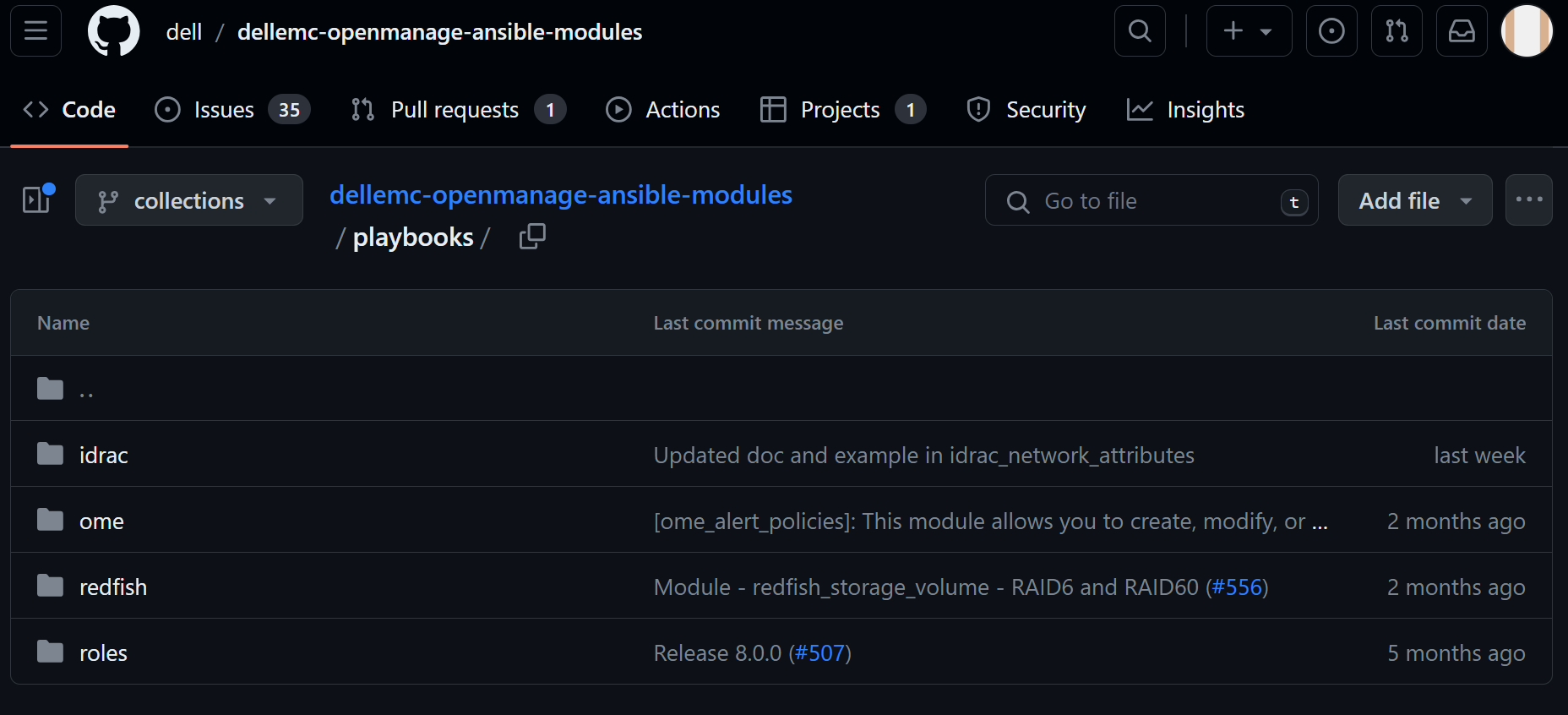
Figure 1. Dell openmanage ansible modules on GitHub
Inventory management workflows
Inventory management typically involves gathering details like the different devices under management, their health information, and so on. The dellemc.openmanage.ome_device_info is the optimal module for collecting the most information. Let’s dig into some tasks to get this information.
Retrieve basic inventory
This task retrieves basic inventory information for all devices managed by OME:
- name: Retrieve basic inventory of all devices
dellemc.openmanage.ome_device_info:
hostname: "{{ hostname }}"
username: "{{ username }}"
password: "{{ password }}"
validate_certs: no
register: device_info_resultOnce we have the output of this captured in a variable like device_info_result, we can drill down into the object to retrieve data like the number of servers and their service tags and print such information using the debug task:
- name: Device count
debug:
msg: "Number of devices: {{ device_info_result.device_info.value | length }}" - name: get all service tags
set_fact:
service_tags: "{{ service_tags + [item.DeviceServiceTag] }}"
loop: "{{ device_info_result.device_info.value }}"
no_log: true - name: List service tags of devices
debug:
msg: "{{ service_tags }}"Note that device_info_result is a huge object. To view all the information that is available to extract, write the contents of the variable to a JSON file:
- name: Save device_info to a file
copy:
content: "{{ device_info_result | to_nice_json }}"
dest: "./output-json/device_info_result.json"Subsystem health
Subsystem health information is another body of information that is extremely granular. This information is not part of the default module task. To get this data, we need to explicitly set the fact_subsystem option to subsystem_health. Following is the task to retrieve subsystem health information for devices identified by their service tags. We pass the entire array of service tags to get all the information at once:
- name: Retrieve subsystem health of specified devices identified by service tags.
dellemc.openmanage.ome_device_info:
hostname: "{{ hostname }}"
username: "{{ username }}"
password: "{{ password }}"
validate_certs: no
fact_subset: "subsystem_health"
system_query_options:
device_service_tag: "{{ service_tags }}"
register: health_info_resultUsing the register directive, we loaded the subsystem health information into the variable health_info_result. Once again, we recommend writing this information to a JSON file using the following code in order to see the level of granularity that you can extract:
- name: Save device health info to a file
copy:
content: "{{ health_info_result | to_nice_json }}"
dest: "./output-json/health_info_result.json"To identify device health issues, we loop through all the devices with the service_tags variable and check if there are any faults reported for each device. When faults are found, we store the fault information into a dictionary variable, shown as the inventory_issues variable in the following code. The dictionary variable has three fields: service tag, fault summary, and the fault list. Note that the fault list itself is an array containing all the faults for the device:
- name: Gather information for devices with issues
set_fact:
inventory_issues: >
{{
inventory_issues +
[{
'service_tag': item,
'fault_summary': health_info_result['device_info']['device_service_tag'][service_tags[index]]['value'] | json_query('[?FaultSummaryList].FaultSummaryList[]'),
'fault_list': health_info_result['device_info']['device_service_tag'][service_tags[index]]['value'] | json_query('[?FaultList].FaultList[]')
}]
}}
loop: "{{ service_tags }}"
when: " (health_info_result['device_info']['device_service_tag'][service_tags[index]]['value'] | json_query('[?FaultList].FaultList[]') | length) > 0"
loop_control:
index_var: index
no_log: trueIn the next task, we loop through the devices with issues and gather more detailed fault information for each. The tasks to perform this extraction are included in an external task file named device_issues.yml which is run for every member of the inventory_issues dictionary. Note that we are passing device_item and device_index as variables for each iteration of device_issues.yml:
- name: Gather fault details
include_tasks: device_issues.yml
vars:
device_item: "{{ item }}"
device_index: "{{ index }}"
loop: "{{ inventory_issues }}"
loop_control:
index_var: index
no_log: trueWithin the device_issues.yml, we first initialize a dictionary variable that can gather information about the faults for the device. The variable captures the subsystem, fault message, and the recommended action:
- name: Initialize specifics structure
set_fact:
current_device:
{
'service_tag': '',
'subsystem': [],
'Faults': [],
'Recommendations':[]
}We loop through all the faults for the device and populate the objects of the dictionary variable:
- name: Assign fault specifics
set_fact:
current_device:
service_tag: "{{ device_item.service_tag }}"
Faults: "{{ current_device.Faults + [fault.Message] }}"
Recommendations: "{{ current_device.Recommendations + [fault.RecommendedAction] }}"
loop: "{{ device_item.fault_list }}"
loop_control:
loop_var: fault
when: device_item.fault_list is defined
no_log: trueWe then append to a global variable that is aggregating the information for all the devices:
- name: Append current device to all_faults
set_fact:
fault_details: "{{ fault_details + [current_device] }}"Back to the main YML script, once we have all the information captured in fault_details, we can print the information we need to store to a file:
- name: Print fault details
debug:
msg: "Fault details: {{ item.Faults }}"
loop: "{{ fault_details }}"
loop_control:
label: "{{ item.service_tag }}" - name: Print recommendations
debug:
msg: "Recommended actions: {{ item.Recommendations }}"
loop: "{{ fault_details }}"
loop_control:
label: "{{ item.service_tag }}"Check out the following video to see how the different steps of the workflow are run:
Conclusion
To recap, we looked at the various information gathering tasks within inventory management of a large PowerEdge server footprint. Note that I used health information objects to demonstrate how to drill down to find the information you need, however you can do this with any fact subset that can retrieved using the dellemc.openmanage.ome_device_info module. You can find the code from this blog on GitHub as part of this Automation examples repo.
Author: Parasar Kodati, Engineering Technologist, Dell ISG

Q3 2023: New and Updated Terraform Providers for Dell Infrastructure
Mon, 02 Oct 2023 12:49:02 -0000
|Read Time: 0 minutes
We just concluded three quarters of Terraform provider development for Dell infrastructure, and we have some exciting updates to existing providers as well as two brand new providers for PowerScale and PowerEdge node (Redfish-interface) workflows! You can check out the first two releases of Terraform providers here: Q1-2023 and Q2-2023.
We are excited to announce the following new features for the Terraform integrations for Dell infrastructure:
- NEW provider! v1.0 of the provider for PowerScale
- v1.2 of the provider for PowerFlex
- v1.0 of the provider for PowerMax
- NEW provider! v1.0 Terraform Provider for Redfish v1.0.0
- v1.1 Terraform Provider for OME
Terraform Provider for PowerScale v1.0
The first version of the PowerScale provider has a lot of net new capabilities in the form of new resources and data sources. Add to that a set of examples and utilities for AWS deployment, there is enough great material to have its own blog post. Please see this post--Introducing Terraform Provider for Dell PowerScale--all the details.
Terraform Provider for PowerFlex v1.2: it’s all about day-1 deployment
Day-1 deployment refers to the initial provisioning and configuration of hardware and software resources before any production workloads are deployed. A successful Day-1 deployment sets the foundation for the entire infrastructure's performance, scalability, and reliability. However, Day-1 deployment can be complex and time-consuming, often involving manual tasks, potential errors, and delays. This is where automation and the Dell PowerFlex Terraform Provider come into play.
Dell PowerFlex is the software defined leader of the storage industry, providing the foundational technology of Dell’s multicloud infrastructure as well as APEX Cloud Platforms variants for OpenShift and Azure. PowerFlex was the first platform in Dell’s ISG portfolio to have a Terraform provider. In the latest v1.2 release, the provider leapt forward in day-1 deployment operations of a PowerFlex cluster, now providing:
- New resource and data source for Cluster
- New resource and data source for MDM Cluster
- New resource and data source for User Management
- New data source for vTree (PowerFlex Volume Tree)
Now we’ll get into the details pertaining to these new features.
New resource and data source for Cluster
The cluster resource and data source are at the heart of day-1 deployment as well as ongoing cluster expansion and management. Cluster resource can be used to deploy or destroy 3- or 5-node clusters. Please refer the more detailed PowerFlex deployment guide here. The resource deploys all the foundational components of the PowerFlex architecture:
- Storage Data Client (SDC) -- consumes storage from the PowerFlex appliance
- Storage Data Server (SDS) -- contributes node storage to PowerFlex appliance
- Metadata Manager (MDM) -- manages the storage blocks and tracks data location across the system
- Storage Data Replication (SDR) -- enables native asynchronous replication on PowerFlex nodes
Following are the key elements of this resource:
- cluster for Cluster Installation Details
- lia_password for Lia Password
- mdm_password for MDM Password
- allow_non_secure_communication_with_lia to allow Non-Secure Communication With Lia
- allow_non_secure_communication_with_mdm to Allow Non-Secure Communication With MDM
- disable_non_mgmt_components_auth to Disable Non Mgmt Components Auth
- storage_pools for Storage Pool Details
- mdm_list for Cluster MDM Details
- protection_domains for Cluster Protection Domain Details
- sdc_list for Cluster SDC Details
- sdr_list for Cluster SDR Details
- sds_list for Cluster SDS Details
You can destroy a cluster but cannot update it. You can also import an existing cluster using the following command:
terraform import "powerflex_cluster.resource_block_name" "MDM_IP,MDM_Password,LIA_Password"You can find example of a complete cluster resource definition here.
New resource and data source for MDM Setup
Out of the core architecture components of PowerFlex, we already have resources for SDC and SDS. The MDM resource is for the ongoing management of the MDM cluster and has the following key parameters for the Primary, Secondary, Tie-breaker, and Standby nodes:
- Node ID
- Node name
- Node port
- IPs of the MDM type
- The management IPs for the MDM node type
- While the Standby MDM is optional, it does require the role parameter to be setup to one of [‘Manager’, ‘TieBreaker’]
You can find multiple examples of using MDM cluster resource here.
New resource and data source for User Management
With the User resource, you can perform all Create, Read, Update, and Delete (CRUD) operations as well as import existing users that are part of a PowerFlex cluster.
To import users, you can use any one of the following import formats:
terraform import powerflex_user.resource_block_name “<id>”or
terraform import powerflex_user.resource_block_name “id:<id>”or by username
terraform import powerflex_user.resource_block_name “name:<user_name>”New data source for vTree (PowerFlex Volume Tree)
Wouldn’t it be great to get all the storage details in one shot? The vTree data source is a comprehensive collection of the required storage volumes and their respective snapshot trees that can be queried using an array of the volume ids, volume names, or the vTree ids themselves. The data source returns vTree migration information as well.
You can find examples of specifying the query details for vTree data source here.
Terraform Provider for PowerMax v1.0
The PowerMax provider went through two beta versions, and we now have the official v1.0. While it’s a small release for the PowerMax provider, there is no arguing the importance of creating, scheduling, and managing snapshots on the World’s most secure mission-critical storage for demanding enterprise applications[1].
Following are the new PowerMax resources and data sources for this release:
- CRUD operations for snapshots-- including support for Secure snapshots.
- Here are examples of the new resource and data source.
- CRUD operations for snapshot policies-- ensure operational SLAs and data protection and retention compliance.
- Here are examples of the new resource and data source.
- CRUD operations for port group objects-- enable end-to-end provisioning workflow automation in Terraform with the existing resources for storage groups, host groups, and masking views.
- Here are examples of how to use the new resource and the data source for port groups.
New Terraform Provider for PowerEdge nodes (Redfish interface)
In addition to the comprehensive fleet management capabilities of OpenManage Enterprise UI, REST API, Ansible collections, and Terraform Provider, Dell has an extensive programmable interface at the node level with the iDRAC interface, Redfish-compliant API, and Ansible collections.
We are also introducing a Terraform provider called redfish to manage individual servers:
terraform {
required_providers {
redfish = {
version = "1.0.0"
source = "registry.terraform.io/dell/redfish"
}
}
}With this introduction, we now have the complete programmatic interface matrix for PowerEdge server management:
| OpenManage Enterprise | iDRAC/RedFish |
REST API | ✔ | ✔ |
Ansible collections | ✔ | ✔ |
Terraform Providers | ✔ | ✔ |
With the new Terraform Provider for Redfish interface for Dell PowerEdge servers, you can automate and manage server power cycles, iDRAC attributes, BIOS attributes, virtual media, storage volumes, user support, and firmware updates on individual servers. This release adds support for these functionalities and is the first major release of the Redfish provider.
The following resources and data resources are available to get and set the attributes related to the particular attribute groups:
- Power management resource
- iDRAC Attributes resource
- BIOS resource
- Storage Volume resource
- Virtual Media resource
- User account resource
- Simple Update resource
- In addition to the data source corresponding to the attribute groups, two new data sources for Firmware Inventory and System Boot have also been added. Here you can find the examples of all the data sources for the Redfish provider.
Terraform Provider for OME v1.1
In this release of the Terraform Provider for OpenManage Enterprise (OME), multiple resource have been added for device management and security. Following is a list of resources in Terraform provider for Dell OME:
Device discovery and management
New resources under device discovery and management:
- New Discovery resource for automated discovery of devices to be managed.
- New Devices resource to maintain the state of individual devices that are under OME management. Removing the device from the state will take the device out of OME management. The release includes the corresponding data source for devices.
- New Device Action resource.
- New Static Group resource to group devices for easier deployment and compliance.
Security
- New Application CSR resource for Certificate Signing Requests.
- New Application Certificate resource for providing authentication certificate.
- New User resource for performing CRUD operations for OME users.
- New OME Appliance Network resource.
Check out the corresponding data sources for these resources for more information.
Resources
Here are the link sets for key resources for each of the Dell Terraform providers:
- v1.0 of the provider for PowerScale
- v1.0 of the provider for PowerMax
- v1.2 of the provider for PowerFlex
- v1.1 of the provider for PowerStore
- Terraform Provider for Redfish v1.0.0
- Terraform Provider for OME v1.1
[1] Based on Dell internal analysis of cybersecurity capabilities of Dell PowerMax versus cybersecurity capabilities of competitive mainstream arrays supporting open systems and mainframe storage, April 2023
Author: Parasar Kodati, Engineering Technologist, Dell ISG

Introducing Terraform Provider for Dell PowerScale
Mon, 02 Oct 2023 12:47:27 -0000
|Read Time: 0 minutes
PowerScale is industry’s leading scale-out NAS platform, so extensively deployed that very soon we’ll be talking about Zetabytes of deployment. With one of the most extensive REST API libraries including management and data services, PowerScale has the second largest number of Ansible module downloads in Dell infrastructure, second only to openmanage collection. With its availability on AWS, the time for Terraform provider for PowerScale has arrived.
As part of the Terraform provider Q3-release, we are proud to introduce the new provider for Dell PowerScale! Additionally, now that PowerScale is available on AWS, I am thrilled to tell you about the new set of Terraform utilities and examples aimed to simplify PowerScale deployment on AWS.
Let’s dive right in.
Resources and data sources of PowerScale Provider
Here is how to initialize PowerScale provider and specify details of your OneFS instance:
terraform {
required_providers {
powerscale = {
source = "registry.terraform.io/dell/powerscale"
}
}
}
provider "powerscale" {
username = var.username
password = var.password
endpoint = var.endpoint
insecure = var.insecure
}In the very first release of PowerScale provider, we are introducing resources and data sources for entities related to:
- User and access management
- Data management
- Cluster management
User and access management
In this release of the provider, there are four sets of resources and data sources for user and access management:
AccessZone
AccessZones establish clear boundaries within a PowerScale cluster, delineating access for the purposes of multi-tenancy or multi-protocol support. They govern the permission or restriction of entry into specific regions of the cluster. Additionally, at the Access Zone level, authentication providers are set up and configured. Here is how you can manage Access Zones as resources and get information about them using the corresponding data source.
Users
The Users resource and data source roughly correspond to the Users REST API resource of PowerScale.
User groups
The User groups resource and data source roughly correspond to the Groups REST API resource of PowerScale.
Active Directory
The Active Directory resource and data source roughly correspond to the ADS Providers REST API resource of PowerScale.
Data Management
For data management, we are introducing resources and data sources for File System, NFS Exports, and SMB Shares in this release.
File system
NFS exports
SMB shares
Cluster Management
This datasource is used to query the existing cluster from PowerScale array. The information fetched from this data source can be used for getting the details, including config, identity, nodes, internal_networks and acs.
Day-1 Deployment on AWS
PowerScale on AWS offers customers an extremely performant and secure NAS platform for data intensive workloads on the cloud. There are many AWS Terraform modules to configure access management (IAM) and networking (VPC, Security Groups etc.) that can easily be modified to deploy a PowerScale cluster. Very soon, we will update this post to include a video explaining the steps to deploy and expand a PowerScale cluster on AWS. Please stay tuned!
Conclusion
In the data era that is defined by Artificial Intelligence, Infrastructure as code is an essential approach to manage highly scalable storage platforms like Dell PowerScale both on-prem and on cloud. With the availability of Terraform provider, PowerScale now has every modern programmable interface so that you have the choice and flexibility to adopt any one or a combination of these tools for scalable deployment and management. I will leave you with this fully loaded support matrix:
Automation platform | PowerScale support |
Ansible | ✔ |
Terraform | ✔ |
Python | ✔ |
PowerShell | ✔ |
REST API | ✔ |
ISI CLI | ✔ |
Resources
v1.0 of the provider for PowerScale
Author: Parasar Kodati, Engineering Technologist, Dell ISG

Q3 2023: Updated Ansible Collections for Dell Portfolio
Fri, 29 Sep 2023 17:33:34 -0000
|Read Time: 0 minutes
The Ansible collection release schedule for the storage platforms is now monthly--just like the openmanage collection--so starting this quarter, I will roll up the features we released for storage modules for the past three months of the quarter. Over the past quarter, we made major enhancements to Ansible collections for PowerScale and PowerFlex.
Roll out PowerFlex with Roles!
We introduced Ansible Roles for the openmanage Ansible collection to gather and package multiple steps into a single small Ansible code block. In release v1.8 and 1.9 of Ansible Collections for PowerFlex, we are introducing roles for PowerFlex, targeting day-1 deployment as well as ongoing day-2 cluster expansion and management. This is a huge milestone for PowerFlex deployment automation.
Here is a complete list of the different roles and the tasks available under each role:
Role | Workflows |
SDC | |
SDS | |
MDM | |
Tie Breaker (TB) | |
Gateway | |
SDR | |
WebUI | |
PowerScale Common | This role has installation tasks on a node and is common to all the components like SDC, SDS, MDM, and LIA on various Linux distributions. All other roles call upon these tasks with the appropriate Ansible environment variable. The vars folder of this role also has dependency installations for different Linux distros. |
My favorite roles are installation-related, where the role task reduces the Ansible code required to automate by an order of magnitude. For example, this MDM installation role automates 140 lines of Ansible automation:
- name: "Install and configure powerflex mdm"
ansible.builtin.import_role:
name: "powerflex_mdm"
vars:
powerflex_common_file_install_location: "/opt/scaleio/rpm"
powerflex_mdm_password: password
powerflex_mdm_state: presentOther tasks under the role have a similar definition. And following the Ansible module pattern, just flipping the powerflex_mdm_state parameter to absent uninstalls MDM. For the sake of completion, we provided separate tasks for configure and uninstall as part of every role.
Complete PowerFlex deployment
Now here is where all the roles come together. A complete PowerFlex install playbook looks remarkably elegant like this:
---
---
- name: "Install PowerFlex Common"
hosts: all
roles:
- powerflex_common
- name: Install and configure PowerFlex MDM
hosts: mdm
roles:
- powerflex_mdm
- name: Install and configure PowerFlex gateway
hosts: gateway
roles:
- powerflex_gateway
- name: Install and configure PowerFlex TB
hosts: tb
vars_files:
- vars_files/connection.yml
roles:
- powerflex_tb
- name: Install and configure PowerFlex Web UI
hosts: webui
vars_files:
- vars_files/connection.yml
roles:
- powerflex_webui
- name: Install and configure PowerFlex SDC
hosts: sdc
vars_files:
- vars_files/connection.yml
roles:
- powerflex_sdc
- name: Install and configure PowerFlex LIA
hosts: lia
vars_files:
- vars_files/connection.yml
roles:
- powerflex_lia
- name: Install and configure PowerFlex SDS
hosts: sds
vars_files:
- vars_files/connection.yml
roles:
- powerflex_sds
- name: Install PowerFlex SDR
hosts: sdr
roles:
- powerflex_sdrYou can define your inventory based on the exact PowerFlex node setup:
node0 ansible_host=10.1.1.1 ansible_port=22 ansible_ssh_pass=password ansible_user=root
node1 ansible_host=10.x.x.x ansible_port=22 ansible_ssh_pass=password ansible_user=root
node2 ansible_host=10.x.x.y ansible_port=22 ansible_ssh_pass=password ansible_user=root
[mdm]
node0
node1
[tb]
node2
[sdc]
node2
[lia]
node0
node1
node2
[sds]
node0
node1
node2Note: You can change the defaults of each of the component installations as well update the corresponding /defaults/main.yml, which looks like this for SDC:
---
powerflex_sdc_driver_sync_repo_address: 'ftp://ftp.emc.com/'
powerflex_sdc_driver_sync_repo_user: 'QNzgdxXix'
powerflex_sdc_driver_sync_repo_password: 'Aw3wFAwAq3'
powerflex_sdc_driver_sync_repo_local_dir: '/bin/emc/scaleio/scini_sync/driver_cache/'
powerflex_sdc_driver_sync_user_private_rsa_key_src: ''
powerflex_sdc_driver_sync_user_private_rsa_key_dest: '/bin/emc/scaleio/scini_sync/scini_key'
powerflex_sdc_driver_sync_repo_public_rsa_key_src: ''
powerflex_sdc_driver_sync_repo_public_rsa_key_dest: '/bin/emc/scaleio/scini_sync/scini_repo_key.pub'
powerflex_sdc_driver_sync_module_sigcheck: 1
powerflex_sdc_driver_sync_emc_public_gpg_key_src: ../../../files/RPM-GPG-KEY-powerflex_2.0.*.0
powerflex_sdc_driver_sync_emc_public_gpg_key_dest: '/bin/emc/scaleio/scini_sync/emc_key.pub'
powerflex_sdc_driver_sync_sync_pattern: .*
powerflex_sdc_state: present
powerflex_sdc_name: sdc_test
powerflex_sdc_performance_profile: Compact
file_glob_name: sdc
i_am_sure: 1
powerflex_role_environment:Please look at the structure of this repo folder to setup your Ansible project so that you don’t miss the different levels of variables for example. I personally can’t wait to redeploy my PowerFlex lab setup both on-prem and on AWS with these roles. I will consider sharing any insights of that in a separate blog.
Ansible collection for PowerScale v2.0, 2.1, and 2.2
Following are the enhancements for Ansible Collection for PowerScale v2.0, 2.1, and 2.2:
- PowerScale is known for its extensive multi-protocol support, and S3 protocol enables use cases like application access to object storage with S3 API and as a data protection target. The new s3_bucket Ansible module now allows you to do CRUD operations for S3 buckets on PowerScale. You can find examples here.
- New modules for more granular NFS settings:
- Nfs_default_settings
- Nfs_global_settings
- Nfs_zone_settings
- The Info module has also been updated to fetch with the above NFS settings.
- map_root and map_non_root in the existing NFS Export (nfs) module for root and non-root access of the share. New examples added to the NFS modules examples.
- Enhanced AccessZone module with:
- Ability to reorder Access Zone Auth providers using the priority parameter of the auth_providers field elements, as shown in the following example:
auth_providers:
- provider_name: "System"
provider_type: "file"
priority: 2
- provider_name: "ansildap"
provider_type: "ldap"
priority: 1- AD module
- The ADS module for Active Directory integration is updated to support Service Principal Names (SPN). An SPN is a unique identifier for a service instance in a network, typically used within Windows environments and associated with the Kerberos authentication protocol. Learn more about SPNs here.
- Adding an SPN from AD looks like this:
- name: Add an SPN
dellemc.powerscale.ads:
onefs_host: "{{ onefs_host }}"
api_user: "{{ api_user }}"
api_password: "{{ api_password }}"
verify_ssl: "{{ verify_ssl }}"
domain_name: "{{ domain_name }}"
spns:
- spn: "HOST/test1"
state: "{{ state_present }}"- As you would expect, state: absent will remove the SPN. There is also a command parameter that takes two values: check and fix.
- Network Pool module
- The SmartConnect feature of PowerScale OneFS simplifies network configuration of a PowerScale cluster by enabling intelligent client connection load-balancing and failover capabilities. Learn more here.
- The Network Pool module has been updated to support specifying SmartConnect Zone aliases (DNS names). Here is an example:
- name: Network pool Operations on PowerScale
hosts: localhost
connection: local
vars:
onefs_host: '10.**.**.**'
verify_ssl: false
api_user: 'user'
api_password: 'Password'
state_present: 'present'
state_absent: 'absent'
access_zone: 'System'
access_zone_modify: "test"
groupnet_name: 'groupnet0'
subnet_name: 'subnet0'
description: "pool Created by Ansible"
new_pool_name: "rename_Test_pool_1"
additional_pool_params_mod:
ranges:
- low: "10.**.**.176"
high: "10.**.**.178"
range_state: "add"
ifaces:
- iface: "ext-1"
lnn: 1
- iface: "ext-2"
lnn: 1
iface_state: "add"
static_routes:
- gateway: "10.**.**.**"
prefixlen: 21
subnet: "10.**.**.**"
sc_params_mod:
sc_dns_zone: "10.**.**.169"
sc_connect_policy: "round_robin"
sc_failover_policy: "round_robin"
rebalance_policy: "auto"
alloc_method: "static"
sc_auto_unsuspend_delay: 0
sc_ttl: 0
aggregation_mode: "roundrobin"
sc_dns_zone_aliases:
- "Test"Ansible collection for PowerStore v2.1
This release of Ansible collections for PowerStore brings updates to two modules to manage and operate NAS on PowerStore:
- Filesystem - support for clone, refresh and restore. Example tasks can be found here.
- NAS server - support for creation and deletion. You can find examples of various Ansible tasks using the module here.
Ansible collection for OpenManage Enterprise
Here are the features that have become available over the last three monthly releases of the Ansible Collections for OpenManage Enterprise.
V8.1
- Support for subject alternative names while generating certificate signing requests on OME.
- Create a user on iDRAC using custom privileges.
- Create a firmware baseline on OME with the filter option of no reboot required.
- Retrieve all server items in the output for ome_device_info.
- Enhancement to add detailed job information for ome_discovery and ome_job_info.
V8.2
- redfish_firmware and ome_firmware_catalog module is enhanced to support IPv6 address.
- Module to support firmware rollback of server components.
- Support for retrieving alert policies, actions, categories, and message id information of alert policies for OME and OME Modular.
- ome_diagnostics module is enhanced to update changed flag status in response.
V8.3
- Module to manage OME alert policies.
- Support for RAID6 and RAID60 for module redfish_storage_volume.
- Support for reboot type options for module ome_firmware.
Conclusion
Ansible is the most extensively used automation platform for IT Operations, and Dell provides an exhaustive set of modules and roles to easily deploy and manage server and storage infrastructure on-prem as well as on Cloud. With the monthly release cadence for both storage and server modules, you can get access to our latest feature additions even faster. Enjoy coding your Dell infrastructure!
Author: Parasar Kodati, Engineering Technologist, Dell ISG

New and Updated Terraform Providers for Dell Infrastructure in Q2 2023 Release
Thu, 29 Jun 2023 12:35:34 -0000
|Read Time: 0 minutes
Last quarter we announced the first release of Terraform providers for Dell infrastructure. Now Terraform providers are also part of the Q2 release cadence of Dell infrastructure as code (IaC) integrations. We are excited to announce the following new features for the Terraform integrations for Dell infrastructure:
- v1.0 of the provider for OpenManage Enterprise
- v1.0 of the provider for PowerMax
- v1.1 of the provider for PowerFlex
- v1.1 of the provider for PowerStore
Terraform provider for OpenManage Enterprise v1.0
OpenManage Enterprise simplifies large-scale PowerEdge infrastructure management. You can define templates to manage the configuration of different groups of servers based on the workloads running on them. You can also create baseline versions for things like firmware and immediately get a report of noncompliance with the baseline. Now, as the scale of deployment increases—for example, in edge use cases—the configuration management can itself becomes arduous. This is where Terraform can manage the state of all the configurations and baselines in OpenManage Enterprise and deploy these for the server inventory as well.
The following resources and data sources are available in v1.0 of the OpenManage Enterprise provider:
Resources:
- Configuration baseline resource
- Configuration compliance resource
- Template resource
- Deployment resource
Data sources:
- Baseline compliance data source
- Group device data source
- Template data source
- VLAN network data source
Here are some examples of how to use OpenManage Enterprise resources and data sources to create and manage objects, and query from the objects:
Creating baselines
- Create baseline using service tags:
resource "ome_configuration_baseline" "baseline_name" {
baseline_name = "Baseline Name"
device_servicetags = ["MXL1234", "MXL1235"]
}- Create baseline using device IDs:
resource "ome_configuration_baseline" "baseline1" {
baseline_name = "baseline1"
ref_template_id = 745
device_ids = [10001, 10002]
description = "baseline description"
}- Create baseline using device service tag with daily notification scheduled:
resource "ome_configuration_baseline" "baseline2" {
baseline_name = "baseline2"
ref_template_id = 745
device_servicetags = ["MXL1234", "MXL1235"]
description = "baseline description"
schedule = true
notify_on_schedule = true
email_addresses = ["test@testmail.com"]
cron = "0 30 11 * * ? *"
output_format = "csv"
}- Create baseline using device IDs with daily notification on status changing to noncompliant:
Resource “ome_configuration_baseline” “baseline3” {
baseline_name = “baseline3”
ref_template_id = 745
device_ids = [10001, 10002]
description = “baseline description”
schedule = true
email_addresses = [“test@testmail.com”]
output_format = “pdf”
}
Compliance against baseline
- Remediate baseline for the specified target devices:
resource "ome_configuration_compliance" "remeditation0" {
baseline_name = "baseline_name"
target_devices = [
{
device_service_tag = "MX12345"
compliance_status = "Compliant"
}
]
}- Remediate baseline for the specified target devices with scheduling:
resource "ome_configuration_compliance" "remeditation1" {
baseline_name = "baseline_name"
target_devices = [
{
device_service_tag = "MX12345"
compliance_status = "Compliant"
}
]
run_later = true
cron = "0 00 11 14 02 ? 2032"
}
Template creation and management
- Create a template with reference device id:
resource "ome_template" "template_1" {
name = "template_1"
refdevice_id = 10001
}- Create a template with reference device servicetag:
resource "ome_template" "template_2" {
name = "template_2"
refdevice_servicetag = "MXL1234"
}- Create a template with fqdds as NIC:
resource "ome_template" "template_3" {
name = "template_3"
refdevice_id = 10001
fqdds = "NIC"
}
Data source examples
- Fetch the main data source objects:
# Get configuration compliance report for a baseline
data "ome_configuration_report_info" "cr" {
baseline_name = "BaselineName"
}
# Get Deviceid's and servicetags of all devices that belong to a specified list of groups
data "ome_groupdevices_info" "gd" {
device_group_names = ["WINDOWS"]
}
# get the template details
data "ome_template_info" "data-template-1" {
name = "template_1"
}
# get details of all the vlan networks
data "ome_vlannetworks_info" "data-vlans" {
}The following set of examples uses locals heavily. Locals in Terraform is a way to assign a name to an expression, allowing it to be used multiple times within a module without repeating it. These named expressions are evaluated once and can then be referenced multiple times in other parts of a module configuration. This makes your configurations easier to read and maintain. Check out the Local Values topic in the HashiCorp documentation to learn more.
Let us continue with the examples:
- Get VLAN and template objects:
data "ome_vlannetworks_info" "vlans" {
}
data "ome_template_info" "template_data" {
name = "template_4"
}- Fetch VLAN network ID from VLAN name for updating VLAN template attributes:
locals {
vlan_network_map = { for vlan_network in data.ome_vlannetworks_info.vlans.vlan_networks : vlan_network.name => vlan_network.vlan_id }
}- Modify the attributes required for updating a template for assigning identity pool:
locals {
attributes_value = tomap({
"iDRAC,IO Identity Optimization,IOIDOpt 1 Initiator Persistence Policy" : "WarmReset, ColdReset, ACPowerLoss"
"iDRAC,IO Identity Optimization,IOIDOpt 1 Storage Target Persistence Policy" : "WarmReset, ColdReset, ACPowerLoss"
"iDRAC,IO Identity Optimization,IOIDOpt 1 Virtual Address Persistence Policy Auxiliary Powered" : "WarmReset, ColdReset, ACPowerLoss"
"iDRAC,IO Identity Optimization,IOIDOpt 1 Virtual Address Persistence Policy Non Auxiliary Powered" : "WarmReset, ColdReset, ACPowerLoss"
"iDRAC,IO Identity Optimization,IOIDOpt 1 IOIDOpt Enable" : "Enabled"
})
attributes_is_ignored = tomap({
"iDRAC,IO Identity Optimization,IOIDOpt 1 Initiator Persistence Policy" : false
"iDRAC,IO Identity Optimization,IOIDOpt 1 Storage Target Persistence Policy" : false
"iDRAC,IO Identity Optimization,IOIDOpt 1 Virtual Address Persistence Policy Auxiliary Powered" : false
"iDRAC,IO Identity Optimization,IOIDOpt 1 Virtual Address Persistence Policy Non Auxiliary Powered" : false
"iDRAC,IO Identity Optimization,IOIDOpt 1 IOIDOpt Enable" : false
})
template_attributes = data.ome_template_info.template_data.attributes != null ? [
for attr in data.ome_template_info.template_data.attributes : tomap({
attribute_id = attr.attribute_id
is_ignored = lookup(local.attributes_is_ignored, attr.display_name, attr.is_ignored)
display_name = attr.display_name
value = lookup(local.attributes_value, attr.display_name, attr.value)
})] : null
}- Create a template in a resource and uncomment the lines as shown here to update the template to attach the identity pool and VLAN:
resource "ome_template" "template_4" {
name = "template_4"
refdevice_servicetag = "MXL1234"
# attributes = local.template_attributes
# identity_pool_name = "IO1"
# vlan = {
# propogate_vlan = true
# bonding_technology = "NoTeaming"
# vlan_attributes = [
# {
# untagged_network = lookup(local.vlan_network_map, "VLAN1", 0)
# tagged_networks = [0]
# is_nic_bonded = false
# port = 1
# nic_identifier = "NIC in Mezzanine 1A"
# },
# {
# untagged_network = 0
# tagged_networks = [lookup(local.vlan_network_map, "VLAN1", 0), lookup(local.vlan_network_map, "VLAN2", 0), lookup(local.vlan_network_map, "VLAN3", 0)]
# is_nic_bonded = false
# port = 1
# nic_identifier = "NIC in Mezzanine 1B"
# },
# ]
# }
}- Modify the attributes required for updating a template using attribute IDs:
# get the template details
data "ome_template_info" "template_data1" {
name = "template_5"
}
locals {
attributes_map = tomap({
2740260 : "One Way"
2743100 : "Disabled"
})
template_attributes = data.ome_template_info.template_data1.attributes != null ? [
for attr in data.ome_template_info.template_data1.attributes : tomap({
attribute_id = attr.attribute_id
is_ignored = attr.is_ignored
display_name = attr.display_name
value = lookup(local.attributes_map, attr.attribute_id, attr.value)
})] : null
}- Create a template and update the attributes of the template:
# attributes are only updatable and is not applicable during create operation.
# attributes existing list can be fetched from a template with a datasource - ome_template_info as defined above.
# modified attributes list should be passed to update the attributes for a template
resource "ome_template" "template_5" {
name = "template_5"
refdevice_servicetag = "MXL1234"
attributes = local.template_attributes
}- Create multiple templates with template names and reference devices:
resource "ome_template" "templates" {
count = length(var.ome_template_names)
name = var.ome_template_names[count.index]
refdevice_servicetag = var.ome_template_servicetags[count.index]
}- Clone a deploy template to create compliance template:
resource "ome_template" "template_6" {
name = "template_6"
reftemplate_name = "template_5"
view_type = "Compliance"
}- Create a deployment template from an XML:
resource "ome_template" "template_7" {
name = "template_7"
content = file("../testdata/test_acc_template.xml")
}- Create a compliance template from an XML:
resource "ome_template" "template_8" {
name = "template_8"
content = file("../testdata/test_acc_template.xml")
view_type = "Compliance"
}
Flexible and granular deployment of templates
- Deploy template using device service tags:
resource "ome_deployment" "deploy-template-1" {
template_name = "deploy-template-1"
device_servicetags = ["MXL1234", "MXL1235"]
job_retry_count = 30
sleep_interval = 10
}- Deploy template using device IDs:
resource "ome_deployment" "deploy-template-2" {
template_name = "deploy-template-2"
device_ids = [10001, 10002]
}- Get device IDs or service tags from a specified list of groups:
data "ome_groupdevices_info" "gd" {
device_group_names = ["WINDOWS"]
}- Deploy template for group by fetching the device IDs using data sources:
resource "ome_deployment" "deploy-template-3" {
template_name = "deploy-template-3"
device_ids = data.ome_groupdevices_info.gd.device_ids
}- Deploy template using device service tags with schedule:
resource "ome_deployment" "deploy-template-4" {
template_name = "deploy-template-4"
device_servicetags = ["MXL1234"]
run_later = true
cron = "0 45 12 19 10 ? 2022"
}- Deploy template using device IDs and deploy device attributes:
resource "ome_deployment" "deploy-template-5" {
template_name = "deploy-template-5"
device_ids = [10001, 10002]
device_attributes = [
{
device_servicetags = ["MXL12345", "MXL23456"]
attributes = [
{
attribute_id = 1197967
display_name = "ServerTopology 1 Aisle Name"
value = "aisle updated value"
is_ignored = false
}
]
}
]
}- Deploy template using device IDs and boot to network ISO:
resource "ome_deployment" "deploy-template-6" {
template_name = "deploy-template-6"
device_ids = [10001, 10002]
boot_to_network_iso = {
boot_to_network = true
share_type = "CIFS"
iso_timeout = 240
iso_path = "/cifsshare/unattended/unattended_rocky8.6.iso"
share_detail = {
ip_address = "192.168.0.2"
share_name = ""
work_group = ""
user = "username"
password = "password"
}
}
job_retry_count = 30
}- Deploy template using device IDs by changing the job_retry_count and sleep_interval, and ignore the same during updates:
resource "ome_deployment" "deploy-template-7" {
device_servicetags = ["MXL1234"]
job_retry_count = 30
sleep_interval = 10
lifecycle {
ignore_changes = [
job_retry_count,
sleep_interval
]
}
}- Deploy template using device service tags and group names:
resource "ome_deployment" "deploy-template-8" {
template_id = 614
device_servicetags = concat(data.ome_groupdevices_info.gd.device_servicetags, ["MXL1235"])
}Terraform provider for PowerMax v1.0
My colleagues Paul and Florian did a great blog post on the Terraform provider for PowerMax when we announced the beta release last quarter. I am adding the details of the provider for the sake of completion here:
PowerMax resources
- PowerMax storage group:
resource "powermax_storagegroup" "test" {
name = "terraform_sg"
srp_id = "SRP_1"
slo = "Gold"
host_io_limit = {
host_io_limit_io_sec = "1000"
host_io_limit_mb_sec = "1000"
dynamic_distribution = "Never"
}
volume_ids = ["0008F"]
}- PowerMax host:
resource "powermax_host" "host_1" {
name = "host_1"
initiator = ["10000000c9fc4b7e"]
host_flags = {
volume_set_addressing = {
override = true
enabled = true
}
openvms = {
override = true
enabled = false
}
}
}- PowerMax host group:
resource "powermax_hostgroup" "test_host_group" {
# Optional
host_flags = {
avoid_reset_broadcast = {
enabled = true
override = true
}
}
host_ids = ["testHost"]
name = "host_group"
}- PowerMax port group:
resource "powermax_portgroup" "portgroup_1" {
name = "tfacc_pg_test_1"
protocol = "SCSI_FC"
ports = [
{
director_id = "OR-1C"
port_id = "0"
}
]
}- PowerMax masking view:
resource "powermax_maskingview" "test" {
name = "terraform_mv"
storage_group_id = "terraform_sg"
host_id = "terraform_host"
host_group_id = ""
port_group_id = "terraform_pg"
}PowerMax data sources
- Storage group with dot operations:
data "powermax_storagegroup" "test" {
filter {
names = ["esa_sg572"]
}
}
output "storagegroup_data" {
value = data.powermax_storagegroup.test
}
data "powermax_storagegroup" "testall" {
}
output "storagegroup_data_all" {
value = data.powermax_storagegroup.testall
}- PowerMax host data source with dot operations to query the information needed:
data "powermax_host" "HostDsAll" {
}
data "powermax_host" "HostDsFiltered" {
filter {
# Optional list of IDs to filter
names = [
"Host124",
"Host173",
]
}
}
output "hostDsResultAll" {
value = data.powermax_host.HostDsAll
}
output "hostDsResult" {
value = data.powermax_host.HostDsFiltered
}- Host group data source:
data "powermax_hostgroup" "all" {}
output "all" {
value = data.powermax_hostgroup.all
}
# List a specific hostgroup
data "powermax_hostgroup" "groups" {
filter {
names = ["host_group_example_1", "host_group_example_2"]
}
}
output "groups" {
value = data.powermax_hostgroup.groups
}- Port groups data source and dot operations to output information:
# List fibre portgroups.
data "powermax_portgroups" "fibreportgroups" {
# Optional filter to list specified Portgroups names and/or type
filter {
# type for which portgroups to be listed - fibre or iscsi
type = "fibre"
# Optional list of IDs to filter
names = [
"tfacc_test1_fibre",
#"test2_fibre",
]
}
}
data "powermax_portgroups" "scsiportgroups" {
filter {
type = "iscsi"
# Optional filter to list specified Portgroups Names
}
}
# List all portgroups.
data "powermax_portgroups" "allportgroups" {
#filter {
# Optional list of IDs to filter
#names = [
# "test1",
# "test2",
#]
#}
}
output "fibreportgroups" {
value = data.powermax_portgroups.fibreportgroups
}
output "scsiportgroups" {
value = data.powermax_portgroups.scsiportgroups
}
output "allportgroups" {
value = data.powermax_portgroups.allportgroups.port_groups
}- Masking view data source and dot operations to output information:
# List a specific maskingView
data "powermax_maskingview" "maskingViewFilter" {
filter {
names = ["terraform_mv_1", "terraform_mv_2"]
}
}
output "maskingViewFilterResult" {
value = data.powermax_maskingview.maskingViewFilter.masking_views
}
# List all maskingviews
data "powermax_maskingview" "allMaskingViews" {}
output "allMaskingViewsResult" {
value = data.powermax_maskingview.allMaskingViews.masking_views
}
Terraform provider for PowerStore v1.1.0
In PowerStore v1.1, the following new resources and data sources are being introduced.
New resources for PowerStore
- Volume group resource:
resource "powerstore_volumegroup" "terraform-provider-test1" {
# (resource arguments)
description = "Creating Volume Group"
name = "test_volume_group"
is_write_order_consistent = "false"
protection_policy_id = "01b8521d-26f5-479f-ac7d-3d8666097094"
volume_ids = ["140bb395-1d85-49ae-bde8-35070383bd92"]
}- Host resource:
resource "powerstore_host" "test" {
name = "new-host1"
os_type = "Linux"
description = "Creating host"
host_connectivity = "Local_Only"
initiators = [{ port_name = "iqn.1994-05.com.redhat:88cb605"}]
}- Host group resource:
resource "powerstore_hostgroup" "test" {
name = "test_hostgroup"
description = "Creating host group"
host_ids = ["42c60954-ea71-4b50-b172-63880cd48f99"]
}- Volume snapshot resource:
resource "powerstore_volume_snapshot" "test" {
name = "test_snap"
description = "powerstore volume snapshot"
volume_id = "01d88dea-7d71-4a1b-abd6-be07f94aecd9"
performance_policy_id = "default_medium"
expiration_timestamp = "2023-05-06T09:01:47Z"
}- Volume group snapshot resource:
resource "powerstore_volumegroup_snapshot" "test" {
name = "test_snap"
volume_group_id = "075aeb23-c782-4cce-9372-5a2e31dc5138"
expiration_timestamp = "2023-05-06T09:01:47Z"
}
New data sources for PowerStore
- Volume group data source:
data "powerstore_volumegroup" "test1" {
name = "test_volume_group1"
}
output "volumeGroupResult" {
value = data.powerstore_volumegroup.test1.volume_groups
}- Host data source:
data "powerstore_host" "test1" {
name = "tf_host"
}
output "hostResult" {
value = data.powerstore_host.test1.hosts
}- Host group data source:
data "powerstore_hostgroup" "test1" {
name = "test_hostgroup1"
}
output "hostGroupResult" {
value = data.powerstore_hostgroup.test1.host_groups
}- Volume snapshot data source:
data "powerstore_volume_snapshot" "test1" {
name = "test_snap"
#id = "adeeef05-aa68-4c17-b2d0-12c4a8e69176"
}
output "volumeSnapshotResult" {
value = data.powerstore_volume_snapshot.test1.volumes
}- Volume group snapshot data source:
data "powerstore_volumegroup_snapshot" "test1" {
# name = "test_volumegroup_snap"
}
output "volumeGroupSnapshotResult" {
value = data.powerstore_volumegroup_snapshot.test1.volume_groups
}- Snapshot rule data source:
data "powerstore_snapshotrule" "test1" {
name = "test_snapshotrule_1"
}
output "snapshotRule" {
value = data.powerstore_snapshotrule.test1.snapshot_rules
}- Protection policy data source:
data "powerstore_protectionpolicy" "test1" {
name = "terraform_protection_policy_2"
}
output "policyResult" {
value = data.powerstore_protectionpolicy.test1.policies
}
Terraform provider for PowerFlex v1.1.0
We announced the very first provider for Dell PowerFlex last quarter, and here we have the next version with new functionality. In this release, we are introducing new resources and data sources to support the following activities:
- Create and manage SDCs
- Create and manage protection domains
- Create and manage storage pools
- Create and manage devices
Following are the details of the new resources and corresponding data sources.
Host mapping with PowerFlex SDCs
Storage Data Client (SDC) is the PowerFlex host-side software component that can be deployed on Windows, Linux, IBM AIX, ESXi, and other operating systems. In this release of the PowerFlex provider, a new resource is introduced to map multiple volumes to a single SDC. Here is an example of volumes being mapped using their ID or name:
resource "powerflex_sdc_volumes_mapping" "mapping-test" {
id = "e3ce1fb600000001"
volume_list = [
{
volume_id = "edb2059700000002"
limit_iops = 140
limit_bw_in_mbps = 19
access_mode = "ReadOnly"
},
{
volume_name = "terraform-vol"
access_mode = "ReadWrite"
limit_iops = 120
limit_bw_in_mbps = 25
}
]
}
To unmap all the volumes mapped to SDC, the following configuration can be used:
resource "powerflex_sdc_volumes_mapping" "mapping-test" {
id = "e3ce1fb600000001"
volume_list = []
}
Data sources for storage data client and server components:
- PowerFlex SDC data source:
data "powerflex_sdc" "selected" {
#id = "e3ce1fb500000000"
name = "sdc_01"
}
# # Returns all sdcs matching criteria
output "allsdcresult" {
value = data.powerflex_sdc.selected
}- PowerFlex SDS data source:
data "powerflex_sds" "example2" {
# require field is either of protection_domain_name or protection_domain_id
protection_domain_name = "domain1"
# protection_domain_id = "202a046600000000"
sds_names = ["SDS_01_MOD", "sds_1", "node4"]
# sds_ids = ["6adfec1000000000", "6ae14ba900000006", "6ad58bd200000002"]
}
output "allsdcresult" {
value = data.powerflex_sds.example2
}
PowerFlex protection domain resource and data source
Here is the resource definition of the protection domain:
resource "powerflex_protection_domain" "pd" {
# required parameters ======
name = "domain_1"
# optional parameters ======
active = true
# SDS IOPS throttling
# overall_io_network_throttling_in_kbps must be greater than the rest of the parameters
# 0 indicates unlimited IOPS
protected_maintenance_mode_network_throttling_in_kbps = 10 * 1024
rebuild_network_throttling_in_kbps = 10 * 1024
rebalance_network_throttling_in_kbps = 10 * 1024
vtree_migration_network_throttling_in_kbps = 10 * 1024
overall_io_network_throttling_in_kbps = 20 * 1024
# Fine granularity metadata caching
fgl_metadata_cache_enabled = true
fgl_default_metadata_cache_size = 1024
# Read Flash cache
rf_cache_enabled = true
rf_cache_operational_mode = "ReadAndWrite"
rf_cache_page_size_kb = 16
rf_cache_max_io_size_kb = 32
}
All this information for an existing protection domain can be stored with the corresponding datastore, and information can be queried using the dot operator:
data "powerflex_protection_domain" "pd" {
name = "domain1"
# id = "202a046600000000"
}
output "inputPdID" {
value = data.powerflex_protection_domain.pd.id
}
output "inputPdName" {
value = data.powerflex_protection_domain.pd.name
}
output "pdResult" {
value = data.powerflex_protection_domain.pd.protection_domains
}PowerFlex storage pool resource and data source
Storage resources in PowerFlex are grouped into these storage pools based on certain attributes such as performance characteristics, types of disks used, and so on. Here is the resource definition of the storage pool resource:
resource "powerflex_storage_pool" "sp" {
name = "storagepool3"
#protection_domain_id = "202a046600000000"
protection_domain_name = "domain1"
media_type = "HDD"
use_rmcache = false
use_rfcache = true
#replication_journal_capacity = 34
capacity_alert_high_threshold = 66
capacity_alert_critical_threshold = 77
zero_padding_enabled = false
protected_maintenance_mode_io_priority_policy = "favorAppIos"
protected_maintenance_mode_num_of_concurrent_ios_per_device = 7
protected_maintenance_mode_bw_limit_per_device_in_kbps = 1028
rebalance_enabled = false
rebalance_io_priority_policy = "favorAppIos"
rebalance_num_of_concurrent_ios_per_device = 7
rebalance_bw_limit_per_device_in_kbps = 1032
vtree_migration_io_priority_policy = "favorAppIos"
vtree_migration_num_of_concurrent_ios_per_device = 7
vtree_migration_bw_limit_per_device_in_kbps = 1030
spare_percentage = 66
rm_cache_write_handling_mode = "Passthrough"
rebuild_enabled = true
rebuild_rebalance_parallelism = 5
fragmentation = false
}And the corresponding data source to get this information from existing storage pools is as follows:
data "powerflex_storage_pool" "example" {
//protection_domain_name = "domain1"
protection_domain_id = "202a046600000000"
//storage_pool_ids = ["c98ec35000000002", "c98e26e500000000"]
storage_pool_names = ["pool2", "pool1"]
}
output "allsdcresult" {
value = data.powerflex_storage_pool.example.storage_pools
}
Author: Parasar Kodati

Q2 2023 Release for Ansible Integrations with Dell Infrastructure
Thu, 29 Jun 2023 11:21:49 -0000
|Read Time: 0 minutes
Thanks to the quarterly release cadence of infrastructure as code integrations for Dell infrastructure, we have a great set of enhancements and improved functionality as part of the Q2 release. The Q2 release is all about data protection and data security. Data services that come with the ISG storage portfolio deliver huge value in terms of built-in data protection, security, and recovery mechanisms. This blog provides a summary of what’s new in the Ansible collections for Dell infrastructure:
Ansible Modules for PowerStore v2.0.0
- A new module to manage Storage Containers. More in the subsection below.
- An easier way to get replication_session details. The replication_session module is updated to use a new replication_group parameter, which can take either the name or ID of the group to get replication session details.
Support for PowerStore Storage Containers
Storage Containers is a logical group of vVol on PowerStore. Learn more here. In v2.0 of Ansible Collections for PowerStore, we are introducing a new module to create and manage the Storage Containers from within Ansible. Let’s start with the list of parameters for the Storage Container task:
Parameter name | Type | Description |
storage_container_id | string | Unique identifier of the storage container. Mutually exclusive with storage_container_name |
storage_container_name | string | Name of the storage container. Mutually exclusive with storage_container_id. Mandatory for creating a storage container. |
new_name | string | The new name of the storage container |
quota | int | The total number of bytes that can be provisioned/reserved against this storage container. |
quota_unit | string | Unit of the quota |
storage_protocol | string | The type of Storage Container.
|
high_water_mark | int | This is the percentage of the quota that can be consumed before an alert is raised. |
force_delete | bool | This option overrides the error and allows the deletion to continue in case there are any vVols associated with the storage container. |
state | string | The state of the storage container after execution of the task. Choices: ['present', 'absent'] |
storage_container_destination_state | str | The state of the storage container destination after execution of the task. Required while deleting the storage container destination. Choices: [present, absent] |
storage_container_destination | dict | Dict container remote system and remote storage container. |
remote_system
remote_address
user
password
validate_certs
port
timeout
remote_storage_container | str | The name/id of the remote system |
str | The IP address of the remote array | |
str | Username for the remote array | |
str | Password for the remote array | |
bool | Whether or not to verify the SSL certificate | |
int | Port of the remote array (443) | |
int | Time after which the connection will get terminated (120) | |
str | The unique name/id of the destination storage container on the remote array |
Here are some YAML snippet examples to use the new module:
Task | Example |
Get a storage container | - name: Get details of a storage container Let me call this snippet <basic-sc-details> for reference
|
Create a new storage container | <basic-sc-details> quota: 10
|
Delete a storage container | <basic-sc-details> state: 'absent' |
Create a storage container destination | <basic-sc-details> storage_container_destination: "Destination_container" |
Ansible Modules for PowerFlex v1.7.0
- A new module to create and manage snapshot policies
- An enhanced replication_consistency_group module to orchestrate workflows, such as failover and failback, that are essential for disaster recovery.
- An enhanced SDC module to assign a performance profile and option to remove an SDC altogether.
Create and manage snapshot policies
If you want to refresh your knowledge here is a great resource to learn all about snapshots and snapshot policy setup on PowerFlex. In this version of Ansible collections for PowerFlex, we are introducing a new module for snapshot policy setup and management from within Ansible.
Here are the parameters for the snapshot policy task in Ansible:
Parameter name | Type | Description |
snapshot_policy_id | str | Unique identifier of the snapshot policy |
snapshot_policy_name | str | Name of the snapshot policy |
new_name | str | The new name of the snapshot policy |
access_mode | str | Defines the access for all snapshots created with this snapshot policy |
secure_snapshots | bool | Defines whether the snapshots created from this snapshot policy will be secure and not editable or removable before the retention period is complete |
auto_snapshot_creation_cadence
-- time -- unit | dict -- int -- str | The auto snapshot creation cadence of the snapshot policy. |
num_of_retained_snapshots_per_level | list | The number of snapshots per retention level. There are one to six levels, and the first level has the most frequent snapshots. |
source_volume
-- id
-- name
-- auto_snap_removal_action -- detach_locked_auto_snapshots -- state | list of dict -- str -- str
-- bool
-- str | The source volume details to be added or removed.
-- Whether to detach the locked auto snapshots during the removal of the source volume. -- State of the source volume: |
pause | bool | Whether to pause or resume the snapshot policy |
state | str | State of the snapshot policy after execution of the task |
And some examples of how the task can be configured in a playbook:
Get details of a snapshot policy | - name: Get snapshot policy details using name Let me call the above code block <basic-policy-details> for reference |
Create a policy | <basic-policy-details> |
Delete a policy | <basic-policy-details> state: "absent" |
Add source volumes to a policy | <basic-policy-details> source_volume: |
Remove source volumes from a policy | <basic-policy-details> source_volume: |
Pause/resume a snapshot policy | <basic-policy-details> pause: True //False to resume |
Failover and failback workflows for consistency groups
Today Ansible collections for PowerFlex already has the replication consistency group module to create and manage consistency groups, and to create snapshots of these consistency groups. Now we are also adding workflows that are essential for disaster recovery. Here is what the playbook tasks look like for various DR tasks:
Task | Syntax |
Code block: <Access details and name of consistency group> | gateway_host: "{{gateway_host}}" |
Failover the RCG | - name: Failover the RCG rcg_state: 'failover' |
Restore the RCG | - name: Restore the RCG |
Switch over the RCG | - name: Switch over the RCG rcg_state: 'switchover' |
Synchronization of the RCG | - name: Synchronization of the RCG rcg_state: 'sync' |
Reverse the direction of replication for the RCG | - name: Reverse the direction of replication for the RCG rcg_state: 'reverse' |
Force switch over the RCG | - name: Force switch over the RCG rcg_state: 'switchover' force: true |
Ansible Modules for PowerScale v2.0.0
This release for Ansible Collections for PowerScale has enhancements related to the theme of identity and access management which is fundamental to the security posture of a system. We are introducing a new module, user_mappings which corresponds to the user mappings feature of OneFS.
New module for user_mappings
Let’s see some examples of creating and managing user_mappings:
Common code block: <user-mapping-access> | dellemc.powerscale.user_mapping_rules: onefs_host: "{{onefs_host}}" verify_ssl: "{{verify_ssl}}" api_user: "{{api_user}}" api_password: "{{api_password}}" |
Get user mapping rules of a certain order | - name: Create a user mapping rule <user-mapping-access> Order: 1 |
Create a mapping rule | - name: Create a user mapping rule <user-mapping-access> operator: "insert" options: break_on_match: false group: true groups: true user: true user1: user: "test_user" user2: user: "ans_user" state: 'present' |
Delete a rule | <user-mapping-access> Order: 1 state: "absent" |
As part of this effort the Info module also has been updated to get all the user mapping rules and LDAPs configured with OneFS:
- name: Get list of user mapping rules <user-mapping-access> gather_subset: -user_mapping_rules - name: Get list of ldap of the PowerScale cluster <user-mapping-access> gather_subset: -ldap
Filesystem and NFS module enhancements
The Filesystem module continues the theme of access control and now allows you to pass a new value called ‘wellknown’ for the Trustee type when setting Access Control for the file system. This option provides access to all users. Here is an example:
- name: Create a Filesystem
filesystem:
onefs_host: "{{onefs_host}}"
api_user: "{{api_user}}"
api_password: "{{api_password}}"
verify_ssl: "{{verify_ssl}}"
path: "{{acl_test_fs}}"
access_zone: "{{access_zone_acl}}"
access_control_rights:
access_rights: "{{access_rights_dir_gen_all}}"
access_type: "{{access_type_allow}}"
inherit_flags: "{{inherit_flags_object_inherit}}"
trustee:
name: 'everyone'
type: "wellknown"
access_control_rights_state: "{{access_control_rights_state_add}}"
quota:
container: True
owner:
name: '{{acl_local_user}}'
provider_type: 'local'
state: "present"The NFS module now can handle the case of unresolvable hosts in terms of ignoring or erroring out with a new parameter called ignore_unresolvable_hosts that can be set to True (ignores) or False (errors out).
Ansible Modules for Dell Unity v1.7.0
V1.7 of Ansible collections for Dell Unity follow the theme of data protection as well. We are introducing a new module for data replication and recovery workflows that are key to disaster recovery. The new replication_session module allows you to manage data replication sessions between two Dell Unity storage arrays. You can also use the module to initiate DR workflows such as failover and failback. Let’s see some examples:
Common code block to access a replication session: <unity-replication-session> | dellemc.unity.replication_session: unispherehost: "{{unispherehost}}" username: "{{username}}" password: "{{password}}" validate_certs: "{{validate_certs}}" name: "{{session_name}}" |
Pause and resume a replication session | - name: Pause (or resume) a relication session <unity-replication session> Pause: True //(False to resume) |
Failover the source to target for a session | - name: Failover a replication session <unity-replication-session> failover_with_sync: True force: True |
Failback the current session (that is in a failover state) to go back to the original source and target replication sessions | - name: Failback to original replication session <unity-replication-session> failback: True force_full_copy: True |
Sync the target with the source | - name: Sync a replication session <unity-replication-session> failover_with_sync: True sync: True |
Delete or suspend a replication session | - name: Failover a replication session <unity-replication-session> state: “absent” |
Ansible Modules for PowerEdge (iDRAC and OME)
When it comes to PowerEdge servers, the openmanage Ansible collection is updated every month! In my Q1 release blog post, I covered till v7.3. If you noticed, we started talking about Roles! To make the iDRAC tasks easy to manage and execute, we started grouping iDRAC tasks into appropriate Ansible Roles. Since v7.3, three (number of months in a quarter!) more releases happened, each one adding new Roles to the mix. For a roll up of features in the last three months, here are the details:
New roles in v7.4, v7.5, and v7.6:
- dellemc.openmanage.idrac_certificate - Role to manage the iDRAC certificates - generate CSR, import/export certificates, and reset configuration - for PowerEdge servers.
- dellemc.openmanage.idrac_gather_facts - Role to gather facts from the iDRAC Server.
- dellemc.openmanage.idrac_import_server_config_profile - Role to import iDRAC Server Configuration Profile (SCP).
- dellemc.openmanage.idrac_os_deployment - Role to deploy the specified operating system and version on the servers.
- dellemc.openmanage.idrac_server_powerstate - Role to manage the different power states of the specified device.
- dellemc.openmanage.idrac_firmware - Firmware update from a repository on a network share (CIFS, NFS, HTTP, HTTPS, FTP).
- dellemc.openmanage.redfish_firmware - Update a component firmware using the image file available on the local or remote system.
- dellemc.openmanage.redfish_storage_volume - Role to manage the storage volume configuration.
- dellemc.openmanage.idrac_attributes - Role to configure iDRAC attributes.
- dellemc.openmanage.idrac_bios - Role to modify BIOS attributes, clear pending BIOS attributes, and reset the BIOS to default settings.
- dellemc.openmanage.idrac_reset - Role to reset and restart iDRAC (iDRAC8 and iDRAC9 only) for Dell PowerEdge servers.
- dellemc.openmanage.idrac_storage_controller - Role to configure the physical disk, virtual disk, and storage controller settings on iDRAC9 based PowerEdge servers.
OME module enhancements
- Plugin OME inventory enhanced to support the environment variables for the input parameters.
- ome_template module enhanced to include job tracking.
Other enhancements
- redfish_firmware module is enhanced to include job tracking.
- Updated the idrac_gather_facts role to use jinja template filters.
Author: Parasar Kodati

Dell at KubeCon Europe 2023
Fri, 14 Apr 2023 16:56:09 -0000
|Read Time: 0 minutes
Ever wondered why KubeCon happens twice a year? I think it has to do with the pace at which things are changing in the cloud-native world. Every six months it is amazing to see the number of new CNCF projects graduating (crossing the chasm!), the number of enterprises deploying containerized production workloads, and just how the DevOps ecosystem is evolving within the Kubernetes space. Four years ago, Dell started sponsoring KubeCon at the 2019 KubeCon in San Diego. Ever since, Dell has been a sponsor of this event even through the virtual editions during the pandemic. Next week, KubeCon is happening in Amsterdam!
First things first: Dell + Canonical community appreciation event (big party 😊): Register here.
Today the innovation engine at Dell Technologies is firing on all cylinders to deliver an infrastructure stack that suits Kubernetes deployments of any scale with extensive support for DevOps-centric workflows, particularly in the context of Kubernetes workloads. Customers can deploy and consume infrastructure for cloud-native applications anywhere they like with management ease and scalable performance. Let us see some key elements of how we are doing it with recent updates in the space.
Software-defined storage, unbounded
Scale is an essential element of cloud-native architecture, and software-defined storage is an ideal choice that allows incremental addition of capacity. There are a lot of software-defined storage solutions in the market including open source alternatives like Ceph. However, not all software-defined solutions are the same. Dell PowerFlex is an industry-leading solution that offers scalability of 1,000s of nodes with submillisecond latency and comes with all the integrations for a modern ops-driven workflow. In particular, I invite you to explore the Red Hat OpenShift validated solution for container workloads. We have a ton of resources all organized here for you to get into every detail of the architecture and the value it delivers. Also check out this great proof-of-concept deployment of Kubernetes as a service that has multicloud integration by our illustrious IaC Avengers team.
Advanced data services, CSM
Let’s dive to the kubectl level. Developers and DevOps teams building for Kubernetes want to make sure storage is well integrated into the Kubernetes layer. CSI and storage classes are table stakes. Dell Container Storage Modules (CSMs) are open-sourced data services that deliver value to business-critical Kubernetes deployments. CSM modules deliver great value along multiple dimensions:
- Delivering advanced storage data services of Dell platforms like data encryption and remote replication to enable migration and DR workflows. Here is the latest demo with PowerFlex.
- Integration with Kubernetes-native tools like Velero for app mobility and Prometheus for logging and observability. Here is an Observability module demo.
- Storage management across multiple Kubernetes clusters with the Authorization module. Watch this demo video.
- Resiliency against complete node failures with intelligent detection and failover. And here is a recent demo of how this works.
And, since the last KubeCon, we have added multiple features to make these modules work even better for you. Check out what’s new in CSM 1.5 and the latest CSM 1.6 release.
Infrastructure as Code (IaC): New Terraform integrations
What I love about IaC is that it brings cloud-like operational simplicity to any large-scale infrastructure deployment. We are super excited about the latest IaC integration that we recently launched for Dell infrastructure: Terraform providers. Check out what came out in version 1, and I am sure we will share many more updates in this space for the rest of the year. If you are someone in the infrastructure space, you might be interested in this brief history of infrastructure of code evolution.
Data protection
Backup and DR are boring until $!#? happens. This is where kube admins and DevOps engineers can collaborate with IT teams to get on the same page about the SLA requirements and implement the required data protection and recovery strategies. Built for any workload, any cloud, and any persona (aka IT Generalist), Dell PowerProtect Data Manager is an essential part of going mainstream with Kubernetes deployments. Check out this white paper that gives you a great start with Kubernetes data protection. In the same spirit, I hope you will find this series of blog posts on Amazon’s EKS Anywhere reference architecture and the thorough coverage of data protection and DR scenarios very enlightening.
Dell booth at KubeCon!
We would love to chat with you about all these things and anything Kubernetes-related at KubeCon. We have some great demos and new hands-on labs set up at the Dell booth. You can find us at the P14 booth:
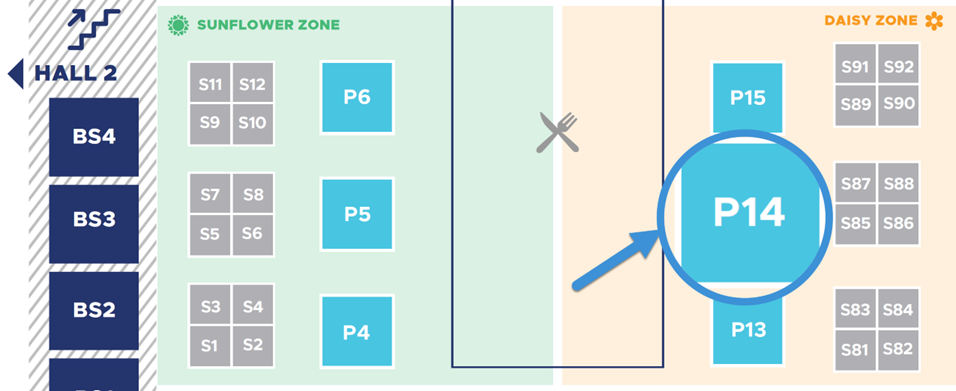

Journey to Infrastructure as Code
Thu, 23 Mar 2023 14:32:49 -0000
|Read Time: 0 minutes
Infrastructure as code (IaC) has become a key enabler of today’s highly automated software deployment processes. In this blog, let’s see how today’s fast growing IaC paradigms evolved from traditional programming.
On the surface IaC might just imply using coding languages to provision, configure, and manage infrastructure components. While the code in IaC itself looks very different, it is the way code works to manage the infrastructure that is more important. In this blog, let’s first look at how storage automation evolved over the last two decades to keep up with changing programming language preferences and modern architectural paradigms. And then more importantly differentiate and appreciate modern day declarative configurations and state management.
First came the CLI
The command line interface (CLI) was the first step to faster workflows for admins of almost any IT infrastructure or electronic machinery in general. In fact, a lot of early electronic interfaces for “high tech” machinery in 80s and 90s were available only as commands. There were multiple reasons for this. The range of functionality and the scope of use for general computer controlled machinery was pretty limited. The engineers who developed the interfaces were more often domain experts than software engineers, but they still had the responsibility of today’s full stack developers, so naturally the user experience revolved more around their own preferences. Nevertheless, because the range of functionality was well covered by the command set, the interfaces left very little to be desired in terms of operating the infrastructure.
By the time storage arrays became common in enterprise IT in the mid-90s (good read: brief history of EMC), the ‘storage admin’ role evolved. The UNIX heavy workflows of admins meant a solid CLI was the need of the hour, especially for power users managing large scale, mission critical data storage systems. The erstwhile (and nostalgic to admins of the era) SYMCLI of the legendary Symmetrix platform is a great example of storage management simplicity. In fact, the compactness of symcli of the legendary Symmetrix platform easily beats any of today’s scripting languages. It was so popular that it had to be continued for the modern day PowerMax architecture, just to provide the same user experience. Here is what a storage group snapshot command looks like:
symsnapvx -sid ### -nop -sg mydb_sg establish -name daily_snap -ttl -delta 3
Then came scripts (more graphical than GUI!)
In the 90s, when graphical user interfaces became the norm for personal computers, enterprise software still was lagging personal computing interfaces in usability, a trend that persists even today. For a storage admin who was managing large scale systems, the command line was (and is today) still preferred.
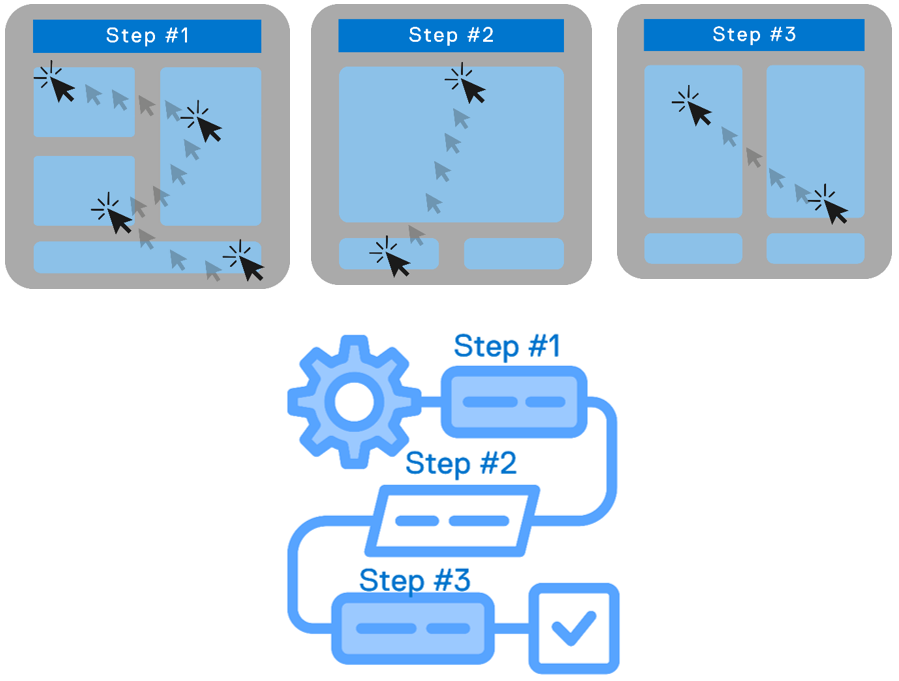
While it is counterintuitive, many times for a complex, multi-step workflow, code blocks make the workflow more readable than documenting steps in the form of GUI snapshots, mouse clicks, and menu selections.
Although typing and executing commands was inherently faster than mouse driven graphical user interfaces, the main advantage is that commands can be combined into a repeatable workflow. In fact, the first form of IT automation was the ability to execute a sequence of steps using something like a shell script or Perl. (Here's some proof that this was used as late as 2013. Old habits die hard, especially when they work!) A script of commands was also a great way to document workflows, enforce best practices, and avoid manual errors - all the things that were essential when your business depended on the data operations on the storage system. Scripting itself evolved as more programming features appeared, such as variables, conditional flow, and looping.
Software started eating the world, RESTfully
REST APIs are easily one of the most decisive architectural elements that enabled software to eat the world. Like many web-scale technologies, it also cascaded to everyday applications as an essential design pattern. Storage interfaces quickly evolved from legacy CLI driven interfaces to a REST API server, with its functionality served with well-organized and easily discoverable API end-points. This also meant that developers started building all kinds of middleware to plug infrastructure into complex DevOps and ITOps environments, and self-service environments for developers to consume infrastructure. In fact, today GUIs and CLIs for storage systems use the same REST API that is offered to developers. Purpose built libraries in popular programming environments were also API consumers. Let’s look at a couple of examples.

Python phenomenon
No other programming language has stayed as relevant as Python has, thanks to the vibrant community that has made it applicable to a wide range of domains. For many years in a row, Python was at the top of the chart in Stack Overflow surveys as the most popular language developers either were already using or planning to. With the run-away success of PyU4V library for PowerMax, Dell invested in building API-bound functionality in Python to bring infrastructure closer to the developer. You can find Python libraries for Dell PowerStore, PowerFlex, and PowerScale storage systems on GitHub.
Have you checked out PowerShell recently?
Of late, PowerShell by Microsoft has been less about “shell” and more about power! How so? Very well-defined command structure, a large ecosystem of third-party modules, and (yes) cross-platform support across Windows, Linux, and Mac - AND cross-cloud support! This PowerShell overview documentation for Google Cloud says it all. Once again, Dell and our wonderful community has been at work to develop PowerShell modules for Dell infrastructure. Here are some of the useful modules available in the PowerShell Gallery: PowerStore, PowerMax, OpenManage.
Finally: infrastructure as code
For infrastructure management, even with the decades of programming glory from COBOL, to Perl, to Python, code was still used to directly call infrastructure functions that were exposed as API calls, and it was easier to use commands that wrapped the API calls. There was nothing domain-centric about the programming languages that made infrastructure management more intuitive. None of the various programming constructs like variables and control flows were any different for infrastructure management. You had to think like a programmer and bring the IT infrastructure domain into the variables, conditionals, and loops. The time for infrastructure-domain-driven tools has been long due and it has finally come!
Ansible
Ansible, first released in 2013, was a great benefit in programming for the infrastructure domain. Ansible introduced constructs that map directly with the infrastructure setup and state (configuration): groups of tasks (organized into plays and playbooks) that need to be executed on a group of hosts that are defined by their “role” in the setup. You can define something as powerful and scalable like “Install this security path on all the hosts of this type (by role)”. It also has many desirable features such as
- Not requiring an agent
- The principle of idempotency, which ensures task execution subject to the actual configuration state that the code intends to achieve
- Templating to reuse playbooks
The Ansible ecosystem quickly grew so strong that you could launch any application with any infrastructure on any-prem/cloud. As the go-to-market lead for the early Ansible modules, I can say that Dell went all in on Ansible to cover every configurable piece of software and hardware infrastructure we made. (See links to all sixteen integrations here.) And here are a couple of good videos to see Ansible in action for Dell storage infrastructure: PowerScale example, PowerMax example.
Also, Ansible integrations from other ITOps platforms like ServiceNow help reuse existing workflow automation with minimal effort. Check out this PowerStore example.
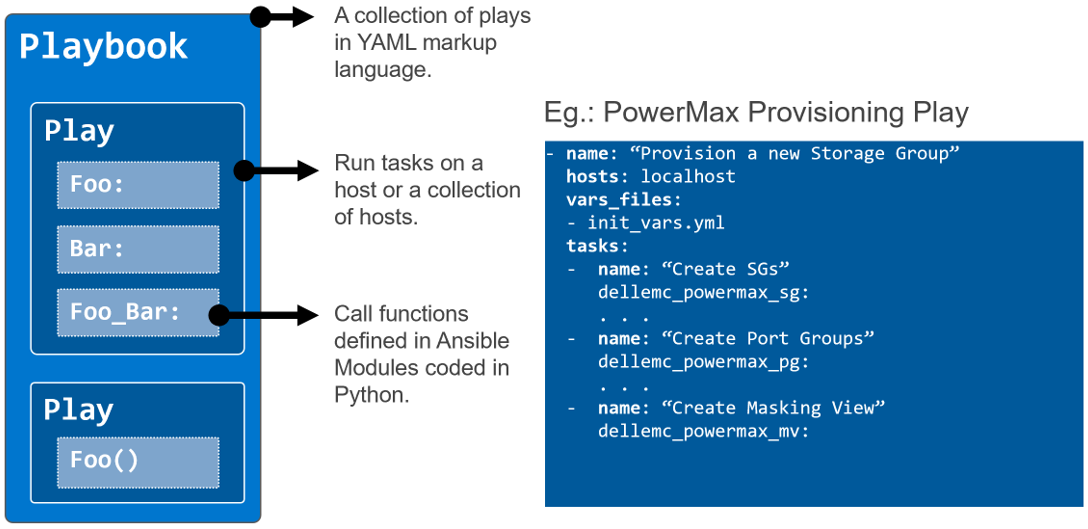
Terraform
Terraform by HashiCorp is another powerful IaC platform. It makes further in-roads into infrastructure configuration by introducing the concept of resources and the tight binding they have with the actual infrastructure components. Idempotency is implemented even more tightly. It’s multi-cloud ready and provides templating. It differs the most from other similar platforms in that it is purely “declarative” (declares the end state or configuration that the code aims to achieve) than “imperative” (just a sequence of commands/instructions to run). This means that the admin can focus on the various configuration elements and their state. It has to be noted that the execution order is less intuitive and therefore requires the user to enforce dependencies between different component configurations using “depends on” statements within resources. For example, to spin up a workload and associated storage, admins may need the storage provisioning step to be completed first before the host mapping happens.
And what does Dell have with Terraform?…We just announced the availability of version 1.0 of Terraform providers for PowerFlex and PowerStore platforms, and tech previews of providers for PowerMax and OpenManage Enterprise. I invite you to learn all about it and go through the demos here.

Author: Parasar Kodati

Announcing Terraform Providers for Dell Infrastructure
Mon, 20 Mar 2023 14:03:34 -0000
|Read Time: 0 minutes
HashiCorp’s Terraform enables DevOps organizations to provision, configure and modify infrastructure using human-readable configuration files or plans written in HashiCorp Configuration Language (HCL). Information required to configure various infrastructure components are provided within pre-built Terraform providers so that the end user can easily discover the infrastructure properties that can be used to effect configuration changes. The configuration files can be versioned, reused, and shared, enabling more consistent workflows for managing infrastructure. These configurations, when executed, change the state of the infrastructure to bring it to the desired state. The idempotency feature of Terraform ensures that only the necessary changes are made to the infrastructure to reach the desired state even when the same configuration is run multiple times, thereby avoiding unwanted drift of infrastructure state.
Today we are announcing the availability of the following Terraform providers for the Dell infrastructure portfolio:
- Version 1.0 of Terraform provider for PowerFlex
- Version 1.0 of Terraform provider for PowerStore
- Tech preview (beta) of Terraform provider for PowerMax
- Tech preview (beta) of Terraform provider for Open Manage Enterprise
Anatomy of a Terraform project
Code in Terraform files is organized as distinct code blocks and is declarative in style to declare the various components of infrastructure. This is very much in contrast with a sequence of steps to be executed in a typical imperative style programming or scripting language. In the simplest of terms, a declarative approach provides the end state or result rather than the step-by- step process. Here are the main elements used as building blocks to define various infrastructure components in a Terraform project:
- Provider: A provider is a plug-in that enables Terraform to interact with a particular type of infrastructure. For example, different Dell storage platforms like PowerFlex, PowerStore, and PowerMax have their own providers. Similarly, providers exist for all major environments like VMware, Kubernetes, and major public cloud services. Each provider has its own set of resources, data sources, and configuration options. Providers are defined in the provider block of Terraform configuration files.
- Resource: A resource is an object that represents an infrastructure component that needs to be created, modified, or deleted. In the case of storage platforms, the resources are volumes, volume groups, snapshots, and so on. More generally, resources can be virtual machines, Kubernetes nodes, databases, load balancers, or any other infrastructure component. Resources are defined in the resource block of Terraform configuration files. Each resource type has a specific set of configuration options that can be used to customize the resource. The table in the next section shows the resources that come with Terraform providers for Dell infrastructure products.
- Data source: A data source is an object that allows Terraform to retrieve information about an existing resource that has been created outside of Terraform. Data sources can be used to query information about resources that already exist in the infrastructure or have been created by a Terraform project. This is like the gather information section of Ansible playbooks. Data sources are defined in the data block of Terraform configuration files. The table in the next section shows the data sources that come with Terraform providers for Dell infrastructure products.
- Module: A module is a self-contained collection of Terraform resources, data sources, and variables that can be used across multiple Terraform projects. Modules make it easy to reference and reuse different infrastructure classes while making the project more modular and readable. Modules are defined in the module block of Terraform configuration files.
- Output: An output is a value that is generated by Terraform after the resources have been created. Outputs can be used to retrieve information about resources that were created during the Terraform run. Outputs are defined in the output block of Terraform configuration files.
These elements are organized into different .tf files in a way that is suitable for the project. However, as a norm, Terraform projects are organized with the following files in the project root directory or a module directory:
- main.tf: This file contains the main configuration for the resources to be created. It is the entry point for Terraform to process and execute the desired state for the infrastructure. This file includes the definition of the resources to be created and the configuration parameters to be used for each resource.
- versions.tf: All the required provider definitions for the project or module are organized into the versions.tf file. In addition to specifying the version of the provider, the file also specifies authentication details, endpoint URLs, and other provider-specific configuration details.
- variables.tf: As the name suggests, this file contains the declaration of input variables that are used throughout the Terraform project. Input variables allow users to dynamically configure the Terraform resources at runtime, without changing the code. This file also defines the default values, types, and descriptions for the input variables.
- outputs.tf: This file contains the definition of output values that are generated after the Terraform resources have been created. Output values can be used to provide useful information to the user or to pass on to other Terraform projects.
Terraform provider details
Following are the details of the resources and data sources that come with the different providers for Dell infrastructure:
| Resources | Data sources | |
|---|---|---|
PowerFlex |
|
|
PowerStore |
|
|
PowerMax |
|
|
OpenManage Enterprise |
|
|
Demos
We invite you to check out the following videos to get started!

Getting Started with Container Storage Interface (CSI) for Kubernetes Workloads
Fri, 27 Jan 2023 19:05:48 -0000
|Read Time: 0 minutes
What is CSI in Kubernetes?
When container deployment (a light-weight implementation of software deployment) started it was mostly used for stateless services that were running business logic without much data persistence. As more and more Stateful applications were being deployed, the storage interface to these applications needed to be well defined in native Kubernetes constructs. This need gave way to the CSI standard.
CSI stands for Container Storage Interface and is an industry-standard specification aimed at defining how storage providers can develop plugins that work across many container orchestration systems. For context, a common container orchestration system that highly utilizes CSI is Kubernetes. Kubernetes has had a GA (Generally Available) implementation of CSI since Kubernetes v1.13 was released in December 2018.
How does CSI work?
Part of the deployment declaration (manifest) of a containerized stateful service is to specify the type of storage that the application needs. This can be done in two ways: dynamic provisioning and manual provisioning:
- For dynamic provisioning, the POD (an application deployment unit) manifest points to a persistent volume claim object that references a Storage class defined by the CSI plugin of the specific storage type. This will automatically create and connect a persistent volume of the specified storage class.
- For manual provisioning, the manifest directly points to an existing persistent volume that is pre-created using the storage class definition.
Here is a figure that illustrates the two use cases: 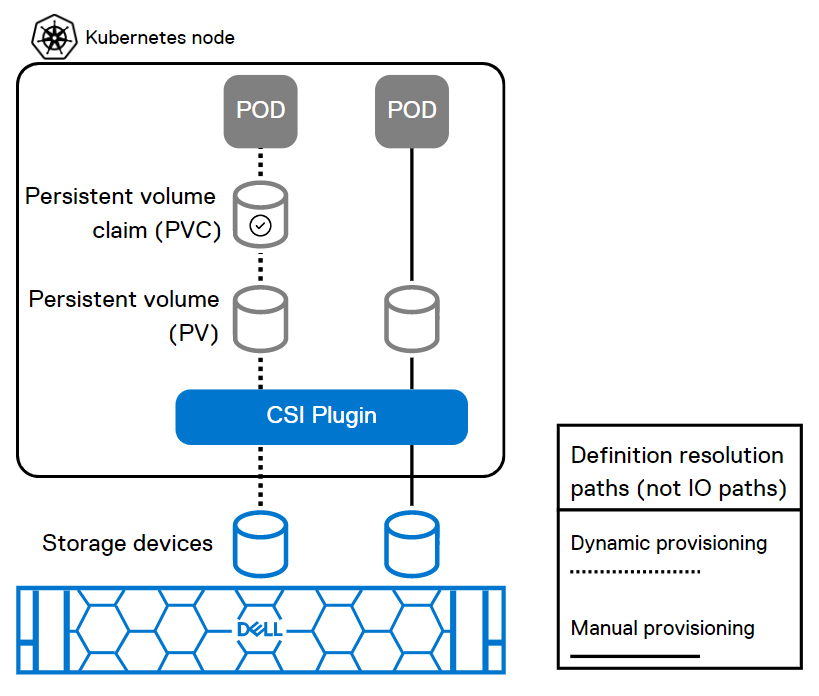
This figure shows how the POD deployment manifest resolves to the storage devices through CSI for dynamic and manual provisioning.
Key aspects of a CSI plugin
Aspect | Description |
Persistent Volume (PV) | A logical storage volume in Kubernetes that will be made available inside of a CO-managed container, using the CSI. |
Persistent Volume Claim (PVC) | PVCs are requests for storage resources such as the persistent volumes. |
Block Volume | A volume that will appear as a block device inside the container. |
Mounted Volume | A volume that will be mounted using the specified file system and appear as a directory inside the container. |
CO (Container Orchestration) | Container orchestration system communicates with plugins using CSI service RPCs (Remote Procedure Calls). |
SP | Storage Provider, the vendor of a CSI plugin implementation. |
RPC | |
Node | A host where the user workload will be running, uniquely identifiable from the perspective of a plugin by a node ID. |
Plugin | Aka “plugin implementation,” a gRPC endpoint that implements the CSI Services. |
Plugin Supervisor | A process that governs the lifecycle of a plugin, perhaps the CO. |
Workload | The atomic unit of "work" scheduled by a CO. This might be a container or a collection of containers. |
Resources
You can explore the following resources to learn more about this topic:
Demystifying CSI plug-in for PowerFlex (persistent volumes) with Red Hat OpenShift
How to Build a Custom Dell CSI Driver
Dell Ready Stack for Red Hat OpenShift Container Platform 4.6
Solution Brief - Red Hat OpenShift Container Platform 4.10 on Dell Infrastructure
Dell PowerStore with Azure Arc-enabled Data Services
Persistent Storage for Containerized Applications on Kubernetes with PowerMax SAN Storage
Amazon Elastic Kubernetes Service Anywhere on Dell PowerFlex
What is Container Storage Interface (CSI) and how does Dell use it?
Authors: Ryan Wallner and Parasar Kodati

Getting Started with REST API
Fri, 27 Jan 2023 18:41:52 -0000
|Read Time: 0 minutes
What is REST API?
REST stands for Representational State Transfer, and it is an architectural style for building APIs, or application programming interfaces. JSON stands for JavaScript Object Notation, a lightweight format for storing and transmitting data between a server and a client application. REST and JSON are popular technologies in building web APIs.
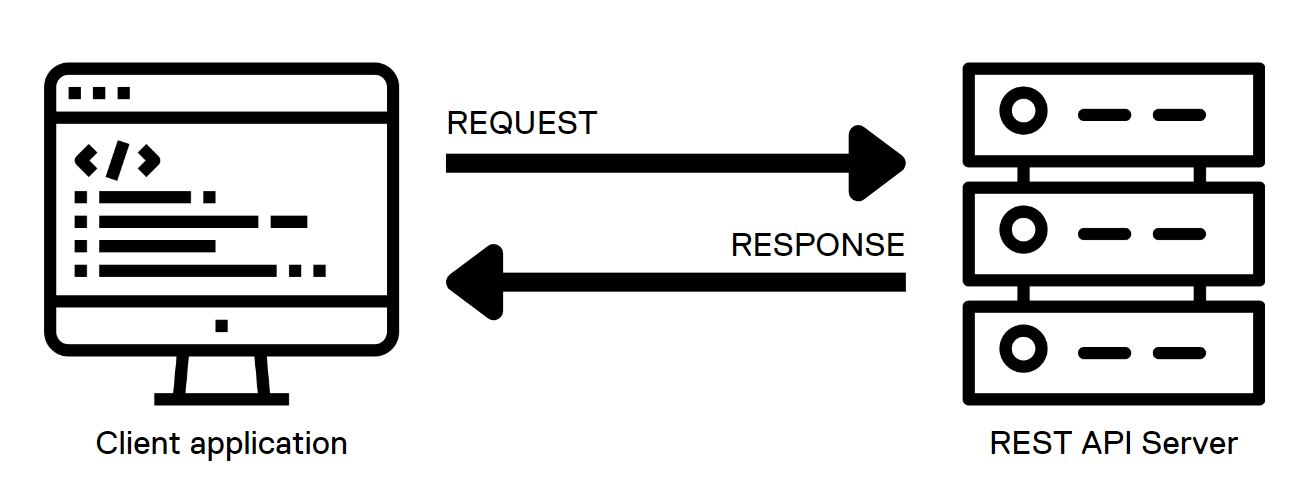 .
.
HTML methods in REST API calls
The server interface for a REST API is organized as resources that can be accessed through a uniform resource identifier (URI) to access resources and perform actions. HTTP methods like GET and PUT perform one of CRUD: CREATE, READ, UPDATE and DELETE operations on the resources.
REST API calls can be used from almost any modern programming language with the following HTTP methods to communicate with the web server:
- GET: the GET method is used to retrieve a resource from the server. It is heavily used for things like loading a dynamic web page. When used programmatically, the output of this method is captured in a variable of the programming language and then parsed to retrieve different components of the output.
- PUT: the PUT method is used to create or update an existing resource on the server. Note that the body of the request should contain the entire object structure of the resource. When the resource doesn’t exist, PUT creates a new resource.
- POST: the POST method is used to create a new resource on the server. The body of a POST request has all the details of the new record and is usually validated on the server side for expected type of data and completeness of the record. Note that the main difference between POST and PUT is that PUT requests are idempotent. That is, calling the same PUT request multiple times will always produce the same result. By contrast, calling a POST request repeatedly creates the same resource multiple times.
- DELETE: the DELETE method is used to delete a resource.
- PATCH: The PATCH method is used to apply partial modifications to a resource. Unlike PUT requests, PATCH requests apply a partial update to the resource.
JSON and the anatomy of a REST API call
In response to the API calls, the web service provides a response in JSON format. JSON is a lightweight, human-readable format for representing structured data. The response includes the status of the call, information requested, and any errors using specific codes. This response is further parsed and processed by the client application.
Here is how a simple GET request looks like when used on a shell CLI with the CURL command:
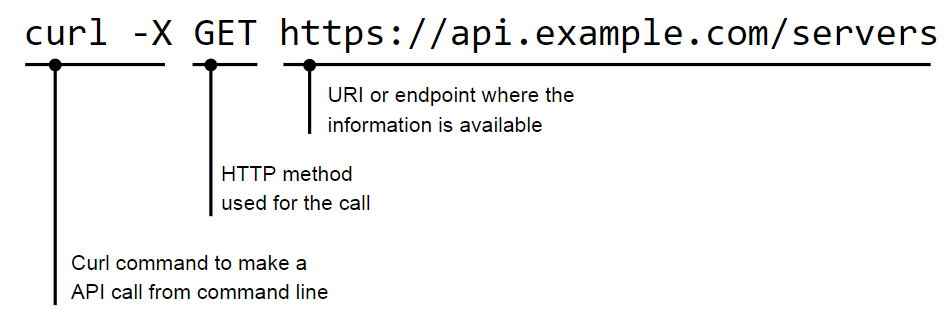
The JSON response to a call is provided in a <name>:<value> format:
"servers": [
{
"id": 123,
"name": "alice"
},
{
"id": 456,
"name": "bob"
}
]
}JSON supports nested structures, which allow an object or array to contain other objects and arrays. For example, consider the following JSON data:
{
"name": "John Doe",
"age": 35,
"address": {
"street": "123 Main St",
"city": "New York",
"state": "NY"
},
"phoneNumbers": [
{
"type": "home",
"number": "212-555-1212"
},
{
"type": "office",
"number": "646-555-1212"
}
]
}HTTP return codes
In a REST API, HTTP status codes indicate the outcome of an API request. Here are some common HTTP status codes that a REST API might return, along with their meanings and suggestions for how a client application could handle them:
- 200 OK: The request was successful! The response body contains the requested data. The client can continue to process the response as normal.
- 201 Created: The request resulted in the creation of a new resource. The response body may contain the newly created resource; the Location header of the response will contain the URL of the new resource. The client should store this URL for future reference.
- 204 No Content: The request was successful, but the response body is empty. The client should continue processing as normal, but should not try to parse the response body.
- 400 Bad Request: The request was not valid, for example because it contained invalid parameters or was missing required data. The response body may contain more detailed error information. The client should check the error details and adjust the request as needed before trying again.
- 401 Unauthorized: The request requires the client to authenticate itself, but the client did not provide a valid authentication token. The client should prompt the user for their credentials and try the request again with a valid authentication token.
- 404 Not Found: The requested resource does not exist. The client should check that the URL of the request is correct and adjust it if necessary before trying again.
- 500 Internal Server Error: The server encountered an unexpected error while processing the request. The client should try the request again at a later time, because the issue may be temporary.
Client applications must handle these different HTTP status codes properly to provide a good user experience. For example, if a client receives a 404 Not Found error, it could display a message to the user indicating that the requested resource was not found, rather than just displaying an empty screen.
Authentication
There are several popular authentication mechanisms for REST APIs, including:
1. Basic authentication: This simple authentication scheme uses a username and password to authenticate a user. The username and password are typically sent in the request header.
curl -X GET 'https://api.example.com/server' \ -H 'Content-Type: application/json' \ -H 'Authorization: Basic dXNlcm5hbWU6cGFzc3dvcmQ='
In this example, the Authorization header is set to Basic dXNlcm5hbWU6cGFzc3dvcmQ=, where dXNlcm5hbWU6cGFzc3dvcmQ= is the base64-encoded representation of the string username:password.
2. Token-based authentication: In this scheme, the client exchanges a username and password for a token. The token is then included in subsequent requests to authenticate the user.
curl -X GET 'https://api.example.com/users' \ -H 'Content-Type: application/json' \ -H 'Authorization: Bearer abc123'
In this example, the Authorization header is set to Bearer abc123, where abc123 is the token that was issued to the client.
3. OAuth: This open-standard authorization framework provides a way for users to authorize access to APIs securely. OAuth involves a client, a resource server, and an authorization server.
4. OpenID Connect: This is a protocol built on top of OAuth 2.0 that provides a way to authenticate users using a third-party service, such as Google or Facebook.
Resources
The Dell Technologies infrastructure portfolio has extensive APIs covering all IT infrastructure operations. You can learn more about the API implementation of the different Dell infrastructure products on the Info Hub:
- PowerStore REST API: Using Filtering to Fine Tune Your Queries
- REST API examples for PowerMax snapshot operations
- REST - The Power of Network Automation Using REST APIs
- ECS Management REST API: Postman Collection
- VxRail API—Updated List of Useful Public Resources
- What’s New in PowerMax REST API 10.0
You can also explore Dell infrastructure APIs by visiting the API documentation portal: https://developer.dell.com/apis.
Authors: Florian Coulombel and Parasar Kodati

Getting Started with Integrated Dell Remote Access Controller (iDRAC)
Fri, 27 Jan 2023 16:53:49 -0000
|Read Time: 0 minutes
Integrated Dell Remote Access Controller (iDRAC) is a baseboard management controller (BMC) built into Dell PowerEdge servers. iDRAC allows IT administrators to monitor, manage, update, troubleshoot, and remediate Dell servers from any location without the use of agents and out-of-band. It consists of both hardware and software that provides extensive features compared to a basic baseboard management controller.
Key features of iDRAC
iDRAC is designed to make you more productive as a system administrator and improve the overall availability of Dell servers. iDRAC alerts you to system issues, helps you to perform remote management, and reduces the need for physical access to the system.
Ease of use
- Remote management: Server management can be performed remotely, reducing the need for an administrator to physically visit the server. By providing secure access to remote servers, administrators can perform critical management functions while maintaining server and network security. This remote capability is essential to keeping distributed and scaled-out IT environments running smoothly. Using the GUI, an administrator can perform firmware maintenance and configuration of BIOS, iDRAC, RAID, and NICs; deploy operating systems; and install drivers.
- Agent-free monitoring: iDRAC is not dependent on the host operating system and does not spend CPU cycles on agent execution, intensive inventory collection, and so on.
- Thermal management: iDRAC’s Thermal Manage feature provides key thermal telemetry and associated controls that allow customers to monitor the thermal radiation dynamics and run their environment efficiently.
- Virtual power cycle: With servers increasingly being managed remotely, a means of performing the virtual equivalent of pulling out the power cord and pushing it back in is a necessary capability to occasionally ”unstick” the operating system. With the PowerEdge iDRAC9 virtual power cycle feature, IT admins have access to console or agent-based routines to restore or reset power states in minutes rather than hours.
Security features
iDRAC offers security features that adhere to and are certified against well-known NIST, Common Criteria, and FIPS-140-2 standards.
- Automatic certificate renewal and enrollment: This feature makes it easy for users to secure network connections using TLS/SSL certificates. The iDRAC web server has a self-signed TLS/SSL certificate by default. The self-signed certificate can be replaced with a custom certificate, a custom signing certificate, or a certificate signed by a well-known certificate authority (CA). Automated certificate upload can be accomplished by using Redfish scripts. iDRAC9 automatic certificate enrollment and renewal automatically ensures that SSL/TLS certificates are in place and up to date for both bare-metal and previously installed systems. Automatic certificate enrollment and renewal requires the iDRAC9 Datacenter license.
- Secure supply chain: The iDRAC boot process uses its own independent silicon-based Root of Trust that verifies the iDRAC firmware image. The iDRAC Root of Trust also provides a critical trust anchor for authenticating the signatures of Dell firmware update packages (DUPs).
- Authentication: iDRAC offers a simple two-factor authentication option to enhance login security for local users. RSA SecurID can be used as another means of authenticating a user on a system.
Scalable data analytics with telemetry streaming
Using analytics tools, IT managers can more proactively manage systems by analyzing trends and discovering relationships between seemingly unrelated events and operations. iDRAC9 telemetry streaming with over 180 metrics/sensors can provide data on server status with no performance impact on the main server. Telemetry streaming’s big performance advantage is in reducing the overhead needed to get the complete data stream from a remote device. Advantages of iDRAC telemetry streaming include:
- Better scalability: Polling requires a lot of scripting work and CPU cycles to aggregate data and suffers from scaling issues when we are talking about hundreds or thousands of servers. Streaming data, in contrast, can be pushed directly into popular analytics tools such as Prometheus, ELK stack, InfluxDB, and Splunk without the overhead and network loading associated polling.
- More accuracy: Polling can also lead to data loss or “gaps” in sampling for time series analysis; it is usually only a snapshot of current states, not the complete picture over time. You might miss critical peaks or excursions in data.
- Less delay: Data can be severely delayed in time due to needing multiple commands to get a complete set of data and the inability to poll simultaneously from a central management host. Streaming more accurately preserves the time-series context of data samples.
Resources
You can explore the following resources to learn more about iDRAC. Also, you can see for yourself the capabilities of PowerEdge iDRAC in our virtual lab setting.
Tech notes
- Telemetry streaming
- Thermal management
- Improved iDRAC9 Security using TLS 1.3 over HTTPS
- iDRAC9 Virtual Power Cycle
- iDRAC9 System Lockdown: Preventing Unintended Server Changes
- Automatic SSL/TLS certificate enrollment
Benchmark studies by industry analysts
- Deployment with zero touch provisioning
- Automated renewal of SSL certificates
- Telemetry streaming
- Splunk integration with iDRAC telemetry
Videos
- Large scale iDRAC telemetry and integration with Splunk
- Advanced Thermal Management with iDRAC9
- Automatic Certificate Enrollment with iDRAC9
- System lockdown to prevent unwanted drift in server configurations
Other resources:
- Explainer video covering what’s new in the GUI of iDRAC9 v4.0
- Deep dive demo of Server Configuration Profile feature of iDRAC9
- Deep-dive webinar on Telemetry Streaming feature for large-scale server management






